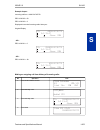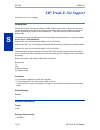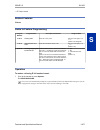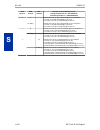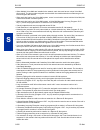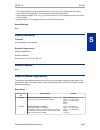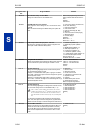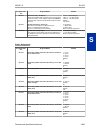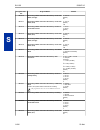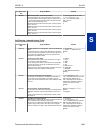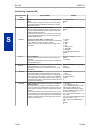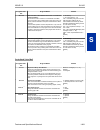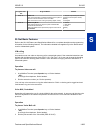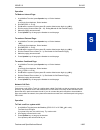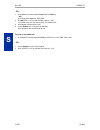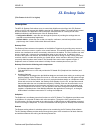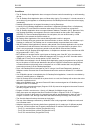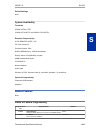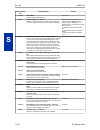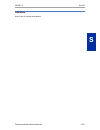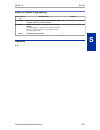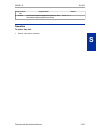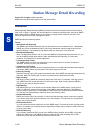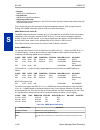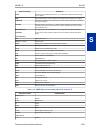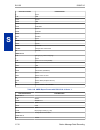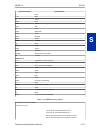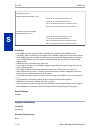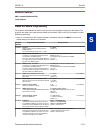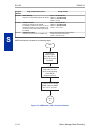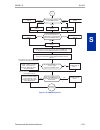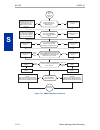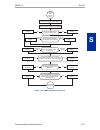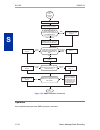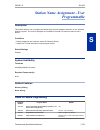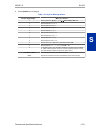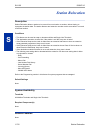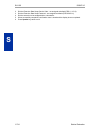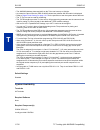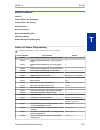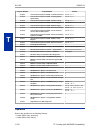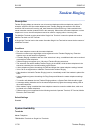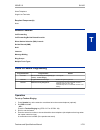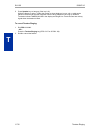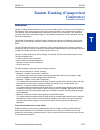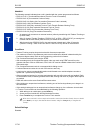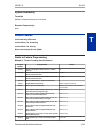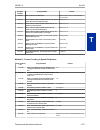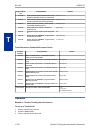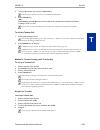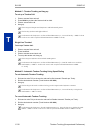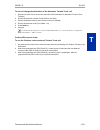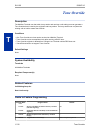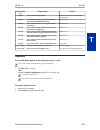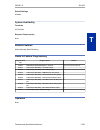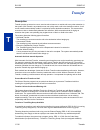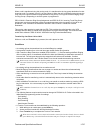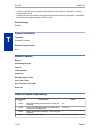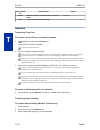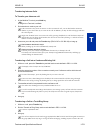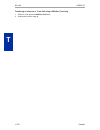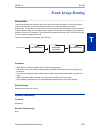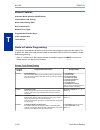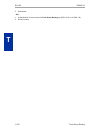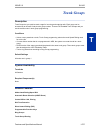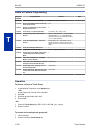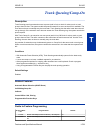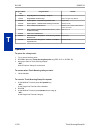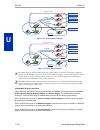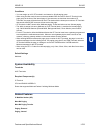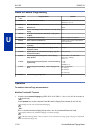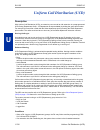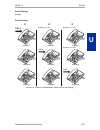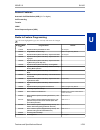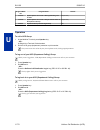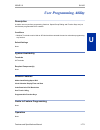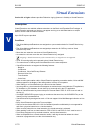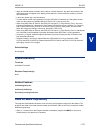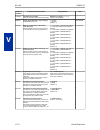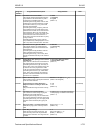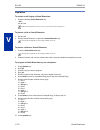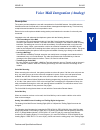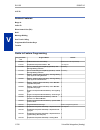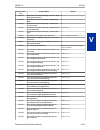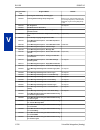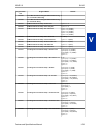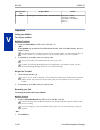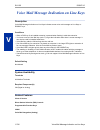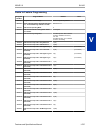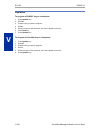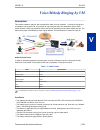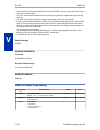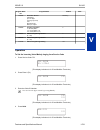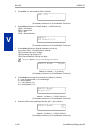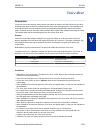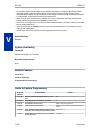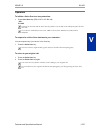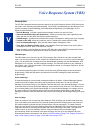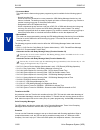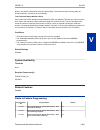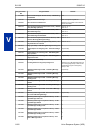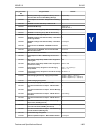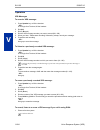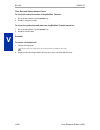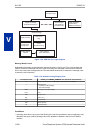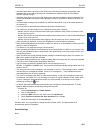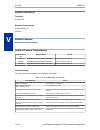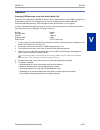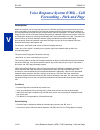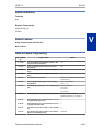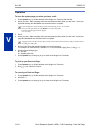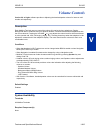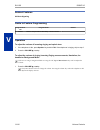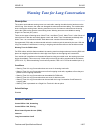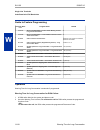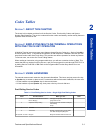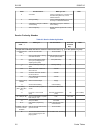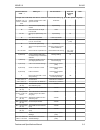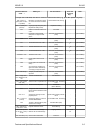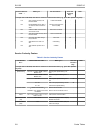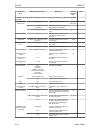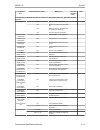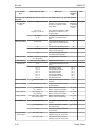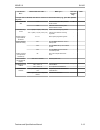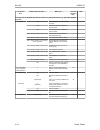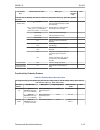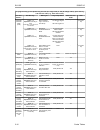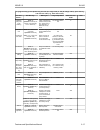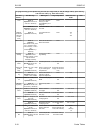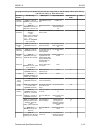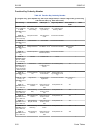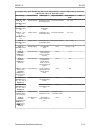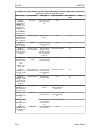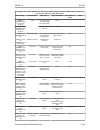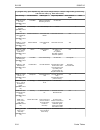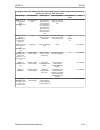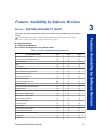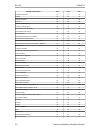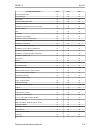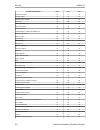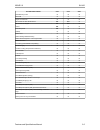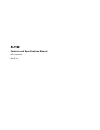- DL manuals
- NEC
- Wireless Router
- SL1100
- Features And Specifications Manual
NEC SL1100 Features And Specifications Manual
Notice
Note that when converting this document from its original format to a
.pdf file, some minor font and format changes may occur. When
viewing and printing this document, we cannot guarantee that your
specific PC or printer will support all of the fonts or graphics.
Therefore, when you view the document, fonts may be substituted and
your individual printer may not have the capability to print the
document correctly.
Summary of SL1100
Page 1
Notice note that when converting this document from its original format to a .Pdf file, some minor font and format changes may occur. When viewing and printing this document, we cannot guarantee that your specific pc or printer will support all of the fonts or graphics. Therefore, when you view the ...
Page 3
Features and specifications manual a50-031169-003 na issue 2.0
Page 4: Copyright
Copyright nec corporation reserves the right to change the specifications, functions, or features at any time without notice. Nec corporation has prepared this document for use by its employees and customers. The information contained herein is the property of nec corporation and shall not be reprod...
Page 5: Table of Contents
Table of contents chapter 1 features section 1 about this chapter................................................................................... 1-1 section 2 important notes......................................................................................... 1-1 abbreviated dialing/speed di...
Page 6
Department step calling......................................................................................... 1-201 dhcp client............................................................................................................ 1-203 dial pad confirmation tone................................
Page 7
Ip multiline (sip) - ml440....................................................................................... 1-431 ip single line terminal (sip).................................................................................. 1-441 ip trunk - (sip) session initiation protocol.....................
Page 8: Chapter 2 Codes Tables
Selectable ring tones............................................................................................ 1-664 serial call................................................................................................................ 1-666 single line terminals................................
Page 9: List of Tables
List of tables table 1-1 keys for entering names................................................................................... 1-9 table 1-2 forced account codes.................................................................................... 1-13 table 1-3 sample alarm report..................
Page 10
Table 1-52 caller id sent to mobile telephone............................................................. 1-514 table 1-53 keys for entering names............................................................................. 1-531 table 1-54 movement on screen from menu.................................
Page 11: List of Figures
List of figures figure 1-1 right cursor key operation flow chart........................................................... 1-4 figure 1-2 left cursor key operation flow chart......................................................... 1-120 figure 1-3 walking code restriction.............................
Page 12
Figure 1-52 smdr flowchart (continued)..................................................................... 1-717 figure 1-53 smdr flowchart (continued)..................................................................... 1-718 figure 1-54 multicast mode example.........................................
Page 13: Features
Features s ection 1 about this chapter this chapter provides an alphabetical listing of the features that are available with the sl1100 system. Each feature provides the following information: description - briefly describes the feature and how it is used. Conditions - provides special operating con...
Page 14
Port assignments port calculation for trunks: the system detects the type of unit (trunk or extension) and assigns the required extension or trunk ports to the slot. The system will use the next available port numbers - it will not reserve any. Sl1100 issue 2.0 1-2 features.
Page 15
Abbreviated dialing/speed dial description abbreviated dialing/speed dial gives an extension user quick access to frequently called numbers. This saves time, for example, when calling a client with whom they deal often. Instead of dialing a long telephone number, the extension user just dials the sp...
Page 16
Cursor key operation (when set prg 15-02-60:0) by pressing the right cursor key, the user can access all directory menus. The flow chart below shows the menu access sequence (refer to figure 1-1 right cursor key operation flow chart on page 1-4 ). If the terminal is not allowed access to speed dial ...
Page 17
System availability terminals all terminals required component(s) none related features account code entry automatic route selection (ars/f-route) central office calls, placing code restriction/toll restriction dial tone detection one-touch calling pbx compatibility/behind pbx programmable function ...
Page 18
Program number program name/description assigned data 13-01-03 number of common speed dialing bins assign the number of speed dial bins that are used for the system speed dials. All speed dial bins (000 ~ 999) are shared for system and group speed dialing. If all bins are assigned to system speed di...
Page 19
Program number program name/description assigned data 13-02-01 * group speed dialing bins for each speed dial group assigned in prg 13-03, assign the range of speed dial bins that is to be used. All speed dial bins (000 ~ 999) are shared for system and group speed dialing. If all bins are assigned t...
Page 20
Program number program name/description assigned data 15-14-01 programmable one touch keys - number if prg 15-02-60 is set to a (0) then the stations personal speed dial entries are programmed here. Per key number (1 ~ 10) assign the telephone number that is to be called when the bin is accessed. Ma...
Page 22
To store a speed dialing number under a programmable function key: 1. At multiline terminal, press speaker key. 2. Dial 751. 3. Press the key where the number is to be stored. 4. Dial 27 (system speed dial), dial 28 (group speed dial). 5. Dial speed dial bin number to put under the key. 6. Press spe...
Page 23
4. Press exit key to return to idle condition. 1. On-hook condition. 2. Press down cursor key and press 1 st character you want to search. 3. Press up cursor key or down cursor key to select the destination name. 4. Press enter cursor key to confirm a name and number. 5. Press exit key to return to ...
Page 24
3. Dial the station speed dial buffer number to be programmed (0~9). 1 = station speed dial buffer 1 2 = station speed dial buffer 2 3 = station speed dial buffer 3 4 = station speed dial buffer 4 5 = station speed dial buffer 5 6 = station speed dial buffer 6 7 = station speed dial buffer 7 8 = sta...
Page 25
Account code forced/verified/unverified description account codes are user-dialed codes that help the system administrator categorize and/or restrict trunk calls. The system has two types of forced account codes: • forced account codes (unverified) forced account codes requirean extension user to en...
Page 26
Making note of the digits that dial out. When hidden, the account code digits show as * on the telephone display. Account code capacity account codes print along with the other call data on the smdr record after the call completes. Account codes can have 1~16 digits using 0~9 and #. Verified account...
Page 27
Related features abbreviated dialing/speed dial automatic route selection (ars/f-route) pbx compatibility/behind pbx station message detail recording guide to feature programming the programs listed below indicate the most commonly used programs required for this feature. The programs are listed in ...
Page 28
Program number program name/description assigned data 15-07-01 programmable function keys this program is used on a per station basis to assign different function keys to the multiline terminals. Function key (50) is the account code key. This key is pressed when the user wants to start entering the...
Page 29
5. Dial the number you want to call. To dial an outside number and let your system tell you when a forced account code is required: 1. Access a trunk and dial the number you want to call. 2. Wait for your call to go through. - or - 3. If you hear “please enter an account code,”(depending on system p...
Page 30: Account Code Entry
Account code entry description account codes are user-dialed codes that help the system administrator categorize and/or restrict trunk calls. Optional account codes allow a user to enter an account code while placing a trunk call or anytime while on a call. The system does not require the user to en...
Page 31
System availability terminals all terminals required component(s) none related features abbreviated dialing/speed dial automatic route selection (ars/f-route) one-touch calling pbx compatibility/behind pbx station message detail recording guide to feature programming the programs listed below indica...
Page 32
Program number program name/description assigned data 35-05-04 hiding account codes per class of service (prg 20-06-01) this program is used to either hide or show the account code entered on the users display. When set to hide the account code the users display will show a * for every digit dialed ...
Page 33
4. Dial * . - or - press your account code key (prg 15-07 or sc 751: code 50). 5. Dial the number you want to call. To enter an account code for an incoming call: this procedure is not available for single line terminals. 1. Answer incoming call. If account codes for incoming calls is disabled, the ...
Page 34: Alarm
Alarm description alarm lets any station extension work like an alarm clock. An extension user can have alarm remind them of a meeting or an appointment. There are two types of alarms: • alarm 1 (sounds only once at the preset time) • alarm 2 (sounds every day at the preset time) conditions • single...
Page 35
Operation to set the alarm: 1. At the multiline terminal, press speaker key. - or - at the single line terminal, lift the handset. 2. Dial 727. 3. Dial alarm type (1 or 2). Alarm 1 sound only once. Alarm 2 sounds each day at the preset time. 4. Dial the alarm time (24-hour clock). For example, for 1...
Page 36: Alarm Reports
Alarm reports version 2.0 or higher software provides; • enable to send the alarm report by e-mail to smtp client • enable to send the dimlast data, dimdump data from the system automatically description the system logs various errors and reports information about the operation that can be used to d...
Page 37
05/16/2006 14:30 page 001 lvl no stat date time item unit slt prt parameter min 0002 rec 05/16/06 14:37 pkg installation vms 08 00 min 0002 err 05/16/06 14:38 pkg installation vms 08 00 min 0002 rec 05/16/06 14:40 pkg installation prt 07 00 min 0002 err 05/16/06 14:40 pkg installation prt 07 00 maj ...
Page 38
System information the system can print a report of the units installed, the port assignments, and the port types. This information is sent to the extension defined in prg 90-13. The system information reports indicate: • date and time of the report • unit names • slot condition (working, blocked) •...
Page 39
System information date slot location type assign port condition note coiu 17–20 running slot 9 : information of exife2 (408m : sub slot (coi)) hbiu 25–32 running slot 9 : information of exife2 (408m : sub slot (hbi)) -none- -none- not install slot 9 : information of exife2 (408m : sub slot 2 (hbi))...
Page 40
• up to 12 system alarm times can be scheduled to print on a monthly, daily, and hourly time frame. The report indicates both major and minor alarms. • system information reports cannot be set to output at a scheduled time. • when using the e-mail functionality of reports, the e-mail address in prg ...
Page 41
System availability terminals all multiline terminals required component(s) inmail compact flash card - ip4ww-cfvms-c1, ip4ww-cfvml-c1 related features none guide to feature programming setting up alarms: program num- ber program name default 90-10-01 system alarm setup - alarm type 0 90-10-02 syste...
Page 42
Program number program name default note 10-12-02 cpu network setup - subnet mask 255.255.255.0 10-12-03 cpu network setup - default gateway 0.0.0.0 90-11-02 system alarm report - report method 0 90-11-06 system alarm report - smtp host name no setting 90-11-07 system alarm report - smtp host port n...
Page 43
Inmail pop3 setup: (v2.0 added) program number program name description/comments assigned data 47-19-01 inmail pop3 setup - server name set the pop3 server name. If the dns server setting is not assigned in program 90-11-11 the ip address must be used in- stead of the name. Up to 48 characters (defa...
Page 44: Alphanumeric Display
Alphanumeric display description display multiline terminals have a 3-line, 24 character-per-line alphanumeric display that provides various feature status messages. These messages help the display telephone user process calls, identify callers and customize features. Conditions • when the telephone...
Page 45
Program num- ber program name default 20-11-08 class of service options (hold/transfer service) - transfer information display cos 01~15 = 1 operation operation is automatic if enabled in programming. Issue 2.0 sl1100 features and specifications manual 1-33 a.
Page 46
Analog communications interface (aci) description the analog communications interface (aci) feature uses analog ports (with associated relays) for music on hold, external paging, and back ground music (bgm). External paging, external moh and bgm each 084m-b1 units have 2 audio in and 1 audio out jac...
Page 47
Required component(s) none related features background music hotline one-touch calling paging, external door box music on hold guide to feature programming program number program name default note 10-60-01 audio port setup - slot no. 0 10-61-01 relay type 0 = no setting 1 = external moh 2 = bgm reso...
Page 48: Ancillary Device Connection
Ancillary device connection description ancillary device connection allows installation of selected peripheral (ancillary) devices to a multiline terminal. This feature enhances peripheral device objectives. Allows a sl1100 multiline terminal user to connect ancillary devices such as wireless headse...
Page 49: Answer Hold/automatic Hold
Answer hold/automatic hold description answer hold/automatic hold allows a multiline terminal user to press the flashing line key to answer an incoming ringing call or a camp-on call. When the multiline terminal user is already answering a call, the first call is automatically placed on hold, depend...
Page 50
Program num- ber program name default 15-02-07 automatic hold for co lines 1 15-07-01 programmable function keys refer to programming manual. 11-12-32 service code setup (for service access) - answer for park hold * 6 20-09-01 class of service options (incoming call service) - second call for did/di...
Page 51: Attendant Call Queuing
Attendant call queuing description attendant extensions can have up to 32 incoming calls queued before additional callers hear busy tone. This helps minimize call congestion in systems that use the attendant as the overflow destination for unanswered calls. For example, you can program direct inward...
Page 52
Guide to feature programming program num- ber program name default 11-01-01 system numbering - service code refer to programming manual. 20-01-01 system options - operator access mode 0 20-09-07 class of service options (incoming call service) - call queuing cos 01~15 = 1 20-17-01 operator extension...
Page 53
Automatic call distribution (acd) (this feature is for v1.5 or higher) description automatic call distribution (acd) uniformly distributes calls among agents of a programmed acd group. When a call rings into an acd group, the system automatically routes the call to the agent that has been idle the l...
Page 54
You can assign an acd group to play the queue depth only when using the vrs for message. The queue depth can be played after the 1st announcement only, 2nd announcement only, or after both announcements. Vrs delay announcements using inmail inmail can provide acd delay announcements. Any of the 32 (...
Page 55
Can place intercom calls or receive direct incoming calls while in rest mode. The ability to receive incoming intercom calls is defined in system programming for each acd group. Work time work time temporarily busies-out an acd agent’s telephone so they can work at their desk uninterrupted. This giv...
Page 56
• the trunk that has been waiting the longest, and how long it has been waiting. 2 line-001 01:30 the number of calls in queue. Name of trunk that has been queued the longest. How long the longest queued call has been waiting. For each acd group, you can set the following conditions: • the number of...
Page 57
• the queue status display is not shown and the queue alarm is not heard by acd agents in off-duty mode. • to scroll through the acd groups queue status, the queue status display programmable function key must be used. You cannot scroll when the queue status display is displayed due to an alarm. • i...
Page 58
• if an acd agent places an acd call on hold to answer an incoming non-acd call (trunk or station), when the non-acd call is terminated, the system will offer another acd call to the agent. If the second acd call is not desired, it is recommended to go into break or wrap mode before finishing the no...
Page 59
Program num- ber program name default 11-13-03 service code setup (for acd) - set acd wrap-up time (for slt) assign for single line telephones. 656 11-13-04 service code setup (for acd) - cancel acd wrap-up time (for slt) assign for single line telephones. 657 11-13-05 service code setup (for acd) -...
Page 60
Program num- ber program name default 41-05-01 acd agent work schedules set up the work schedules for acd agents and groups. For each acd work schedule (1 ~ 4), designate the start and stop times for each of the eight work periods. After the schedules are set up in this program, assign them to days ...
Page 61
Program num- ber program name default 41-08-06 acd overflow options - incoming ring group when overflow assign the ring group for acd overflow calls to go to. 1 ~ 100 (used when 41-08-02 is set to 6) (default = 1) 41-09-01 acd overflow table setting define the acd group to which a call is transferre...
Page 62
Program num- ber program name default 41-14-03 acd options setup - acd priority for overflow calls this option determines whether the acd group should use its own priority assignment or if it should follow the priority assigned in program 41-03-03. 0 = own group priority 1 = priority order by progra...
Page 63
Program num- ber program name default 41-19-06 acd voice mail delay announcement - wait tone type at message interval assign what the caller hears between the messages. 0 = ring back tone 1 = music on hold tone 2 = background music source (default = 0) 41-19-07 acd voice mail delay announcement - ac...
Page 64
Program num- ber program name default 92-06-03 fill command - destination number (to) each extension port = 001 ~ 084 (program 11-02) each virtual extension port = 01 ~ 50 (pro- gram 11-04) each extension group = 1 ~ 32 (program 11-07) each acd group = 1 ~ 2 92-07-01 delete command - destination num...
Page 65
Ml440 terminal 1. Press the acd log in/log out key (program 15-07-01 or sc 752: * 10) the acd log in/log out key lights. To log out multiline terminal 1. Press the acd log in/log out key (program 15-07-01 or sc 752: * 10). 2. Display shows: acd logout? (1: yes, 0: no) enter 1 to log out. The acd log...
Page 66
When logged out of acd group when acd agents are logged out and a call is placed in the acd queue, the telephone of the logged out agents displays the queue status and they hear the alarm according to the settings defined in system programming. Pressing the queue status display programmable function...
Page 67: Automatic Release
Automatic release description automatic release drops the line circuit when an outside party abandons the call. For this feature to work with loop start trunks, the co/pbx providing the outside line must provide a timed disconnect signal. Automatic release is normally provided on ground start trunks...
Page 68
Program num- ber program name default 80-04-01 call progress tone detector setup - detection level type 1 (dt) = 0 (-25dbm) type 2 (bt) = 0 (-25dbm) type 3 (rbt) = 0 (-25dbm) type 4 = 0 type 5 = 0 80-04-02 call progress tone detector setup - min. Detection lev- el type 1 (dt) = 15 (-25dbm) type 2 (b...
Page 69
Automatic route selection (ars/f-route) description automatic route selection (ars/f-route) provides call routing and call restriction based on the digits a user dials. Ars gives the system the most cost-effective use of the connected long distance carriers. Ars is an on-line call routing program th...
Page 70
Keys on their telephone which allow incoming access only. The user has only outgoing access on the co lines when using ars to place a call. Class of service matching with the ars class of service match access feature, you can determine whether the system should allow a call based on the cos assigned...
Page 71
With prg 26-01-06: ars cos match access enabled (set to 1): • if at 9:00 am, each extension dialed 9+(203)926-5400 extension 301 would use trunk group 1 extension 302 would use trunk group 2 extension 401, 402 would use trunk group 3 • if at 9:00 am, each extension dialed 9+(214)262-2000 extension 3...
Page 72
System availability terminals none required component(s) none related features abbreviated dialing/speed dial central office calls, placing code restriction/toll restriction dial tone detection trunk group routing trunk queuing/camp on guide to feature programming the programs listed below indicate ...
Page 73
Program number program name/description assigned data 26-01-01 * automatic route selection service - ars service this setting is used to enable/disable ars routing. 0 = disabled (ars service is off.) 1 = enabled (ars service is on.) (default = 0) 26-02-01 * dial analysis table for ars define the dia...
Page 74
Ars with f-route routing program number program name/description assigned data 11-01-01 system numbering this is the access code that users will dial to access ars. The trunk access code used to access the ars routing must be set to type 3 (trunk access code). 0 = not assigned 1 = service code 2 = e...
Page 75
Program number program name/description assigned data 26-03-01 ars dial treatments if prg 26-02-05 defined a dial treatment table, this program is where you define what digits are added or deleted to the number dialed. Common examples: add a 9 in front of all calls to bury the centrex 9 = d019re. Ad...
Page 76
Program number program name/description assigned data 26-01-06 * ars class of service match access this enables/disables the ars class of service settings. 0 = disabled (ars cos service is off.) 1 = enabled (ars cos service is on.) (default = 0) 26-01-07 f-route access class of service reference if ...
Page 77
Program number program name/description assigned data 26-03-01 ars dial treatments if prg 26-02-05 defined a dial treatment table, this program is where you define what digits are added or deleted to the number dialed. Common examples: add a 9 in front of all calls to bury the centrex 9 = d019re. Ad...
Page 78
Operation to place a call using ars: 1. At the multiline terminal, press speaker key. - or - at the single line terminal, lift the handset. You hear normal intercom dial tone. 2. Dial 9. You hear a second, “stutter” dial tone. 3. Dial the outside number. If you hear another “stutter” dial tone, you ...
Page 79: Background Music
Background music description background music (bgm) sends music from a customer-provided music source to the speakers of the multiline terminal when the station is idle. Each 084m-b1 unit has 2 audio in jacks on board and j431 (bgm) is used for bgm. As system can have 1 bgm input, effective bgm port...
Page 80
Program number program name/description assigned data 10-60-01 audio port setup - slot number (0,1,4,7) audio port number 1 = bgm audio port number 2 = external moh select which audio port on the 084m packages are used for bgm/ external moh. 0 = no used 1 = 1st ksu 4 = 2nd ksu 7 = 3rd ksu (default =...
Page 81: Barge-In
Barge-in description barge-in permits an extension user to break into another extension user’s established call, including conference calls. This sets up a conference-type conversation between the intruding extension and the parties on the initial call. With barge-in, an extension user can get a mes...
Page 82
Required component(s) none related features call monitoring conference hold intercom off-hook signaling park programmable function keys guide to feature programming program num- ber program name default 11-12-08 service code setup (for service access) - barge-in 710 11-16-02 one-digit service code s...
Page 83
1. Call a busy extension. 2. Press the barge-in key (prg 15-07-01 or sc 751: 34). To barge-in without first calling the busy extension: 1. Pick up the handset or press speaker key. 2. Dial 710. - or - press the barge-in key (prg 15-07-01 or sc 751: 34). 3. Dial busy extension. The extension user hea...
Page 84
Battery backup - system memory description the battery on the cpu retains the clock/calendar when the cpu encounters a power loss. With a fully charged battery, the settings are retained for approximately three years. The system programmed memory (customer database) is stored in nonvolatile memory a...
Page 85
Guide to feature programming program num- ber program name default 90-03-01 save data not assigned operation none issue 2.0 sl1100 features and specifications manual 1-73 b.
Page 86
Battery backup - system power description an external battery box provides complete system operating power for approximately 1 hour during commercial power outages. Actual time depends on system configuration, traffic conditions, and the capacity of the batteries. Conditions • during normal operatio...
Page 87: Built-In Automated Attendant
Built-in automated attendant description sl1100 provides built-in automated attendant feature. This feature uses a pz-vm21 mounted on the cpu unit, but does not use a cf card. Voice prompts or messages are stored in a flash memory on the cpu unit. Conditions • this feature uses a pz-vm21 mounted on ...
Page 88
Guide to feature programming program number program name default 11-07-01 pilot# for vm group none 15-03-03 terminal type normal 16-02-01 vm port group none 22-02-01 incoming service type setup 0 22-07-01 dil assignment - destination number no setting 45-01-01 specify vm dpt group none 47-01-17 star...
Page 89
Delete the message: 1. Dial 3. Exit from instruction menu: 1. Dial # . Issue 2.0 sl1100 features and specifications manual 1-77 b.
Page 90: Call Arrival (Car) Keys
Call arrival (car) keys description call arrival (car) keys are software extensions available on the basic and expanded port packages. A call arrival extension assigned to a line key, can appear and ring on an individual station or multiple stations. Call arrival keys are busy only when ringing and ...
Page 91
Program num- ber program name default 15-01-01 basic extension data setup - extension name no setting 15-01-05 basic extension data setup - restriction for outgoing disable on incoming line 0 15-02-07 multiline telephone basic data setup - automatic hold for co lines 1 15-02-21 multiline telephone b...
Page 92
To program a call arrival (car) key on a telephone: 1. Press speaker key. 2. Dial 852. 3. Press the key you want to program. 4. Dial * 03. 5. Dial the number of the extension you want to appear on the key. 6. Press hold key once for immediate ring. To set for delayed ring, skip to step 8. 7. Dial th...
Page 93: Call Duration Timer
Call duration timer description call duration timer lets a multiline terminal with an lcd time their trunk calls on the telephone display. This helps users that must keep track of their time on the telephone. For incoming trunk calls, the call time begins as soon as the user answers the call. Condit...
Page 94
Operation to time your trunk calls: 1. Place a trunk call. The timer starts automatically. Sl1100 issue 2.0 1-82 call duration timer c.
Page 95: Call Forwarding
Call forwarding description call forwarding permits an extension user to redirect their calls to another extension or an off-premise number. Call forwarding ensures that the user’s calls are covered when they are away from their work area. The types of call forwarding are: • call forwarding when bus...
Page 96
• the telephone must be in an idle state to enable call forwarding with a programmable function key, or receiving dial tone to enable call forwarding with a service code. • call forward for any extension to destination cannot be set or canceled from a virtual extension. • call forwarding/do not dist...
Page 97
Required component(s) none related features call forwarding, off-premise call forwarding with follow me call forwarding/do not disturb override central office calls, answering department calling direct station selection (dss) console do not disturb (dnd) programmable function keys voice response sys...
Page 98
Program num- ber program name default 11-11-47 service code setup (for setup/entry operation) - set/ cancel call forward no answer (split) 684 11-11-48 service code setup (for setup/entry operation) - set/ cancel call forward busy/no answer (split) 685 11-11-49 service code setup (for setup/entry op...
Page 99
Program num- ber program name default 24-09-06 call forward split settings - call forwarding destination for ctx/pbx for all call, no answer not assigned 24-09-07 call forward split settings - call forwarding destination for ctx/pbx for busy not assigned operation to set call forward - immediate at ...
Page 100
To cancel call forward - busy/no answer at a forwarding station: 1. Pick up the handset or press speaker key. 2. Dial the call forward - busy/no answer service code (default: 744). - or - at the multiline terminal only, press the call forwarding programmable function keys. (prg 15-07-01, 13 or sc 75...
Page 101
2. Dial the call forward - follow me service code (default: 746). - or - at the multiline terminal only, press the call forwarding programmable function keys. (prg 15-07-01, 10 or sc 751, key code 15) 3. Dial 0 (cancel). 4. Dial the station number, which is forwarded, or 0 to cancel all extensions. ...
Page 102
5. Press speaker key or hang up. Refer to call forwarding on page 1-83 . To cancel call forward - immediate at a forwarding station: 1. Press the idle virtual extension key. 2. Dial the call forward - immediate service code (default: 741). 3. Dial 0 (cancel). 4. Press speaker key or hang up. To set ...
Page 103
To set call forward - busy (split): 1. Pick up the handset or press speaker key. 2. Dial the call forward - busy split service code (default: 683) 3. Dial 1 (set). 4. Dial 1 (int) to set the destination for internal calls or 2 (ext) to set the destination for external calls. 5. Dial the destination ...
Page 104
6. Press speaker key or hang up. Refer to call forwarding on page 1-83 . To cancel call forward - busy/no answer (split): 1. Pick up the handset or press speaker key. 2. Dial the call forward - busy/no answer split service code (default: 685). 3. Dial 0 (cancel). 4. Dial 0 to cancel all call forward...
Page 105
Call forwarding with follow me description while at a co-worker’s desk, a user can have call forwarding with follow me redirect their calls to the co-worker’s extension. This helps an employee who gets detained at a co-worker’s desk longer than expected. To prevent losing important calls, the employ...
Page 106
Program num- ber program name default 15-07-01 programmable function keys refer to programming manual. 20-06-01 class of service for extensions extension 101 is class 15 and other ex- tension are class 1 20-11-05 class of service options (hold/transfer service) - call forwarding with follow me cos 0...
Page 107: Call Forwarding, Off-Premise
Call forwarding, off-premise description off-premise call forwarding allows an extension user to forward their calls to an off-site location. By enabling call forward, off-premise, the user can stay in touch by having the system forward their calls while they are away from the office. The forwarding...
Page 108
System availability terminals all stations required component(s) none related features call forwarding code restriction/toll restriction direct inward dialing (did) do not disturb (dnd) door box virtual extensions voice response system (vrs) guide to feature programming program num- ber program name...
Page 109
Program num- ber program name default 11-11-52 service code setup (for setup/entry operation) - set/ cancel call forward all destination (no split) 790 11-11-53 service code setup (for setup/entry operation) - set/ cancel call forward busy destination (no split) 791 11-11-54 service code setup (for ...
Page 110
Program num- ber program name default 11-10-08 service code setup (for system administrator) - setting the destination for automatic trunk transfer 735 13-01-01 speed dialing function setup - speed dialing auto outgo- ing call mode 0 13-04-01 speed dialing number and name - speed dialing data not as...
Page 111
Program num- ber program name default 24-05-01 department group transfer target setup 999 trunk-to-trunk forwarding - did (3) trunk forwarding using did translation table refer to direct inward dialing (did) on page 1-215 for additional did programming. Program num- ber program name default 22-11-05...
Page 112
5. Dial trunk access code (default: 9) + number (9 + 2142622000). Trunk access codes are 9 (ars/trunk group routing), 704 + line group (1 ~ 9, 01 ~ 99 or 001 ~ 100) or #9 + line number (e.G., 05 or 005 for line 5). Your dnd or call forwarding (device) programmable function key flashes. To cancel cal...
Page 113
3. Dial trunk port number (01~96) to be defined. 4. Select the mode (1 ~ 8) to be defined. 5. Enter the telephone number, which is the destination of the forwarded trunk. The number is stored in the speed dial bin number assigned in prg 24-04-01. This entry overwrites any existing number defined in ...
Page 114
Cancel the line forwarding: 1. Lift the handset. 2. Dial 604. 3. Dial the department group number (01 ~ 32) to be defined. 4. Select the time mode (1 ~ 8) to be defined. 5. Press exit key. 6. Press speaker key to hang up. Method 2 (follows the pre-defined destination in prg 24-05-01) set automatic t...
Page 115
Call forwarding/do not disturb override description an extension user can override call forwarding or do not disturb at another extension. This is helpful, for example, to dispatchers and office managers that always need to get through. Conditions the do not disturb override will only work if the ph...
Page 116
Operation to override an extension call forwarding or do not disturb: 1. Call the forwarded or dnd extension. 2. Press the override key (prg 15-07 or sc 751: 37) or dial 707. Sl1100 issue 2.0 1-104 call forwarding/do not disturb override c.
Page 117: Call Monitoring
Call monitoring description call monitoring allows selected multiline terminal users to monitor another user’s conversation without the ability to participate. A programmable audible alert tone can be sent to that station user. Without the audible alert (silent monitor), no indication is provided to...
Page 118
Default settings disabled system availability terminals all terminals required component(s) none related features barge-in conference hold intercom park programmable function keys inmail guide to feature programming program num- ber program name default 11-12-08 service code setup (for service acces...
Page 119
Program num- ber program name default 20-14-11 class of service options for disa - disa/tie trunk barge- in cos 01 ~ 15 = 0 20-18-07 service tone timers - intrusion tone repeat time 0 (seconds) 21-01-03 system options for outgoing calls - trunk interdigit time (external) 5 (seconds) operation the ca...
Page 120: Call Redirect
Call redirect description call redirect allows a multiline terminal user to transfer a call to a pre-defined destination (such as an operator, voice mail, or another extension) without answering the call. This can be useful if you are on a call and another rings in to your extension. By pressing the...
Page 121
Related features none guide to feature programming program num- ber program name default 15-07-01 programmable function keys refer to programming manual. 20-06-01 class of service for extensions extension 101 is class 15 and other exten- sion are class 1 20-11-16 class of service options (hold/trans...
Page 122: Call Waiting/camp-On
Call waiting/camp-on description with call waiting, an extension user may call a busy extension and wait in line (camp-on) without hanging up. When the user camps-on, the system signals the busy extension with two beeps indicating the waiting call. The call goes through when the busy extension becom...
Page 123
Guide to feature programming the programs listed below indicate the most commonly used programs required for this feature. The programs are listed in the order that the installer should follow. Refer to the pcpro wizards for further detailed programming. • when a * is listed next to the program numb...
Page 124
Analog trunk call to station on inter- nal call n/a 20-09-01 = on 24-09-04 = off 20-09-01 = off 20-09-07 = off 24-09-04 = on station on trunk call n/a 20-09-01 = on 24-09-04 = off 20-09-01 = off 20-09-07 = off 24-09-04 = on *1. If the internal caller wants to hear ringing signal rather than the ring...
Page 125
To split (answer a waiting call) at a single line terminal: listen for call waiting tones. 1. Hookflash and dial 794 to repeatedly split between the two calls. The operation depends on the setting in prg 20-03-01. This operation is valid only before the caller performs the camp-on operation (refer t...
Page 126: Callback
Callback description when an extension user calls a co-worker that does not answer or is busy, they can leave a callback request for a return call. The user does not have to repeatedly call the unanswered extension back, hoping to find it idle. The system processes callback requests as follows: 1. C...
Page 127
Related features call waiting/camp-on programmable function keys guide to feature programming program num- ber program name default 11-12-05 service code setup (for service access) - cancel camp- on 770 11-12-44 service code setup (for service access) - callback test for slt 799 11-16-05 single digi...
Page 128
4. When the telephone rings, lift the handset. You hear the hold tone. 5. Hang up. Sl1100 issue 2.0 1-116 callback c.
Page 129: Caller Id Call Return
Caller id call return description the caller id call return feature allows the voice mail system to use caller id information captured with the message to call and connect the person that left the message with the voice mail user that is checking messages. Conditions • a caller using a telephone wit...
Page 130
Related features inmail guide to feature programming program num- ber program name default 14-01-22 basic trunk data setup - caller id to voice mail 0 14-02-10 analog trunk data setup - caller id 0 15-02-04 multiline telephone basic data setup - redial (speed dial) control 0 operation none sl1100 is...
Page 131: Caller Id
Caller id description caller id allows a display terminal to show an incoming caller’s telephone number (called the directory number or dn) and optional name. The caller id information is available as pre-answer display. With the pre-answer display, the user previews the caller’s number before picki...
Page 132
Redial menu incoming history = press left cursor key once the left key is pressed, the right cursor key can be used to switch between the redial and incoming history menus. Figure 1-2 left cursor key operation flow chart cursor key operation (when set prg 15-02-60: 1 or 2) pressing the left cursor k...
Page 133
• trunks with privacy release enabled display caller id until the call is answered. To view it after the call has been picked up, press the line key, which sets the call to private mode. To keep the call on privacy release, press help + exit keys. • an extension user can display the caller id inform...
Page 134
Related features abbreviated dialing/speed dial automatic route selection (ars/f-route) call arrival (car) keys caller id call return conference, voice call/privacy release park station message detail recording inmail guide to feature programming the programs listed below indicate the most commonly ...
Page 135
Operation storing a number (when set 15-02-60:0) to store a caller id number in a speed dial bin: 1. With a multiline terminal in an idle condition the display shows: 1-01 fri 09:00am 301 sta 301 list dir icm prog 2. Press the list softkey. - or - press the left cursor key twice and skip step 3. The...
Page 136
6. Dial the speed dial bin in which the number is to be stored. If you press hold key, the next available speed dial bin will be used. The display shows: abb xxxx: xxxxxxxxxxxxx if all speed dial bins are used, the display shows “table is full”. 7. Press hold key. The display shows: abb xxxx - 8. En...
Page 137
1. With a multiline terminal in an idle condition the display shows: 1-17 tue 10:52am check list menu dir vm:00 cl:xx 2. Cl soft key. The display shows the calling history: total:xx new:xx unans:xx ans:xx all unan del exit 3. Press all soft key. The display shows first available caller number. 01: n...
Page 138
10. Enter the name to be associated with the stored number. Abb xxxx -zzzzzzzz 11. Press hold key to set completed. Set abb 12. Press speaker key to return to idle. To enter a forced account code before dialing the outside number: 1. With a telephone in an idle condition the display shows: 1-01 fri ...
Page 139
5. Press the sta softkey. The display shows: store to personal abb enter bin 6. Press the one-touch key in which the number is to be stored or dial 1~9, 0. If you press hold key, the next available one-touch key will be used. The display shows: key ##: xxxxxxxxxxxxx if all one-touch keys are used, t...
Page 140
1. With prg 15-02-08 set to 0 (preselect) and a call in park, press the park key. (prg 15-07 or sc 752: * 04. With prg 15-02-08 set to 1 (one-touch) and a call in park, press flash key then the park key (prg 15-07 or sc 752: * 04). Checking your answered/unanswered caller id calls to review the last...
Page 141: Caller Id - Flexible Ringing
Caller id - flexible ringing description the caller id - flexible ringing feature provides several different options for rerouting calls based on the caller id received. Reject/reroute “private” caller id calls when an analog trunk call is received with “private” caller id information, the sl1100 ca...
Page 142
• to reject the call with “2142622000” caller id incoming call: prg 14-01-27: 1 (reject) prg 20-07-25: 1 (enable for cos) prg 22-16: 32 (speed dial group 32) prg 13-02; group 32: 1000 - 1099 prg 13-04-01; table 1000: 2142622000 then, turn on the caller id refuse mode using the service code (prg 11-1...
Page 143
System availability terminals all terminals required component(s) none related features central office calls, answering direct inward dialing (did) voice response system (vrs) guide to feature programming the programs listed below indicate the most commonly used programs required for this feature. T...
Page 144
Program number program name/description assigned data 13-04-05 incoming ring pattern this program is used to assign a ring pattern for the caller id routed call. 0 = normal system ring pattern 1 ~ 4 = tone pattern 1 ~ 4 5 ~ 9 = scale pattern 1 ~ 5 (default = 0) caller id refuse for specific numbers ...
Page 145
Caller id refuse for "private" numbers program number program name/description assigned data 14-01-27 * caller id refuse setup per trunk enable or disable the ability to use the caller id refuse fea- ture. 0 = disable (cid refuse will not func- tion.) 1 = enable (default = 0) 22-18-01 private call a...
Page 146
Incoming trunk call go to chart 2 disconnect the call prg 13-04-03 ring the incoming ring group ring the extension number follow prg 22-02-01 2 caller id number exists? Search refusing speed dial area prg 22-16 data exists? Search prg 13-04-01 play vrs message prg 40-10-07 prg 14-01-27 :1 and refuse...
Page 147
Prg 14-01-27 :1 and refuse mode is? Reason of no caller id? Prg 22-18-01 play vrs message prg 40-10-06 ring the extension number follow prg 22-02-01 disconnect the call ring the incoming ring group anything else 2 off on private 0 1 2 operation none issue 2.0 sl1100 features and specifications manua...
Page 148: Caller Id - Shared Logging
Caller id - shared logging description the system can log records tied directly to an extension or one of 8 caller id logging groups. Conditions • by setting prg 15-02-67: (1-8 shared group), all extensions in the same logging group can share the same caller id records. When prg 15-02-67 is set to (...
Page 149
Related features caller id guide to feature programming program number program name default 15-02-67 caller id shared groups 0 20-49-01 group name 1: group 1 : 8: group 8 operation set up shared caller id group prg 15-02-67: see below table. Table 1-9 example of setting prg 15-02-67 caller id shared...
Page 150
Central office calls, answering description the system provides flexible routing of incoming co (trunks) calls to meet the exact site requirements. This lets trunk calls ring and be answered at any combination of system extensions. A maximum of 84 trunks are available. For additional information on ...
Page 151
• if a central office call is placed on hold and the multiline terminal does not have direct trunk appearance or an available loop key for this call, the call cannot be retrieved until the hold recall timer expires. To prevent this, direct trunk appearances or additional loop keys must be assigned t...
Page 152
Guide to feature programming program number program name default note 10-03-xx etu setup refer to programming manual. 11-11-13 service code setup (for setup/entry operation) - display language selection for multiline ter- minal 678 11-12-30 service code setup (for service access) - specified trunk a...
Page 153
Program number program name default note 21-01-16 system options for outgoing calls - supervise dial detection timer 20 (seconds) 21-01-17 system options for outgoing calls - restriction digit in outgoing disable on incoming line 4 22-01-01 system options for incoming calls - incoming call priority ...
Page 154
To change the ringing of your incoming trunk: 1. Press speaker key. 2. Dial 720 + 2. 3. Select the ringing (1~7). 4. Press speaker key to hang up. Sl1100 issue 2.0 1-142 central office calls, answering c.
Page 155
Central office calls, placing description the system provides flexibility in the way each extension user can place outgoing trunk calls. This lets you customize the call placing options to meet site requirements and each individual’s needs. To place a call the user can: • press line keys • press a t...
Page 156
• if a central office call is placed on hold and the multiline terminal does not have direct trunk appearance or an available loop key for this call, the call cannot be retrieved until the hold recall timer expires. To prevent this, direct trunk appearances or additional loop keys must be assigned t...
Page 157
Program number program name default note 11-10-27 service code setup (for system administrator) - trunk port disable for outgoing calls 645 11-11-13 service code setup (for setup/entry operation) - display language selection for multiline termi- nal 678 11-12-01 service code setup (for service acces...
Page 158
Program number program name default note 20-13-13 class of service options (supplementary serv- ice) - continued dialing (dtmf) signal on icm call cos 01~15 = 1 21-01-15 system options for outgoing calls - outgoing disable on incoming line (toll restriction) 0 21-01-16 system options for outgoing ca...
Page 159
3. Dial the number. - or - 1. At the multiline terminal, press the line key (prg 15-07-01 or sc 752: * 01 001~084). 2. Dial the number. To busy out a trunk from outbound usage: 1. Press speaker key + dial 645 + trunk number (001~084) + 1. The user which busied out the trunk still has access to it. A...
Page 160: Class of Service
Class of service description class of service (cos) sets various features and dialing options (called items) for extensions. The system allows any number of extensions to share the same class of service. An extension can have a different class of service for each of the night service modes. This let...
Page 161
Required component(s) none related features night service guide to feature programming program number program name default note 11-11-24 service code setup (for setup/entry op- eration) - change station class of serv- ice 677 11-19-01 remote conference pilot number setup - maximum channels no remote...
Page 162
Program number program name default note 20-07-20 class of service options (administrator level) - smdr printout accumulated ac- count code data cos 01~15 = 1 20-07-24 class of service options (administrator level) - set/cancel private call refuse cos 01~15 = 1 20-07-25 class of service options (adm...
Page 163
Program number program name default note 20-08-21 class of service options (outgoing call service) - automatic trunk seizing by pressing speaker key cos 01~15 = 0 20-08-22 class of service options (outgoing call service) - voice over to busy virtual ex- tension cos 01~15 = 0 20-09-01 class of servic...
Page 164
Program number program name default note 20-11-06 class of service options (hold/transfer service) - unscreened transfer (ring in- ward transfer) cos 01~15 = 1 20-11-07 class of service options (hold/transfer service) - transfer without holding cos 01~15 = 0 20-11-08 class of service options (hold/t...
Page 165
Program number program name default note 20-12-03 class of service options (charging cost service) - cost display (ttu) cos 01~15 = 1 20-13-01 class of service options (supplementary service) - long conversation alarm cos 01~15 = 0 20-13-02 class of service options (supplementary service) - long con...
Page 166
Program number program name default note 20-13-22 class of service options (supplementary service) - busy status display (called party status) cos 01~15 = 0 20-13-23 class of service options (supplementary service) - display the reason for trans- fer cos 01~15 = 0 20-13-24 class of service options (...
Page 167
Program number program name default note 20-13-49 class of service options (supplementary service) - blf indication on co incom- ing state cos 01~15 = 0 20-13-50 class of service options (supplementary service) - aic agent display which call is from cos 01~15 = 1 20-13-51 class of service options (s...
Page 168
4. Enter the day 1 mode class of service for the extension you selected in step 3 and press hold key. You see: mode2: nn press hold key to leave the current value unchanged. 5. Enter the night 1 mode class of service for the extension you selected in step 3 and press hold key. You see: mode3: nn pre...
Page 169
Clock/calendar display/time and date description the system uses clock/calender display/time and data for: • central office calls (access maps) • class of service (class) • direct inward lines • display telephones • night service (automatic) • programmable trunk parameters • ring groups • station me...
Page 170
Related features class of service night service single line terminals inmail voice mail integration (analog) guide to feature programming program num- ber program name default 10-01-01 time and date - year not assigned 10-01-02 time and date - month not assigned 10-01-03 time and date - day not assi...
Page 171
5. Press speaker key to hang up. Issue 2.0 sl1100 features and specifications manual 1-159 c.
Page 172
Code restriction/toll restriction description code restriction/toll restriction limits the numbers an extension user may dial. By allowing extensions to place only certain types of calls, you can better control long distance costs. The system applies code restriction according to the code restrictio...
Page 173
• international call restriction international call restriction lets you limit the international calls an extension user may dial. You can build a restrict table to prevent only certain calls, or you can build a permit table to allow only certain calls. To allow most international calls, use the int...
Page 174
System availability terminals all stations required component(s) none related features central office calls, placing code restriction override/toll restriction override code restriction, dial block/toll restriction, dial block direct inward system access (disa) pbx compatibility/behind pbx multiple ...
Page 175
Program number program name/description assigned data 21-05-01 toll restriction class - international call restriction table assign or unassign the international call restrict table for the toll re- striction class you are programming. 0 = unassign (no international re- strict table applied.) 1 = as...
Page 176
Program number program name/description assigned data 21-05-06 toll restriction class - common restrict table assign or unassign the common restrict table for the toll restriction class you are programming. The common restrict table is used for numbers that may be shared throughout the groups. An ex...
Page 177
Program number program name/description assigned data 20-13-20 account code / toll restriction operator alert per class of service (prg 20-06) enable or disable operator alert. When enabled and a user dials a number that is restricted the call will be routed to the operators phone (prg 20-17). 0 = o...
Page 178: Override
Code restriction override/toll restriction override description code restriction override/toll restriction override lets a user temporarily bypass the code restriction for an extension. This helps a user that must place an important call that code restriction normally prevents. For example, you coul...
Page 179
Guide to feature programming program num- ber program name default 11-11-34 service code setup (for setup/entry operation) - temporary toll restriction override 775 11-11-36 service code setup (for setup/entry operation) - toll re- striction override 663 20-08-06 class of service options (outgoing c...
Page 180
Should the walking toll restriction service code be changed from the default setting of 663? In prg 11-11-36, change the service code to the desired entry. In prg 21-14-01, assign a table with the 6-digirt user id dialed to override the toll restriction. Use prg 21-01-07 to determine how long the sy...
Page 181
Start no no yes yes should the temporary toll restriction override service code 663 be changed from the default setting of 775? Stop in prg 20-06-01, assign class of service to extensions. In prg 20-08-06, enter 0. In prg 20-08-06, enter 1. Should a user be able to temporarily override toll restrict...
Page 182
3. Dial the 4-digit code restriction override code. If you wait too long before going to the next step, you may have to repeat the procedure. After dialing the service code, the display indicates the override codes as they are being entered. As the last digit is entered, the display is cleared and i...
Page 183: Dial Block
Code restriction, dial block/toll restriction, dial block description code restriction, dial block/toll restriction, dial block lets a user temporarily block dialing on an extension. This helps a user block his or her phone from being used by another person while they are away from their desk. A use...
Page 184
Guide to feature programming program num- ber program name default 11-10-17 service code setup (for system administration) - dial block by supervisor 601 11-11-33 service code setup (for setup/entry operation) - dial block 600 20-06-01 class of service for extensions extension 101 is class 15 and ot...
Page 185
2. Dial 601 (default). 3. Dial the 4-digit supervisor dial block code (as set in programming). 4. Dial the extension number to blocked. 5. Dial 1. Confirmation tone is heard. 6. Press speaker key or replace the handset to hang up. To release dial block from another extension: 1. At the multiline ter...
Page 186: Conference
Conference description conference lets an extension user add additional inside and outside callers to their conversation. With conference, a user can set up a multiple-party telephone meeting without leaving the office. The cpu provides 32 conference ports, allowing any number of internal or externa...
Page 187
• conferencing when talking on a virtual extension: - while talking on a virtual extension, if the station has an internal call on hold, a conference call cannot be established. - while talking on a virtual extension, if the station receives an intercom call (call to its actual station number), a co...
Page 188
Program number program name default note 20-13-10 class of service options (supplementary service) - barge-in monitor cos 01~15 = 0 20-13-15 class of service options (supplementary service) - barge-in, initiate cos 01~15 = 0 20-13-16 class of service options (supplementary service) - barge-in, recei...
Page 189
3. Dial extension you want to add. - or - access trunk call. - or - retrieve call from park orbit. 4. Hookflash and repeat step 3 to add more parties. - or - hookflash twice to set up the conference. To split (alternate) between the parties in conference: multiline terminal 1. Press conf softkey or ...
Page 190
1. Hang up. If you are not permitted to use tandem trunking, outside callers may hear music on hold. To barge-in to conference call: 1. Pick up the handset or press speaker key and dial the service code (default = 710). If the telephone does not have the proper cos, a warning tone is sent. After the...
Page 191: Conference, Remote
Conference, remote description the remote conference feature enhances the conference feature by allowing outside parties to dial a remote conference pilot number and a conference group number to connect to a conference call. The conference circuits on the cpu are used to join each party to the confe...
Page 192
Transfer calls cannot be transferred to the remote conference session. Guide to feature programming program num- ber program name default 11-19-01 remote conference pilot number setup - maximum channels refer to programming manual. 14-01-02 basic trunk data setup - transmit level 32 (0db) 14-01-03 b...
Page 193
Conference, voice call/privacy release description voice call conference lets extension users in the same work area join in a trunk conference. To initiate a voice call conference, an extension user just presses the meet-me conference key and tells their co-workers to join the call. The system relea...
Page 194
Related features caller id conference programmable function keys guide to feature programming program number program name default note 14-01-19 basic trunk data setup - privacy mode toggle option 0 15-07-01 programmable function keys refer to programming manual. 20-06-01 class of service for extensi...
Page 195: Continued Dialing
Continued dialing description continued dialing allows an extension user to dial a call, wait for the called party to answer and then dial additional digits. This helps users that need services like voice mail, automatic banking and other common carriers (occs). There are two types of continued dial...
Page 196
Related features pulse to tone conversion guide to feature programming program num- ber program name default 15-03-03 single line telephone basic data setup - terminal type 0 20-06-01 class of service for extensions extension 101 is class 15 and other extension are class 1 20-13-13 class of service ...
Page 197: Cordless Dect Telephone
Cordless dect telephone description the cordless dect telephone may be used with the sl1100. The dtl-8r-1 tel uses 1.9 ghz dect 6.0 fm technology and is connected in tandem to a multiline telephone. Refer to the dtl-8r-1 cordless dect manual for more information. Feature cordless dect telephone (dtl...
Page 198
• when multiple cordless telephones are used in your office, they must operate on different channels and be at least 20 feet apart (including the base unit and the telephones). • cordless dect telephones do not ring when receiving a door box call. Notification is shown in the display. • cordless dec...
Page 199
Program number program name default note 20-13-39 class of service options (supplementary service) - acd queue status display cos 01 ~ 15 = 0 (v1.5 added) 20-17-01 operator extension - operator's extension number 101 24-09-02 call forward split settings - co call forwarding des- tination for both ri...
Page 200
3. Insert battery. 4. When option menu appears release digits 2 and 5. 5. Push the up or down keys to select desired mode. 6. Press mute key to save option. 7. Press the talk key to exit program mode. Switching between the desktop multiline telephone and the cordless dect telephone using the base un...
Page 201: Data Line Security
Data line security description data line security protects any station port from receiving audible tones (such as camp-on or override) and denies a station from barging in while busy to prevent disruption of data transmission when using a modem or facsimile machine. Conditions • when a multiline ter...
Page 202
Program number program name default 20-13-05 class of service options (supplementary service) - inter- com off-hook signaling cos 01~15 = 1 20-13-06 class of service options (supplementary service) - auto- matic off-hook signaling (automatic override) cos 01~15 = 1 20-13-35 class of service options ...
Page 203: Delayed Ringing
Delayed ringing description delayed ringing allows programmed secondary answering positions to ring on incoming calls after a programmed time. This feature applies to co/pbx lines and virtual extension keys. Conditions • an extension user can answer an outside call just by lifting the handset (depen...
Page 204
Program num- ber program name default 15-09-01 virtual extension ring assignment 0 15-11-01 virtual extension delayed ring assignment 0 20-04-03 system options for virtual extensions - virtual extension delay interval 10 (seconds) 22-01-04 system options for incoming calls - dil no answer re- call t...
Page 205: Department Calling
Department calling description with department calling, an extension user can call an idle extension in a preprogrammed department group (32 department groups available) by dialing the group pilot number. For example, this would let a caller dial the sales department just by knowing the sales depart...
Page 206
Dial a code to log in or log out of their department calling group. A multiline terminal can optionally have a function key programmed to login/logout. Enhanced hunting (set at prg 16-01-10) department calling is enhanced with expanded hunting abilities. Hunting sets the conditions under which calls...
Page 207
• when a department group is assigned as the vm department group in prg 45-01-01 it will only work as priority mode no matter what prg 16-01-02 is set to for that department group. • prg 16-01-05 (extension group all ring mode operation) does not work to a secondary department group. Default setting...
Page 208
Circular routing call 1 call 2 call 3 call 4 figure 1-6 department calling circular routing system availability terminals all terminals required component(s) vrs for messaging sl1100 issue 2.0 1-196 department calling d.
Page 209
Related features call forwarding department step calling transfer inmail voice response system (vrs) guide to feature programming the programs listed below indicate the most commonly used programs required for this feature. The programs are listed in the order that the installer should follow. Refer...
Page 210
Program number program name/description assigned data 16-01-05 department group all ring mode operation this program determines if calls ringing the department group pilot rings all stations in the group simultaneously or ring the agents one at a time. Only icm calls and did calls direct to the pilo...
Page 211
Program number program name/description assigned data 24-05-01 department group transfer target setup for each department group per day/night mode assign the speed dial bin that will be used for did overflow routing (function keys 58 ~ 60 in prg 15-07-01). 0 ~ 999 = speed dial bins 0 ~ 999 (default ...
Page 212
2. Dial 650 + 0. - or - press department calling log in key (prg 15-07-01 or sc 751: 46). The key goes out when you log back in. To change the department group overflow destination: 1. Press speaker key. 2. Dial 604 + department group (01 ~ 32). 3. Dial 01 ~ 08 (refer to prg 24-05). 4. Dial the dest...
Page 213: Department Step Calling
Department step calling description after calling a busy department calling group member, an extension user can have department step calling quickly call another member in the group. The caller does not have to hang up and place another intercom call if the first extension called is unavailable. Dep...
Page 214
Program num- ber program name default 20-06-01 class of service for extensions extension 101 is class 15 and other extension are class 1 20-08-12 class of service options (outgoing call service) - depart- ment group step calling cos 01~15 = 1 operation to make a step call: 1. Place a call to a busy ...
Page 215: Dhcp Client
Dhcp client description warning: when the voipdb is installed on the cpu, the built in lan port on the cpu becomes disabled. Only the lan port on the voipdb will be operational. Dhcp client will access an external dhcp server every time the lan cable is connected to the cpu/ voipdb or when the syste...
Page 216
Related features none guide to feature programming program number program name assigned data 10-63-01 dhcp client mode 0 = disabled 1 = enabled default = 1 10-12-01 ip address-cpu 192.168.0.10 10-12-02 subnet mask-cpu 255.255.255.0 10-12-03 default gateway 0.0.0.0 10-12-09 ip address-voipdb 172.16.0...
Page 217: Dial Pad Confirmation Tone
Dial pad confirmation tone description for an extension with dial pad confirmation tone enabled, the user hears a beep each time they press a key. This is helpful for intercom calls and dial pulse trunk calls, since these calls provide no call progress tones. Conditions • dial pad confirmation tone ...
Page 218
2. Dial 724. Sl1100 issue 2.0 1-206 dial pad confirmation tone d.
Page 219: Dial Tone Detection
Dial tone detection description if a trunk has dial tone detection enabled, the system monitors for dial tone from the telco or pbx when a user places a call on that trunk. If the user accesses the trunk directly (by pressing a line key or dialing #9 and the trunk number), the system drops the trunk...
Page 220
Guide to feature programming program num- ber program name default 10-09-01 dtmf and dial tone circuit setup resource 01 - 96 = 0 (common) 14-02-05 analog trunk data setup - dial tone detection for manual- ly accessed trunks 0 14-02-11 analog trunk data setup - next trunk in rotary if no dial tone 0...
Page 221: Dialing Number Preview
Dialing number preview description dialing number preview lets a display multiline terminal user dial and review a number before the system dials it. Dialing number preview helps the user avoid dialing errors. Conditions • an extension user cannot edit the displayed number. • to place an outgoing ca...
Page 222
Operation to use dial number preview to place a call (multiline terminal only) (when set prg 15-02-60:0) 1. Do not lift the handset or press speaker key. 2. To preview any number, press * key and dial the number you wish to call. With the vrs key installed, you must dial * to preview the number. To ...
Page 223: Digital Trunk Clocking
Digital trunk clocking description the sl1100 cpu has a built-in clock source for all digital trunk units. Digital trunk units are connected via an internal plo (phase locked oscillator) to derive primary clock from the network in priority order. If priority is set up incorrectly, or if two primary ...
Page 224
Feature examples digital trunk clocking examples: if multiple pris exist, the first one that synchronized with the carrier is chosen. In this example, the pri in slot02 was the first to synchronize with the carrier; therefore, it is the plo synchronization source. Main ksu exp. Ksu pri pri figure 1-...
Page 225
In this example, there are multiple t1 circuits and a bri circuit. Since the t1 assigned as external has higher priority than a bri, the t1 external is the plo synchronization source. Main ksu exp. Ksu t1/e1 bri t1/e1 figure 1-11 digital trunk clocking example 5 in this example, there is a pri, mult...
Page 226
Guide to feature programming refer to isdn compatibility on page 1-460 . Operation refer to the related features for details. Sl1100 issue 2.0 1-214 digital trunk clocking d.
Page 227: Direct Inward Dialing (Did)
Direct inward dialing (did) version 2.0 or higher software provides to set more flexible schedule of did conversion table as following; • direct inward dialing (did) supports day of week scheduling in addition to time of day. • dial-in conversion table can be set up to 500 tables. Description direct...
Page 228
Additional instructions. For example, the first automated attendant greeting can be, “thank you for calling. Please dial the extension number you wish to reach or dial 0 for the operator.” if the caller inadvertently dials an extension that does not exist, they could hear, “the extension you dialed ...
Page 229
This feature is not available for the normal incoming call on isdn trunks. Did intercept destination for each did number with this feature the system allows you to program a did intercept destination for a did number which receives no answer or busy call. The system can be programmed to use a trunk ...
Page 230
00:00 09:00 12:00 13:00 18:00 00:00 time pattern prg 22-17 prg 22-11-01 prg 22-11-02 1 1 100 incoming 2 2 101 incoming 3 3 102 incoming 4 2 101 incoming 5 1 100 incoming example 1 (automatic change) prg 22-11-01 and prg 22-11-02 table no. Receive dial transfer dial 1 no setting 100 2 no setting 101 ...
Page 231
Did call by day of week schedule (version 2.0 or higher) did call by weekly schedule allows for 500 programmed did conversion table entries (prg 22-17-01, prg 22-17-05) that can be routed based on day of week patterns. Each did conversion table has a maximum of eight programmable time patterns and d...
Page 232
Prg 22-11-01 and prg 22-11-02 table no. Receive dial transfer dial 4 734 300 table 1-12 monday -friday prg 22-17 table no. Received dial time pattern 02: start time 03: end time 04: prg 22-11 05: day 1 734 1 00:00 08:00 4 (ext.300) mon-fri:1 (on) 734 2 08:00 17:00 1 (ext.101) 734 3 17:00 00:00 4 (ex...
Page 233
• when defining trunks as did or did mode in prg 22-02-01, did translation (prg 22-11 or prg 22-17) must be used, even if the incoming digits match the extension number. • when using did call by time schedule and breaking out the time patterns, set the start time to 00:00 and end time to 00:00 for t...
Page 234
Program number program name/description assigned data 22-02-01 * incoming call trunk setup assign all trunks as an incoming type of did (setting data 3). This program is per trunk and per day/night mode, which there are 8 day/night modes. It is recommended that all 8 day/night modes be set as did. 0...
Page 235
Program number program name/description assigned data 22-11-05 transfer destination number 1 if the transfer operation mode is set (prg 22-11-04), and one of the conditions is met, calls will overflow from the target number to the des- tination in this program. If this was a no answer condition call...
Page 236
Ddi mode switching program number program name/description assigned data 22-02-01 * incoming call trunk setup assign all trunks as an incoming type of ddi mode switching (setting data 8). This program is per trunk and per day/night mode, which there are 8 day/night modes. It is recommended that all ...
Page 237
Direct call by time schedule: (v2.0 or higher) program number program name description/comments assigned data 11-10-35 service code setup (for admin- istrator) - dial-in mode switch- ing assign the service code dial-in mode switching. Mlt, slt (default not assigned) 12-04-01 holiday night service sw...
Page 238
Program number program name description/comments assigned data 22-17-05 dial-in conversion table area setup for time pattern - day of week assign day of week for each did con- version table 1-8 1: sunday 2: monday 3: tuesday 4: wednesday 5: thursday 6: friday 7: saturday 8: holiday (default = 1: on ...
Page 239: Direct Inward Line (Dil)
Direct inward line (dil) description a direct inward line (dil) is a trunk that rings an extension, virtual extension or department group directly. Since dils only ring one extension or group (i.E., the dil destination), employees always know which calls are for them. For example, a company operator...
Page 240
System availability terminals all terminals required component(s) none related features call forwarding central office calls, answering central office calls, placing department calling do not disturb (dnd) group call pickup name storing off-hook signaling paging, external programmable function keys ...
Page 241
Program number program name/description assigned data 22-07-01 * dil assignment per trunk, per day/night mode, assign the destination extension or pi- lot number that the trunk is to be routed to. Maximum of 8 digits (0 ~ 9, * , #) (default = not assigned) 22-01-04 dil/irg no answer destination time...
Page 242
Direct inward system access (disa) description disa permits outside callers to directly dial system extensions, trunks and selected features. This could help an employee away from the office that wants to directly dial co-workers or use the company trunks for long distance calls. To use disa, the em...
Page 243
• direct trunk access disa callers may be able to select a specific trunk for outgoing calls through the system. To directly access a trunk, the user dials service code #9 followed by the trunk number (e.G., 001). This allows the disa caller to place an outgoing call over the selected trunk. Direct ...
Page 244
1. An external call connects to an external number (either by transferring with tandem trunking or by disa caller). 2. After 10 minutes (tandem trunking = prg 24-02-07 or disa = prg 25-07-07), a warning tone is heard and the user dials # (prg 20-28-01) to extend the conversation. 3. After three minu...
Page 245
Related features automatic route selection (ars/f-route) central office calls, answering direct inward dialing (did) direct inward line (dil) long conversation cutoff tandem trunking (unsupervised conference) transfer voice response system (vrs) guide to feature programming program num- ber program ...
Page 246
Program num- ber program name default 22-01-11 system options for incoming calls - vrs waiting message interval time 20 (seconds) 22-02-01 incoming call trunk setup 0 22-04-01 incoming extension ring group assignment extension 101~108 (first eight ports) ring for incoming ring group 1 calls. No othe...
Page 247
Trunk continue/disconnect codes program number program name defaults 14-01-25 basic trunk data setup - continued/discontinued trunk-to- trunk conversation 0 22-07-01 dil assignment not assigned 20-28-01 trunk to trunk conversation - conversation continue code not assigned 20-28-02 trunk to trunk con...
Page 248
5. Dial the call forward service code (as defined in prg 11-11-01 through prg 11-11-05). 6. Dial the number of the extension to be forwarded. 7. Dial 1 to set call forwarding or 0 to cancel call forwarding. 8. Dial the extension number to which the calls will be forwarded. To use the continue code t...
Page 249
Direct station selection (dss) console description the dss console gives a multiline terminal user a busy lamp field (blf) and one-button access to extensions, trunks, and system features. This saves time for users that do a lot of call processing (e.G., attendants, operators, or dispatchers). The d...
Page 250
• programmable function keys for trunk group ( * 02) and virtual extension ( * 03) cannot be programmed on a dss console as the system does not allow entry of the additional data required for these keys. • a user can use the one-touch programmable function key (code 01) to have dss console keys for ...
Page 251
Related features abbreviated dialing/speed dial automatic call distribution (acd) (v1.5 or higher) call forwarding central office calls, answering central office calls, placing door box night service one-touch calling paging, external paging, internal programmable function keys guide to feature prog...
Page 252
Program number program name default note 30-05-05 dss console lamp table - out of schedule (acd dss) 0 (off) (v1.5 added) 30-05-06 dss console lamp table - acd agent log out (acd dss) 5 (il) (v1.5 added) 30-05-07 dss console lamp table - acd agent log in (acd dss) 4 (ir) (v1.5 added) 30-05-09 dss co...
Page 253
Operation calling an extension from your dss console: 1. Press the dss console key. If the call voice-announces, you can make it ring by dialing 1. If you do not have handsfree, you must lift the handset to speak. Extension busy lamp field when the dss key is... On off flashing fast the assigned ext...
Page 254
Making an internal page using your dss console (needs to set at 30-03): 1. Press the dss console internal page zone key (group key 1~32). If the zone you want is busy, try again later. If you do not have handsfree, lift the handset to make your announcement. Internal page busy lamp field when the ds...
Page 255: Directed Call Pickup
Directed call pickup description directed call pickup permits an extension user to intercept a call ringing another extension. This allows a user to conveniently answer a call for a co-worker from their own telephone. With directed call pickup, an extension user can pick up: • trunk calls (i.E., rin...
Page 256
Secretary call pickup secondary incoming extension transfer virtual extensions inmail guide to feature programming program num- ber program name default 11-12-25 service code setup (for service access) - direct call pickup - own group 756 11-12-26 service code setup (for service access) - call picku...
Page 257: Directory Dialing
Directory dialing description directory dialing allows a multiline terminal user to select a co-worker or outside caller from a list of names, rather than dialing the telephone number. There are four types of directory dialing: • spd-speed dials • ext-co-worker’s extensions • sta-personal speed dial...
Page 258
Guide to feature programming program num- ber program name default 20-13-51 class of service options (supplementary service) - number and name appear in the directory cos 01~15 = 1 21-01-02 system options for outgoing calls - intercom inter- digit time 10 (seconds) operation for the directory dialin...
Page 259: Patterns
Distinctive ringing, tones and flash patterns description distinctive ringing, tones and flash patterns provide extension users with audible and visual call status signals. This lets users tell the type of calls by listening to the ringing/tones and watching the keys. It also helps users monitor the...
Page 260
Default settings enabled system availability terminals all multiline terminals required component(s) none related features single line terminals guide to feature programming program number program name default note 15-02-02 multiline telephone basic data setup - trunk ring tone 2 15-02-03 multiline ...
Page 261
Program number program name default note 20-15-03 ring cycle setup - incoming internal call 12 20-15-04 ring cycle setup - did/disa/vrs 8 20-15-05 ring cycle setup - did/ddi 8 20-15-06 ring cycle setup - dial-in 12 20-15-07 ring cycle setup - door box ringing for slt 8 20-15-08 ring cycle setup - vi...
Page 262
Tone 14 unit basic tone duration gain level 8 0 - no tone 0ms table 1-20 basic tone table - tone 39 tone 39 unit basic tone duration gain level 1 0 - no tone 500ms 32 2 11 - 480/620hz, -13/-13db 500ms 32 3 0 - no tone 500ms 32 4 11 - 480/620hz, -21/-21db 500ms 32 5 10 - 440/480hz, -16/-16db 1000ms 3...
Page 263: Do Not Disturb (Dnd)
Do not disturb (dnd) description do not disturb (dnd) blocks incoming calls and paging announcements. Dnd permits an extension user to work by the telephone undisturbed by incoming calls and announcements. The user can activate dnd while their telephone is idle or while on a call. Once activated, in...
Page 264
• when dnd and any call forwarding is set, the call forwards immediately. Default settings enabled for all extensions. System availability terminals all terminals required component(s) none related features call forwarding call forwarding/do not disturb override central office calls, answering direc...
Page 265
Operation to activate or deactivate do not disturb while your extension is idle: multiline terminal using softkeys (when set prg 15-02-60: 0) (v1.2) 1. Do not lift handset. 2. Press the program softkey. 3. Press the dnd softkey. 4. Press the set softkey. 5. Choose the following softkey. Ext icm all ...
Page 266: Door Box
Door box description the door box is a self-contained intercom unit typically used to monitor an entrance door. A visitor at the door can press the door box call button (like a door bell). The door box then sends chime tones to all extensions programmed to receive chimes. To answer the chime, the ca...
Page 267
Related features isdn compatibility paging, external single line terminals guide to feature programming the programs listed below indicate the most commonly used programs required for this feature. The programs are listed in the order that the installer should follow. Refer to the pcpro wizards for ...
Page 268
Program number program name/description assigned data 32-03-03 door box basic setup - codec receive gain this program controls the gain levels from the door box to the system. 1 ~ 63 = -15.5 db ~ +15.5 db (default = 32, which is 0 db) 11-12-36 service code setup - door box access this program is use...
Page 269
1. Place your active call on hold by pressing hold key. 2. When you hear dial tone, dial the door box access code (702 by default) plus the door box number (1~8) to answer the door box call. To retrieve the original call, hang up with the door box and press the conf softkey or conf key. Single line ...
Page 270: Drop Key
Drop key description the drop key abandons a call while retaining the pbx/centrex line to originate another call. The drop key is provided by programming a programmable function key. This feature allows flash key to be used to provide a hookflash to the pbx or central office. A single line terminal ...
Page 271
Program num- ber program name default 15-03-04 single line telephone basic data setup - flashing 1 15-07-01 programmable function keys refer to programming manual. 20-06-01 class of service for extensions extension 101 is class 15 and other ex- tension are class 1 81-10-07 coi initial data setup - h...
Page 272: Ecology
Ecology description environmental issues, such as global warming or ecology are one of the most important themes in today's world. The following energy saving features are implemented in this system: • ecology mode • power saving mode conditions ecology mode (power cutting for terminal) • system can...
Page 273
If power cutting set “on” manually during scheduled power cutting “off” state, power cutting “on” state continues until next power cutting “off” time. The system does not start the cutting telephone power until next schedule. Time schedule operation 0:00 6:00 19:00 19:00 0:00 0:00 6:00 0:00 6:00 19:...
Page 274
Default settings none system availability terminals all multiline terminals required component(s) 084m-b1 (expansion ksu), 080e-b1 related features night service guide to feature programming program number program name default 15-02-18 power saving mode 1 20-02-10 timer for power saving mode 0 20-42...
Page 275: 2 F
Night group mode time pattern set time no. Start end night mode 1 1 3 1900 0000 2 19:00 - 06:00 power off (pkg 2) ksu power on (pkg 3) 2 f 1 f figure 1-17 automatic night service to cut the power for package 2 and 3 only on sunday prg 20-42-01: pkg 2 night mode service group no. 1 prg 20-42-01: pkg ...
Page 276: 2 F
• friday time pattern 1 • saturday time pattern 1 power off (pkg 3) ksu power off (pkg 2) 2 f 1 f figure 1-18 weekly night service power saving mode prg 15-02-18: tel 200: 1 prg 20-02-10: 1 minute 1. Idle state at tel200. Sl1100 issue 2.0 1-264 ecology e.
Page 277
2. One minute later, led area highlighted in red becomes dark at tel200. Issue 2.0 sl1100 features and specifications manual 1-265 e.
Page 278: E911 Compatibility
E911 compatibility description important - please note the following! 1. When ars is not enabled and the system allows trunk access by dialing 9, single line terminals disre- gard prg 20-03-03 - system options for single lines terminals - slt dtmf dial to trunk lines. This prevents the system from c...
Page 279
Dial number preview is when a telephone number is first dialed (previewing the number in the display) then speaker or a line key is pressed to place the call. Conditions • if prg 21-01-10 is programmed with an entry other than 0, a call does not have a talk path unless the user dials at least the nu...
Page 280
Table 1-22 cpn for ve standard calls prg 20-08-13 prg 21-12-01 prg 21-13-01 cpn: prg terminal ve off not assigned not assigned not assigned none *1 not assigned assigned none *1 assigned not assigned none *1 assigned assigned none *1 assigned not assigned not assigned 21-12-01 not assigned assigned ...
Page 281
Table 1-23 cpn for 911 calls prg 20-08-13 prg 21-12-01 prg 21-13-01 cpn: prg off not assigned not assigned none *1 assigned none *1 assigned not assigned 21-12-01 assigned 21-12-01 on not assigned not assigned none *1 assigned 21-13-01 assigned not assigned 21-12-01 assigned 21-13-01 off not assigne...
Page 282
Prg 20-08-13 prg 21-12-01 prg 21-13-01 cpn: prg terminal ve off not assigned not assigned not assigned none *1 not assigned assigned 21-13-01 (ve) assigned not assigned 21-13-01 (terminal) assigned assigned 21-13-01 (terminal) assigned not assigned not assigned 21-12-01 not assigned assigned 21-13-0...
Page 283
Default settings disabled system availability terminals none required component(s) none related features automatic route selection (ars/f-route) central office calls, placing t1 trunking (with ani/dnis compatibility) isdn compatibility guide to feature programming program number program name default...
Page 284
Program number program name default 10-03-05 etu setup (prta pkg setup) - clip information an- nouncement 1 15-01-04 basic extension data setup - isdn caller id 1 20-06-01 class of service for extensions extension 101 is class 15 and other ex- tension are class 1 20-08-13 class of service options (o...
Page 285: Flash
Flash description flash allows an extension user to access certain co and pbx features by interrupting the trunk loop current. Flash lets an extension user take full advantage of whatever features the connected telco or pbx offers. You must set the flash parameters for compatibility with the connect...
Page 286
Program num- ber program name default 81-10-08 coi initial data setup - hookflash time selection 2 14 (3.0 seconds) operation to flash the trunk you are on: from a multiline terminal 1. Press flash key. From a single line terminal 1. Hookflash. 2. Dial #3. Sl1100 issue 2.0 1-274 flash f.
Page 287: Flexible Ring
Flexible ring (this feature is for v1.5 or higher) description previously ring tones for incoming trunk calls are assigned to same tone at the extension. From v1.5 extensions have ability to assign individual ring tones for each trunk call. Beside system programming ring tones can be assigned by acc...
Page 288
System availability terminals multiline terminal softphone required component(s) none related features ring group distinctive ring night service softkeys guide to feature programming program number program name default 11-11-73 service code setup (for setup/entry operation - se- lect incoming ring t...
Page 289
2. Dial 43 for each line key and each night mode setting. 3. Press the select softkey. 4. Then line number 01 is indicated. Dial preferred line number if necessary. 5. Press the select softkey. Current set ring type is indicated at 2nd line of lcd. 6. Press the select softkey. Then set ring tone is ...
Page 290: Flexible System Numbering
Flexible system numbering description flexible system numbering lets you reassign the system port-to-extension assignments. This allows an employee to retain their extension number if they move to a different office. In addition, factory technicians can make comprehensive changes to your system numb...
Page 291
• since making changes in prg 11-01 does not automatically make any other changes in any other program, changing the number plan after the system is in operation may cause problems in the following programs: prg 11-01 type 2 (extension number) prg 11-01 type 1 (service codes) 11-02 11-08 15-12 22-11...
Page 292
Related features none guide to feature programming program number program name default note 11-01-01 system numbering - service code refer to programming manual. 11-02-01 extension numbering station port no. 1 ~ 84 = extension number : 101 ~ 184 11-04-01 virtual extension numbering not assigned 11-0...
Page 293
Program number program name default note 11-10-24 service code setup (for system administrator) - smdr - group accumulated printout code 622 11-10-25 service code setup (for system administrator) - ac- count code accumulated printout code 623 11-10-26 service code setup (for system administrator) - ...
Page 294
Program number program name default note 11-11-09 service code setup (for setup/entry operation) - an- swer message waiting * 0 11-11-10 service code setup (for setup/entry operation) - cancel all messages waiting 773 11-11-11 service code setup (for setup/entry operation) - cancel message waiting 7...
Page 295
Program number program name default note 11-11-35 service code setup (for setup/entry operation) - pi- lot group withdrawing 650 11-11-36 service code setup (for setup/entry operation) - toll restriction override 663 11-11-37 service code setup (for setup/entry operation) - ring volume set 729 11-11...
Page 296
Program number program name default note 11-12-01 service code setup (for service access) - bypass call 707 11-12-02 service code setup (for service access) - confer- ence #1 11-12-03 service code setup (for service access) - override (off-hook signaling) 709 11-12-04 service code setup (for service...
Page 297
Program number program name default note 11-12-29 service code setup (for service access) - direct ex- tension call pickup ** 11-12-30 service code setup (for service access) - specified trunk answer 672 11-12-31 service code setup (for service access) - park hold #6 11-12-32 service code setup (for...
Page 298
Program number program name default note 11-12-64 security sensor mode start 719 11-13-01 service code setup (for acd) - acd login/log out (for kts) * 5 (v1.5 added) 11-13-02 service code setup (for acd) - acd log out (for slt) 655 (v1.5 added) 11-13-03 service code setup (for acd) - set acd wrap-up...
Page 299
Program number program name default note 11-15-12 service code setup, administrative (for special ac- cess) - extension data swap not assigned 11-15-13 service code setup, administrative (for special ac- cess) - remote access from disa not assigned 11-15-14 service code setup, administrative (for sp...
Page 300: Flexible Timeouts
Flexible timeouts description the flexible timeouts feature provides a variety of timers in the resident system program to allow the system to operate without initial programming. The system timers can be changed to meet customer needs according to the system application requirements. A timer class ...
Page 301
Timer class 0 timer class 1~15 title comment 24-01-04 20-31-13 exclusive hold recall callback time an exclusive hold recall rings an extension for this time. If not picked up, the call goes back on non ex- clusive hold. Station timer class is referred by held call. 24-01-06 20-31-14 park hold time -...
Page 302
Required component(s) none related features none guide to feature programming program number program name default 20-01-08 system options - trunk queuing callback time 15 (seconds) 20-01-09 system options - callback/trunk queuing cancel time 64800 (seconds) 20-04-03 system options for virtual extens...
Page 303
Program number program name default 20-31-19 timer class timer assignment - long conversation warn- ing tone time (trunk to trunk) 3600 (seconds) 20-31-20 timer class timer assignment - long conversation dis- connect (trunk to trunk) 10 (seconds) 20-31-21 timer class timer assignment - disa internal...
Page 304: Forced Trunk Disconnect
Forced trunk disconnect description forced trunk disconnect allows an extension user to disconnect (release) another extension active outside call. The user can then place a call on the released trunk. Forced trunk disconnect lets a user access a busy trunk in an emergency, when no other trunks are ...
Page 305
Program number program name default 21-01-18 system options for outgoing calls - reset dial after failure of trunk access set to 0 (on) for forced trunk disconnect to work. 1: disable operation to disconnect a busy trunk: multiline terminal 1. Press a line key for trunk. - or - dial trunk access cod...
Page 306: Group Call Pickup
Group call pickup description group call pickup allows an extension user to answer a call ringing another extension in a pickup group. This permits co-workers in the same work area to easily answer each other’s calls. The user can dial a code or press a programmed group call pickup key to intercept ...
Page 307
Guide to feature programming program number program name defaul 11-12-25 service code setup (for service access) - direct call pickup - own group 756 11-12-26 service code setup (for service access) - call pickup for specified group 768 11-12-27 service code setup (for service access) - call pickup ...
Page 308
2. At multiline terminal only, press the group call pickup key (prg 15-07 or sc 751: 26 + group). - or - dial 768 and the group number (1~32). Sl1100 issue 2.0 1-296 group call pickup g.
Page 309: Group Listen
Group listen description group listen permits a multiline terminal user to talk on the handset and have their caller’s voice broadcast over the telephone speaker. This lets the multiline terminal user’s co-workers listen to the conversation. Group listen turns off the multiline terminal handsfree mi...
Page 310
Operation to initiate group listen: 1. Place or answer call using the handset. 2. Press speaker key twice (but do not hang up). Speaker key flashes slowly. You can talk to the caller through your handset. Your co-workers hear your caller’s voice over your telephone speaker after pressing speaker key...
Page 311: Handset Mute/handset Cutoff
Handset mute/handset cutoff description at the same time with microphone on/off control, handset mute/handset cutoff is provided to multiline terminals connected to the sl1100 system. While talking on the multiline terminal handset, a station user can press mute key to mute the transmit speech path....
Page 312
Operation while talking on a terminal handset: 1. Press mute key. Sl1100 issue 2.0 1-300 handset mute/handset cutoff h.
Page 313: Handsfree and Monitor
Handsfree and monitor description handsfree allows a multiline terminal user to process calls using the speaker and microphone in the telephone instead of the handset. Handsfree is a convenience for workers who do not have a free hand to pick up the handset. For example, a terminal operator could co...
Page 314
Microphone cutoff prime line selection guide to feature programming program num- ber program name default 15-02-08 multiline telephone basic data setup - automatic hands- free 1 15-02-16 multiline telephone basic data setup - handsfree opera- tion 1 20-02-12 system options for multiline telephones -...
Page 315: Ringing
Handsfree answerback/forced intercom ringing description handsfree answerback permits an extension user to respond to a voice-announced intercom call by speaking toward the telephone, without lifting the handset. Like handsfree, this is a convenience for workers who do not have a free hand to pick u...
Page 316
Program num- ber program name default 11-11-16 system numbering - force ringing of incoming intercom calls 723 11-12-06 service code setup (for service access) - switching of voice call and signal call 712 15-02-16 multiline telephone basic data setup - handsfree opera- tion 1 20-02-12 system option...
Page 317: Headset Operation
Headset operation description a multiline terminal user can use a customer-provided headset in place of the handset. Like using handsfree, using the headset frees up the user’s hands for other work. However, headset operation provides privacy not available from handsfree. As the headset plugs into a...
Page 318
Program num- ber program name default 20-02-05 system options for multiline telephones - headset busy mode 0 20-02-12 system options for multiline telephones - forced inter- com ring (icm call type) 1 20-09-07 class of service options (incoming call service) - call queuing cos 01~15 = 1 20-13-06 cla...
Page 319: Hold
Hold description hold lets an extension user put a call in a temporary waiting state. The caller on hold hears silence or music on hold, not conversation in the extension user’s work area. While the call waits on hold, the extension user may process calls or use a system feature. Calls left on hold ...
Page 320
System availability terminals all terminals required component(s) none related features music on hold programmable function keys single line terminals guide to feature programming program num- ber program name default 11-12-30 service code setup (for service access) - specified trunk answer 672 11-1...
Page 321
Program num- ber program name default 20-11-13 class of service options (hold/transfer service) - opera- tor transfer after hold callback cos 01~15 = 0 20-17-01 operator extension - operator’s extension number 101 24-01-01 system options for hold - hold recall time 90 (seconds) 24-01-02 system optio...
Page 322
Single line terminal 1. Hookflash. 2. Dial 732. 3. Hang up. To pick up a call on group hold: 1. Press speaker key. 2. Dial 762. Single line terminal 1. Lift the handset. 2. Dial 762. Intercom hold to place an intercom call on intercom hold: 1. Press hold key. 2. Press speaker key to hang up. To pick...
Page 323: Hotel/motel
Hotel/motel description your system provides hotel/motel services in addition to the many features available to business users. These hotel/motel services help you run your facility more efficiently, save you time and money and provide your guests with more responsive service. Hotel/motel features i...
Page 324
Guests can dial, but allow your staff to call vendors and suppliers. In addition, you can set a room's toll restriction mode directly to any valid setting : 1 ~ 15. Room status your phone and dss console can set and monitor the status of all your guest rooms: checked in, checked out, maid required a...
Page 325
Hotel/motel feature quick reference chart check which room telephones have wake up calls set: without lifting the handset, press wake up (group). View the check out status of a room: without lifting the handset, press status (door). Message waiting leave a message waiting: call the room telephone + ...
Page 326
Hotel/motel feature quick reference chart set a wake up call for your own room: lift handset + 631 + time for wake up (use a 24-hour clock, ex: 1:00 pm = 13:00) + hang up. Cancel a wake up that you have set: lift handset + 632. Set a wake up call for another room: lift handset + 633 + extension to r...
Page 327
System availability terminals all terminals required component(s) dss console license (sl-sys-hotel lic) related features code restriction/toll restriction department calling do not disturb (dnd) flexible system numbering guide to feature programming program num- ber program name default 10-20-01 la...
Page 328
Program num- ber program name default 11-14-15 service code setup (for hotel) – room status change for other exten- sion 641 11-14-16 service code setup (for hotel) – room status output 642 11-14-17 service code setup (for hotel) – hotel room monitor 675 15-03-01 single line telephone basic data set...
Page 329
Program num- ber program name default 42-03-08 class of service options (hotel/ motel) – room to room call restric- tion 1 42-03-09 class of service options (hotel/ motel) – dnd setting for own exten- sion 1 42-03-10 class of service options (hotel/ motel) – wake up call setting for own extension 1 ...
Page 330: Hotel/motel - Do Not Disturb
Hotel/motel - do not disturb description use do not disturb to block your incoming calls so that you can have privacy. Do not disturb (dnd) blocks incoming telephone calls and paging announcements. A guest can activate dnd anytime they need privacy (for example, if they need to work uninterrupted). ...
Page 331
Program num- ber program name default 42-03-04 class of service options (hotel/motel) - dnd setting for other exten- sion 1 42-03-09 class of service options (hotel/motel) - dnd setting for own exten- sion 1 setting up operation to enable dnd at a room telephone: 1. Lift the handset. 2. Dial 627. Yo...
Page 332
To cancel dnd at a room telephone: 1. Lift the handset. You hear stutter dial tone when you lift the handset. 2. Dial 628. You hear confirmation tone. 3. Hang up. To enable dnd at a room telephone: normally, only the supervisor’s station has this ability. 1. Lift the handset. 2. Dial 629. 3. Dial th...
Page 333
Hotel/motel - dss console monitoring description use dss console monitoring to see who has messages and wake-up calls and even their room's status. The dss console provides the supervisor's station with unique one-touch room monitoring abilities. Instead of relying on an elaborate off-line tracking ...
Page 334
Room status mode on = checked in and clean off = checked out (clean and available) slow flash = maid required medium flash = maid in room fast flash = inspect room system availability terminals refer to hotel/motel. Required component(s) refer to hotel/motel. Related features hotel/motel guide to fe...
Page 335
Setting up operation to check which room telephones have messages waiting: 1. Without lifting the handset, make sure the keys programmed for room status mode and wake up call mode are off. If the dss key is: the guest has: on (red) a message waiting off no messages to check which room telephones hav...
Page 336
To view the status of a room: 1. Without lifting the handset, press the status key (function code 93). If the dss key is: the guest has: on (red) checked in and clean off checked out (clean and available) slow flash (red) maid required medium flash (red) maid in room fast flash (red) inspect to view...
Page 337
Hotel/motel - message waiting description use message waiting so that while a guest is out they can leave a message waiting so they can automatically call you when they return. If you call a guest and they are away from their room, leave them a message waiting for a return call. When the guest retur...
Page 338
Program number program name default note 15-03-10 single line telephone basic data setup - caller id name 1 20-06-01 class of service for extensions extension 101 is class 15 and other extension are class 1 20-13-07 class of service options (supplementary serv- ice) - message waiting cos 01~15 = 1 s...
Page 339
2. Dial 0. You hear confirmation tones. The message waiting lamp on the telephone you called flashes. 3. Hang up. If you want to cancel the message you just left, lift the handset and dial 773. If you know the number of the extension at which you left the message, dial 771 and that extension number ...
Page 340: Hotel/motel - Room Status
Hotel/motel - room status description use room status to set and monitor the status of your guest. Use your phone and dss console to set and monitor the status of guest rooms. Room status helps you maximize room usage by coordinating the cleaning staff and reservation desk. Use simple codes to set r...
Page 341
Required component(s) refer to hotel/motel. Related features hotel/motel guide to feature programming program num- ber program name default 20-06-01 class of service for extensions extension 101 is class 15 and other extension are class 1 42-01-06 system options for hotel service - flexible room sta...
Page 342
Setting up operation check-in options to set a room as checked in: set a room as checked in as the guest registers at the front desk. 1. Lift the handset. 2. Dial 638. 3. Dial the extension number of the room you want to check in. You hear confirmation tone. 4. Hang up. In the status mode, the dss c...
Page 343
To set a room as checked out: set a room as checked out after your guest checks out and the room is clean. You can set a room as checked out only if you have previously dialed 638 to check it in. 1. Lift the handset. 2. Dial 639. 3. Dial the extension number of the room you want to check out. You he...
Page 344
4. Dial the room status code: 1 = room clean (occupied) 2 = maid required 3 = maid in room 4 = inspection required 5 = maintenance request 6 = out of order 7 = reserve 1 8 = reserve 2 9 = reserve 3 0 = room clean (vacant) * = reserve 5 # = reserve 6 5. You hear confirmation tone. 6. Hang up. In the ...
Page 345
Hotel/motel - room status printout description use the room status printout to get detailed, up-to-the-minute printouts that show the status of all your rooms. Use the room status printout to get a concise overview of the status of guest rooms at a glance. The printout gives you up to the minute rep...
Page 346
• clean up check provides a summary report of rooms that are unavailable because they are either checked in or checked out (313). You may want to check these rooms to see if they need cleaning. Rooms not in this report are unoccupied and available. Message waiting list (option 4) this report lists a...
Page 347
Guide to feature programming program num- ber program name default 10-20-01 lan setup for external equipment - tcp port external device 1~10 = 0 external device 12~14 = 0 20-06-01 class of service for extensions extension 101 is class 15 and other extension are class 1 42-05-01 hotel room status pri...
Page 348
Setting up operation to have your printer output the room status printout: your printer should be located conveniently next your telephone. 1. Lift the handset. 2. Dial 642. Sl1100 issue 2.0 1-336 hotel/motel - room status printout h.
Page 349
3. Dial the room status printout option: 0 = all printouts 1 = room status list (check-in and house cleaning status) 2 = call restriction list 3 = do not disturb and room clean list 4 = message waiting list 5 = wake up call list 4. Hang up. Issue 2.0 sl1100 features and specifications manual 1-337 h.
Page 350
Hotel/motel - room-to-room call restriction description use room–to–room call restriction to help your guests keep their privacy by avoiding nuisance callers. Room-to-room call restriction prevents guests in one room from calling guests in another. You'll find this restriction handy for guests that ...
Page 351
Program num- ber program name default 42-03-08 class of service options (hotel/ motel) - room to room call restric- tion 1 setting up operation to enable room–to–room call restriction for a guest's telephone: 1. Lift the handset. 2. Dial 635. 3. Dial the guest's telephone number. You hear confirmati...
Page 352
Hotel/motel - single digit dialing description use single digit dialing to provide guests with one-touch access to services and departments. Single digit dialing gives guests one-touch access to important hotel/motel services. Rather than having your guests dial longer codes for services and departm...
Page 353
Related features hotel/motel guide to feature programming program num- ber program name default 16-02-01 department group assignment for extensions refer to programming manual. 21-01-02 system options for outgoing calls - intercom interdigit time 10 (seconds) 42-04-01 hotel mode one - digit service ...
Page 354: Checked In)
Hotel/motel - toll restriction (when checked in) description with toll restriction (when checked in), you can control guest's long distance dialing automatically when they check in. This option allows you to set up two completely different toll restriction modes. The first mode determines the type o...
Page 355
Conditions none default settings disabled system availability terminals refer to hotel/motel. Required component(s) refer to hotel/motel. Related features hotel/motel issue 2.0 sl1100 features and specifications manual 1-343 h.
Page 356
Guide to feature programming program number program name default note 20-06-01 class of service for extensions extension 101 is class 15 and other extension are class 1 21-04-01 toll restriction class for extensions 2 21-05-01 toll restriction class - international call restric- tion table 0 21-05-0...
Page 357
Program number program name default note 42-02-02 hotel/motel telephone setup - toll restriction class when check in 1 42-03-07 class of service options (hotel/ motel) - restric- tion class changing for other extension 1 setting up operation to change a room telephone toll restriction (when checked ...
Page 358
4. Enter the new toll restriction (when checked in) level (01-15). You hear confirmation tone. Sl1100 issue 2.0 1-346 hotel/motel - toll restriction (when checked in) h.
Page 359: Hotel/motel - Wake Up Call
Hotel/motel - wake up call description use wake up call to have your guests set their wake up calls- or you can set wake ups for them. A wake up call is like an alarm clock: set it and it alerts the guest at prescribed time. But unlike a simple alarm clock, wake up call has some unique advantages. G...
Page 360
Related features hotel/motel guide to feature programming program num- ber program name default 20-06-01 class of service for extensions extension 101 is class 15 and other extension are class 1 20-15-10 ring cycle setup - alarm for slt 5 42-01-01 system options for hotel/motel - answering message m...
Page 361
Setting up operation to set a wake up call for your own room: 1. Lift the handset. 2. Dial 631. Issue 2.0 sl1100 features and specifications manual 1-349 h.
Page 362
3. Dial the time for your wake up. Use a 24-hour clock. For example, 1:00 pm = 1300. You hear confirmation tone. 4. Hang up. To cancel a wake up that you have set: 1. Lift the handset. 2. Dial 632. You hear confirmation tone. To set a wake up call for another room: normally, only the supervisor's st...
Page 363: Hot Key-Pad
Hot key-pad description the hot key-pad feature allows the user to place a call without lifting the handset or pressing speaker key. When the user dials another extension number on an idle telephone with hot key-pad enabled, speaker key lights and the internal call is made. When the user dials the t...
Page 364
Intercom voice response system (vrs) guide to feature programming program num- ber program name default 20-06-01 class of service for extensions extension 101 is class 15 and other exten- sion are class 1 20-08-20 class of service options (outgoing call service) - hot key pad cos 01~15 = 0 operation...
Page 365: Hotline
Hotline description hotline gives a multiline terminal user one-button calling and transfer to another extension (the hotline partner). Hotline helps co-workers that work closely together. The hotline partners can call or transfer calls to each other just by pressing a single key. The hotline featur...
Page 366
Direct station selection (dss) console do not disturb (dnd) handsfree answerback/forced intercom ringing off-hook signaling programmable function keys ringdown extension, internal/external guide to feature programming program number program name default note 15-07-01 programmable function keys refer...
Page 367
Program number program name default note 30-05-13 dss console lamp table - hotel status code 5 (hotel dss) 5 (il) 30-05-14 dss console lamp table - hotel status code 6 (hotel dss) 3 (rw) 30-05-15 dss console lamp table - hotel status code 7 (hotel dss) 6 (iw) 30-05-16 dss console lamp table - hotel ...
Page 368: Howler Tone Service
Howler tone service description howler tone service provides a howler tone when a station remains off-hook after a call is completed or when a station is off-hook and digits are not dialed in a programmed time. Conditions howler tone is generated 30 seconds after a call is disconnected and the telep...
Page 369: Illuminated Dial Pad
Illuminated dial pad description illuminated dial pad let the ip4ww-[ ]txh-b-tel and ip4ww-24tixh-c-tel to illuminate their dial pad. Dial pad can be illuminated in two ways. • when the phone received call or made called. • when the phone are set to illuminated automatically. Exit help flash clear/b...
Page 370
System availability terminals ip4ww-24tixh-c-tel ip4ww-24txh-b-tel and ip4ww-12txh-b-tel required component(s) none related features alphanumeric display guide to feature programming program number program name default 11-11-70 backlight brightness 705 11-11-71 auto backlight 706 15-02-46 backlight ...
Page 371
3. Dial 00 ~ 13 to enter the threshold. After you dial the threshold you will hear a "beep" sound. 4. Press speaker key after you dial the threshold. To cancel automatic backlight: 1. At multiline terminal press speaker key and dial service code (706). 2. Dial 0 to cancel the automatic backlight. Af...
Page 372: Inmail
Inmail description inmail is a low cost voice mail solution that mounts on the cpu unit. Its programming is fully integrated with ksu programming. This system offers the most voice mail system features customers expect. Inmail supports a maximum of 16 ports when suitable licenses and memdb are insta...
Page 373
• voice mail overflow if voice mail automatically answers trunks, voice mail overflow can reroute those trunks to other extensions when all voice mail ports do not answer or, with certain software, are busy. During periods of high traffic, this prevents the outside calls from ringing voice mail for ...
Page 374
The inmail automated attendant answers incoming calls and routes them quickly and efficiently. Integrated voice mail features include conversation record, answering machine emulation, and caller id with return call. Interactive softkeys guide the display telephone user through the extensive inmail f...
Page 375
4. Inmail searches the list of programmed extension names for a match of the caller-entered letters. 5. Voice prompts announce the first three matches, and allow the caller to dial a digit (1~3) to reach one of the announced matches. Additionally, the caller can dial 4 to hear additional matches (if...
Page 376
• the quick transfer to voice mail is not allowed when caller is: - listening to the busy tone (bt). - talking on an internal line. - talking on an outside line. - making a conference call. • extension numbers cannot start with 0, 9, * or #. • mailboxes with extension ids of 10-32 are not supported ...
Page 377
Related features automatic call distribution (acd) (v1.5 or higher) barge-in caller id call forwarding central office calls, placing clock/calendar display/time and date direct inward line (dil) hold message waiting one-touch calling programmable function keys transfer guide to feature programming t...
Page 378
Program number program name/description assigned data 16-01-01 department group name this program is used to assign a name to the department group. Maximum of 12 characters (default = not assigned) 16-01-02 department group calling cycle this program is used to define what happens when the departmen...
Page 379
Program number program name/description assigned data 41-19-01 acd voice mail delay announcement - delay message start timer determine the time the system waits before playing the delay mes- sage. 0 ~ 64800 (seconds) (default = 0) 41-19-02 acd voice mail delay announcement - mailbox number for 1st a...
Page 380
Multiline terminal 1. Press your voice mail key (prg 15-07 or sc 751 : 01 + * 8). - or - press the vmsg softkey. Your mailbox number is normally the same as your extension number. You may optionally dial a co- worker’s mailbox - or use this procedure to call your mailbox from a co-worker’s telephone...
Page 381
1. Press speaker key (or lift the handset at the single line terminal) and choose from the following dial access codes: 741 = call forward – immediate (prg 15-07 or sc 751: code 10) 742 = call forward – busy (prg 15-07 or sc 751: code 11) 743 = call forward – no answer (prg 15-07 or sc 751: code 12)...
Page 382
Recording your call to record your active call in your mailbox: multiline terminal 1. Press the voice mail record key (prg 15-07 or sc 751 : code 78) you hear a beep and your record key flashes. The system beeps periodically to remind you that you are recording. To stop recording, press the voice ma...
Page 383
1. Do nothing. The message is automatically being recorded in your mailbox. The broadcast stops when your caller hangs up. - or - 1. Lift the handset to intercept the call. You connect to the caller. The system records the first part of the message in your mailbox. The line key changes from red to g...
Page 384
In this example, answer table 1 routes calls as follows: • schedule 1 uses routing mailbox 2 and runs sunday from 8:30 am to 5:00 pm. • schedule 2 uses subscriber mailbox 3 and runs wednesday from 10:30 am to 5:00 pm. • schedule 3 uses routing mailbox 4 and runs tuesday from 9:00 am to 10:00 am. • a...
Page 385
• schedule 1 uses routing mailbox 1 and runs sunday through wednesday from 8:30 am to 5:00 pm. • schedule 2 uses routing mailbox 2 and runs thursday and friday from 11:00 am to 1:00 pm. • at all other times, routing is handled by the default mailbox specified in prg 47-11-03 : default mailbox catego...
Page 386
Type 3 (date) example answer table 1 answer schedule 1 answer schedule 1 is a range of days schedule that starts schedule that runs every day from 8:30 am to 5:00 pm. 47-12-01 : entry01 schedule type = 2 47-12-02 : entry01 mb ctg = 3 47-12-02 : entry01 mb num = 1 47-12-03 : entry01 day = 1 (entry do...
Page 387
Inmail-automatic access to vm by caller id description an inmail mailbox can be associated with a specific caller id (cid) number. When that cid number is presented to the inmail, it automatically logs the user into their mailbox. This greatly improves vm accessibility for outside callers. Two types...
Page 388
Default settings disabled system availability terminals all multiline terminals trunks the following trunks support sending caller id: • analog line • isdn line (bri) • isdn line (pri) • sip line • h.323 line required component(s) • cpu card • inmail compact flash • sl-vm-advance license related fea...
Page 389
Program number program name default 22-11-06 did translation table number conversion – transfer destination number 2 0 25-03-01 vrs/disa transfer ring group with incorrect dialing 0 25-04-01 vrs/disa transfer ring group with no answer/busy 0 operation retrieve vm messages to retrieve vm messages fro...
Page 390
Prg 15-22-01: mobile extension target setup no.0 -> 4321 prg 13-04-11: speed dial area no.0 -> 100 (vm box) 1. Call dil number. 2. After the vm is answered, user can enter vm box 100 directly. Sl1100 issue 2.0 1-378 inmail-automatic access to vm by caller id i.
Page 391
Inmail-cascade message notification description if an extension user receives a new message in their mailbox, cascading message notification will call them at up to five preset destinations to let them know a new voice mail message has arrived. A destination can be an outside number (such as a cell ...
Page 392
Figure 1-21 cascade message notification flow chart-1 sl1100 issue 2.0 1-380 inmail-cascade message notification i.
Page 393
Figure 1-22 cascade message notification flow chart-2 issue 2.0 sl1100 features and specifications manual 1-381 i.
Page 394
Figure 1-23 cascade message notification flow chart-3 message notification to normal telephone numbers below is a basic overview of how message notification works with phone numbers assuming the retry attempts are at default. The system determines which numbers are internal extensions or external nu...
Page 395
2. When the subscriber receives a new message, the inmail dials the first active destination in the cascade that should receive the message notification. • inmail waits up to 30 seconds (approximately five rings) for ringback, reorder, busy or voice activity from the called number. If nothing is det...
Page 396
Required component(s) cpu with pz-vm21 daughter board inmail compactflash and sl-vm-advance license related features none guide to feature programming program number program name default 47-01-07 inmail system options – digital pager callback number x * m# 47-01-08 inmail system options – delay in d...
Page 397
Operation to set up cascade notification: the display information and soft keys are available for ip multiline telephone & sl1100 multiline telephone. 1. Access the all message notification setting menu. Log onto subscriber mailbox. V m a i l - m a i l b o x : 1 0 1 m s g s n e w : 0 a r c h : 0 l s...
Page 398
• soft key operation (ip multiline telephone & sl1100 multiline telephone only) on/on: turn all notifications on. Off/off: turn all notifications off. Dest/destinations: proceed to notification destination selection menu. Back/back: go back to notification type selections menu. • key operation key 3...
Page 399
4. Message notification main menu inmail plays a summary of your message notification settings. D e s t 1 d i s a b l d 1 2 a m - 1 2 a m p h o n e : e n b l d i s b l c h n g e b a c k if phone number already exists, d e s t 1 d i s a b l d 0 8 a m - 0 6 p m p h o n e : 2 0 3 9 2 6 5 4 0 0 e n b l ...
Page 400
8. Message notification programming (monday) (v2.0 added) d a y o f w e e k : m o n - e n a b l e d e n b l d i s b l n e x t e x i t d a y o f w e e k : m o n - d i s a b l d e n b l d i s b l n e x t e x i t 9. Message notification programming (tuesday) (v2.0 added) d a y o f w e e k : t u e - e n...
Page 401
12. Message notification programming (friday) (v2.0 added) d a y o f w e e k : f r i - e n a b l e d e n b l d i s b l n e x t e x i t d a y o f w e e k : f r i - d i s a b l d e n b l d i s b l n e x t e x i t 13. Message notification programming (saturday) (v2.0 added) d a y o f w e e k : s a t - ...
Page 402
17. Message notification programming (busy attempt count) b u s y a t t e m p t s : 0 5 n e x t e x i t • soft key operation (ip multiline telephone & sl1100 multiline telephone only) next/next: keep current setting and proceed to rna attempt menu. Exit/exit: keep current setting and return to main ...
Page 403
7-23 thu 4:35pm 101 sta101 menu dir vm:xx cl:xx vmail - mailbox : 101 msgs new:0 arch:0 lstn greet lvmsg more> code notify callh more> on off dest back vmail - mailbox : 101 msgs new:0 arch:0 setup mgr rcnam more> configure mbox 101 phone email back message notification phone notification : on on of...
Page 404
Dest @ disabld 12am-12am phone: 2039265400 enbl disbl chnge back dest @ enabled 12am-12am phone: 2039265400 enbl disbl chnge back dest @ disabld 12am-12am phone: enbl disbl chnge back notification begin: 12am next exit notification begin: @@ am pm next exit notification end: 12am next exit notificat...
Page 405
Day of week:tue-enabled enbl disbl next exit day of week:tue-disabld enbl disbl next exit day of week:wed-enabled enbl disbl next exit day of week:wed-disabld enbl disbl next exit day of week:thu-enabled enbl disbl next exit day of week:thu-disabld enbl disbl next exit day of week:fri-enabled enbl d...
Page 406: Inmail-Email Notification
Inmail-email notification description email notification automatically sends an email notification when a subscriber mailbox receives a new message. The email can optionally include the recorded message as a .Wav file attachment. To hear the message, the email recipient double-clicks the .Wav attach...
Page 407
Like any other email client, email notification uses the from field to identify the person that left the message being delivered. In the email message, the data in the from field is formatted as name [reply to], where: • name identifies the person that left the message. • reply to * is the email add...
Page 408
• sms text message notification the following shows a typical sms text message when the inmail is set up to provide email notification only (no wav file of the actual message). In this case, the provider divided the message into two parts: one for the message header and one for the message body. Thi...
Page 409
Provider email address for sms text message alltel yourcellphonenumber@message.Alltel.Com at&t wireless yourcellphonenumber@mobile.Att.Net or yourcellphonenumber@mmode.Net boost mobile yourcellphonenumber@myboostmobile.Com cingular yourcellphonenumber@mobile.Mycingular.Com or yourcellphonenumber@cin...
Page 410
Guide to feature programming program number program name default note 47-02-20 inmail station mailbox options – enable e-mail notification 0 47-02-21 inmail station mailbox options – e-mail address no setting 47-02-22 inmail station mailbox options – include message as attachment 1 47-02-23 inmail s...
Page 411
Program number program name default note 47-20-12 station mailbox message notification options – day of week wed- nesday 0 (v2.0 added) 47-20-13 station mailbox message notification options – day of week thursday 0 (v2.0 added) 47-20-14 station mailbox message notification options – day of week fri-...
Page 412
To turn email notification on or off a. [on] select to turn email notification on. • alternately dial o (6) b. [off] select to turn email notification off. • alternately dial o (6) c. [back] select to exit without making any changes. • alternately dial # refer to the inmail feature manual for more i...
Page 413: Inmail-Find-Me Follow-Me
Inmail-find-me follow-me description find-me follow-me helps an outside caller locate an extension user who is not at their desk. If their call is unanswered and is picked up by voice mail, the caller has the option of dialing a digit to try up to three alternate find-me follow-me destinations. A de...
Page 414
Inmail compactflash and sl-vm-advance license related features none guide to feature programming program number program name default 14-01-13 basic trunk data setup – trunk-to-trunk transfer 0 20-11-14 class of service options (hold/ transfer service) – trunk-to-trunk trans- fer restriction cos 01~1...
Page 415
Setting up message notification d (3) change your find-me follow-me destinations. [dest] # back up to the previous level without changing your entry. [back] (1) (2) (3) enter the destination number to change. [dest1] [dest2] [dest3] # back up to the previous level without changing your entry. [back]...
Page 416: Inmail - Language Setting
Inmail - language setting description the language setting feature allows the telephone display language and the inmail mailbox language to be changed from the telephone. This can be used to change either the user’s phone or another specified telephones display and inmail language if allowed in syst...
Page 417
System availability terminals all multiline terminals required component(s) sl-vm-advance license related features none guide to feature programming program number program name default 11-11-13 service code setup (for setup/ entry operation) – display lan- guage selection for multiline terminal 678 ...
Page 418
From an idle display phone (when prg15-02-60 = 0) choose lang select desired language, press down arrow to advance to next page. Press softkey for desired language. Press speaker exit vmail to change spoken inmail mailbox language press vmail softkey. Own to change your own extension display languag...
Page 419: Inmail Park and Page
Inmail park and page description inmail park and page can automatically park a call at an extension and page the user with a recorded paging message announcing the parked call. The called extension user can then go to any telephone and implement personal park to pick up the call. With inmail park an...
Page 420
Default settings park and page and automated attendant direct to voice mail are disabled. For transferred outside calls, direct inward lines and direct inward dialing refer to table 1-34 park and page call handling on page 1-408 . Table 1-34 park and page call handling park and page (call handling) ...
Page 421
1 (yes) 1 (imm) 1 (yes) caller immediately hears greeting and can leave a mes- sage. **1. For a screened transfer (strf) with a next call routing mailbox assigned, caller can dial 1 to leave a message or 2 for other options. **2. For an unscreened transfer (utrf) with a next call routing mailbox ass...
Page 422
Program number program name input data default 47-06-16 group mailbox subscriber options – pag- ing option 0 = rna 1 = immediate 0 operation to record your paging message refer to table 1-36 recording your paging message on page 1-410 . Table 1-36 recording your paging message recording your paging ...
Page 423
Recording your paging message in these instructions: [telephone softkey] [back] select to go back to the mailbox options menu. To retrieve a call parked in a personal parked orbit refer to table 1-38 picking up a parked call on page 1-411 . Table 1-38 picking up a parked call picking up a parked cal...
Page 424: Inmail Upload Download Audio
Inmail upload download audio description the inmail upload download audio feature allows the upload of mailbox greetings up to 1 mb in size, recorded on a pc or professionally, to any valid subscriber mailbox in the system. It also allows users to listen to, download and/or delete voice mail message...
Page 425
Ub home page ua home page telephone setting ? Individual extension? Vrs messages vm messages and greetings (all mailboxes) inmail station options virtual extension ring function key assignment one touch key feature setup vm messages (own subscriber mailbox) figure 1-24 inmail user pro login diagram ...
Page 426
• it is not possible to upload/download/delete multiple files simultaneously. • the mailbox will be inaccessible from the telephone under these conditions: - mailbox xxx will not be accessible when opening the telephone setup screen of extension xxx by ua or ub mode in user pro. - mailbox xxx will n...
Page 427
System availability terminals all terminals required component(s) cpu with pz-vm21 daughter board inmail compactflash and sl-vm-advance license related features inmail voice response system (vrs) upload download audio guide to feature programming program number program name input data default 90-02-...
Page 428
Error message cause the selected file has already been deleted. When the file selected for deletion has already been deleted. Cannot upload the file since the original file is being used by another session. Please try again later. When the file to be replaced is being used when trying to upload the ...
Page 429
Changing mailbox greetings using user admin mode (ua) audio files up to 1 mb may be uploaded to the inmail for any mailbox greeting. In order for uploaded greetings to play on the inmail they must be in the proper format. Audio files not recorded in the proper format may not playback on the inmail. ...
Page 430
4. To delete a greeting, click on the red x to the right of the appropriate greeting. • under message no, enter the greeting number to be replaced on the voice mail. • browse to find the location where the greeting file is stored. • click on the upload icon to the right of the selected file name. • ...
Page 431: Intercom
Intercom version 2.0 or higher software provides the special ring tone when pre-assigned extension places an intercom call. Description intercom gives extension users access to other extensions. This provides the system with complete internal calling ability. Handsfree answerback/forced intercom rin...
Page 432
Required component(s) none related features handsfree answerback/forced intercom ringing intercom line preference name storing guide to feature programming program number program name default note 11-11-13 service code setup (for setup/entry operation) - dis- play language selection for multiline te...
Page 433
Handsfree answerback/forced intercom ringing: program num- ber program name default 20-02-12 system options for multiline telephones - forced inter- com ring (icm call type) 1 20-06-01 class of service for extensions extension 101 is class 15 and other ex- tension are class 1 20-08-10 class of servi...
Page 434
2. Dial extension number (or 0 for your operator). Your call may voice-announce or ring the called extension. Dial 1 to change the way your call alerts the called extension. If the extension you call is busy or does not answer, you can dial another extension without hanging up. To answer an intercom...
Page 435: Ip Multiline Station (Sip)
Ip multiline station (sip) description the sl1100 system supports ip terminals. Ip terminals have the same look and functionality of typical multiline terminals, but they are connected to the cpu via ip rather than by a hardwired connection to a digital station port. The following ip multiline termi...
Page 436
• power patch panel the powered patch panel has two rj-45 connectors per ip terminal. One port connects to the switch and the other port connects to the ip terminal. The patch panel contains an integral power supply, adding power to the spare pairs of the rj-45. When the ip terminal is connected to ...
Page 437
Router a router b 172.17.0.254 10.1.1.2 ip address 172.17.0.100 sip port 5060 172.16.0.254 10.1.1.1 voip lan ip address 172.16.0.10 voip gw ip address 172.16.0.20 sip port 5080 internet system ip terminal figure 1-25 example- nat traversal table 1-41 example - system setting index prg default input ...
Page 438
Port ip address port is forwarded to remark 10020 ~ 10083 (udp) 172.16.0.20 voice ports and must be forwarded to the ip address assigned in prg 84-26-01 port forwarding does not need to be assigned at the remote terminal locations. • dr700 terminal setting of "nat traversal mode" needs "dynamic". "s...
Page 439
Music on hold is also provided by the ip terminal. The settings in prg 10-04: music on hold setup are ignored except to determine whether or not music should be provided. If prg 10-04-02 is set to 0, music on hold is not heard. If prg 10-04-02 is set to 1 or 2, music is provided by the ip terminal. ...
Page 440
• ip multiline stations must register with the ip address of the voipdb. The ip multiline stations registering via a url is not supported. • if an internal paging group has only ip multiline stations, mutlicast is used for the page. Ip multiline terminals must have a gateway programmed to accomplish...
Page 441
System availability terminals all ip multiline terminals required software none required component(s) cpu with voipdb installed related features none guide to feature programming ip multiline station (sip): program number program name default 10-12-02 cpu network setup - subnet mask 255.255.255.0 10...
Page 442
Ip multiline station (sip) with napt: program number program name default 10-12-03 cpu network setup - default gateway 0.0.0.0 10-12-07 cpu network setup - napt router ip address (default gateway [wan]) 0.0.0.0 10-12-09 cpu network setup - ip address 172.16.0.10 10-12-10 cpu network setup - subnet m...
Page 443: Ip Multiline (Sip) - Ml440
Ip multiline (sip) - ml440 description many smb businesses, understanding the impact of a mobile workforce, are rapidly defining their requirements for enabling effective communications and information access for mobile users. Smb mobility will allow the individual staff member to be instantly acces...
Page 444
Powering the ap20 the ap20 can only be powered using power over ethernet (poe) 802.3af. A poe switch is a switched hub that also provides power over the spare pairs. The switch can be used with other devices than the ip telephones and detects whether or not power is needed. Using a poe switch makes ...
Page 445
Local feature ml440 built-in vibrator yes speakerphone mode yes bluetooth headset no headset yes backlit for keys yes volume key up/down yes mute key yes soft keys based on status call yes • hold • conference • transfer centralized directory yes table 1-45 supported system feature list feature name ...
Page 446
Feature name ml440 comments note call monitoring yes can monitor but cannot use the microphone toggle fea- ture. The handset mute button is the only way to mute audio from handset during monitoring. Call redirect no call waiting/camp-on no callback yes caller id yes caller id call return yes caller ...
Page 447
Feature name ml440 comments note ecology n/a e911 compatibility yes flash no flexible system numbering yes flexible timeouts yes forced trunk disconnect no group call pickup yes group listen no hands free and monitor no this is a function of the ml440 handset. Hands free answerback/forced intercom n...
Page 448
Feature name ml440 comments note meet me paging transfer yes can initiate a meet me paging transfer but cannot re- ceive internal pages to respond to an internal meet me transfer page. Memo dial no message waiting yes ml440 only supports voice mail mwi. Microphone cutoff yes this is a function of th...
Page 449
Feature name ml440 comments note secretary call (buzzer) yes secretary call pickup yes voice announcement is not supported on ml440 hand- set. Security n/a selectable display messaging yes selectable ring tones no selectable ring tones is a function of the ml440 and not the phone system. Sl desktop ...
Page 450
Default settings none system availability terminals ml440 handset required components ap20 base unit cpu with voipdb installed related features ip multiline station (sip) intercom loop keys guide to feature programming program num- ber program name default 10-12-01 cpu network setup - ip address 192...
Page 451
Program num- ber program name default 20-02-12 system options for multiline telephones - forced inter- com ring (icm call type) 1 20-06-01 class of service for extensions extension 101 is class 15 and other ex- tension are class 1 20-08-11 class of service options (outgoing call service) - protect f...
Page 452
Program num- ber program name default 84-26-03 voipdb basic setup - rtcp port number (rtp port num- ber + 1) voip gw1 = 10021 operation refer to the ml440 user guide for detailed operation information. Sl1100 issue 2.0 1-440 ip multiline (sip) - ml440 i.
Page 453
Ip single line terminal (sip) description sip (session initiation protocol) is used for voice over internet protocol. It is defined by the ietf (internet engineering task force) rfc3261. Other rfc designations, such as rfc3842, refer to a later implementation of sip and may be supported by the sl110...
Page 454
• the voipdb uses two addresses, one address is for signaling and the other address for voice traffic. • an on-board rj-45 connector provides a wan/lan connection. Voice and signaling data to/from the ip stations are converted into ip frames and transmitted through the data communication ip network....
Page 455
• t.38 (fax) is supported for 3rd party sip "ip single line terminal (sip)" station ports. • prg 15-03-03 must be set to 1 (special) at the receiving terminal in order for t.38 to function. • when using 3rd party sip stations, the sip server name can not contain a parenthesis. • the exclusive hold r...
Page 456
Feature name standard sip comments note callback yes caller id caller return yes caller id call return is a sip device feature not a system feature. Caller id yes caller id is shown only on isdn or analog co trunks that are directed at the sip device. Caller id will not display for calls transferred...
Page 457
Feature name standard sip comments note group call pickup yes group listen no handset mute/handset cutoff yes handset mute is a function of the sip device. Handsfree and monitor yes hands-free is a feature of the sip device. Handsfree answerback/forced in- tercom ringing no handset operation yes hol...
Page 458
Feature name standard sip comments note prime line selection yes prime line selection can be assigned for stand- ard sip devices, however when this is done the telephones cannot access icm dial tone. Private line yes programmable function keys no programming from a multiline termi- nal no pulse to t...
Page 459
Feature name standard sip comments note voice over yes by nature, this is a sip device. Voice over no voice response system (vrs) - call forwarding – park and page yes volume controls yes volume control is a function of the client device. Wireless dect (sip) no default settings none system availabil...
Page 460
Voip tos setup: the sl1100 supports quality of service (qos) marking for the session initiation protocol (sip). Program num- ber program name default 84-10-01 tos setup - tos mode 0 ip extension numbering: program num- ber program name default 11-02-01 extension numbering station port no. 1 ~ 84 = e...
Page 461
Program num- ber program name default 84-19-35 sip extension ip codec information basic setup - g.722 jitter buffer (min) 30 (ms) 84-19-36 sip extension ip codec information basic setup - g.722 jitter buffer (average) 60 (ms) 84-19-37 sip extension ip codec information basic setup - g.722 jitter buf...
Page 462
Program number program name default 15-05-02 ip telephone terminal basic data setup - ip phone fixed port assignment 00-00-00-00-00-00 15-05-07 ip telephone terminal basic data setup - using ip address 0.0.0.0 15-05-15 ip telephone terminal basic data setup - co- dec type 1 (type 1) 15-05-16 authent...
Page 463
Program/ item no. Description/selection default assigned data comments 5 extension number 0 assign the sip terminal extension. This infor- mation must match prg 11-02-01 extension numbering. Operation none issue 2.0 sl1100 features and specifications manual 1-451 i.
Page 464
Ip trunk - (sip) session initiation protocol version 2.0 or higher software provides; • when + is added to the country code of an incoming sip trunk call, it is recognized as an international call, simplifying outgoing calls from the incoming call list. Description the sl1100 ip trunk sip package se...
Page 465
Conditions • a maximum of 32 ip trunks are supported in the sl1100. • sip trunks are assigned in increments of two. Please note that if odd port number is set it will use 1 extra port. • calling party name is not provided for outgoing calls on sip trunks. • e.164 support and clip enhancement feature...
Page 466
Program number program name default note 10-12-09 cpu network setup - ip address 172.16.0.10 10-12-10 cpu network setup - subnet mask 255.255.0.0 10-12-11 cpu network setup - nic setup 0 10-19-01 voip dsp resource selection resource 1 = 1 resource 2 ~ 32 = 0 10-23-01 sip system interconnection setup...
Page 467
Program number program name default note 14-01-24 basic trunk data setup - trunk-to-trunk outgoing caller id through mode 0 14-02-01 analog trunk data setup - signaling type (dp/dtmf) 2 14-05-01 trunk group - trunk group number trunk port 1~84 = prior- ity 1~84 15-03-03 single line telephone basic d...
Page 468
Program number program name default note 84-13-31 sip trunk codec information basic setup - dtmf payload number 110 84-13-32 sip trunk codec information basic setup - dtmf relay mode 0 84-13-33 sip trunk codec information basic setup - g.722 audio frame 3 84-13-35 sip trunk codec information basic s...
Page 469
Operation sip trunk e.164 support: to make a call using e.164 number format: 1. Lift the handset or press speaker. 2. Dial 00441202223344#. The system automatically modifies the required header fields of the sip invite message using the configuration settings in the table below before forwarding to ...
Page 470
01: 4902131795770 3-5 11:17 store del original delete and replace the + and matched country code from an incoming sip invite using e.164 numbering scheme: prg 84-14-16 prg 84-14-13 description/comments 1: mode 1 1: on with a sip invite for incoming calls. When a + is presented as the international a...
Page 471
Delete and replace the + and matched country code from an incoming sip invite using e.164 numbering scheme: prg 84-14-16 prg 84-14-13 description/comments 2: mode 2 1: on with a sip invite for incoming calls. When a + is presented as the international access code along with a country code that does ...
Page 472: Isdn Compatibility
Isdn compatibility description isdn-pri isdn-pri (integrated service digital network - primary rate interface) is a public switched telephone network (pstn) service that provides 23 b channels and a single d channel (23b+1d) for trunking. Caller id indication displays the calling party telephone num...
Page 473
• when using fractional pri, the unit comes up as zero ports until prg 10-03-06 is set to the 4/8/12/16/20/24(auto), and then reset. • if fractional pri has the number of ports changed, the trunk port number might change if they become split or fit into an empty gap of trunk ports. • if using a csu/...
Page 474
• b-channel to trunk association when an incoming isdn-pri call is received, the system assigns the lowest trunk number of the isdn circuit to the incoming call associated with the b-channel. When an outgoing call is placed using the isdn-pri, the system assigns the trunk and b-channel association a...
Page 475
• calling party number (cpn) presentation from station is available for virtual extensions. • the trunk setting (prg 20-19-09) for sending the caller name on outgoing isdn calls takes priority over the same setting for the station (prg 15-01-01). • when programmed, calling party name will be sent on...
Page 476
Did line service program number program name/description assigned data 10-03-20 isdn protocol selection assign the protocol that is to be used for the isdn service. The setting in the sl1100 must match the setting that the telco has configured. 0 = standard 3 = dms (a211) 4 = 5ess 5 = dms (a233) 6 =...
Page 477
Fractional pri program number program name/description assigned data 10-39-01 * fractional setup this program is used to enable/disable the sl1100's ability to use a fractional pri or t1. 0 = disable (when disabled the sys- tem will assign the pri as a full pri and use 24 trunks.) 1 = enable (when e...
Page 478
Calling party name presentation program number program name/description assigned data 20-08-13 * isdn clip this program enables/disables the ability to send calling party name/ number information per class of service. 0 = off (when set to off the system will not send any outbound calling party infor...
Page 479
Program number program name/description assigned data 22-02-01 * incoming call trunk setup assign all pri trunks as an incoming type of ddi mode switching (set- ting data 8). This program is per trunk and per day/night mode, which there are 8 day/night modes. It is recommended that all 8 day/night m...
Page 480
Programming flowchart for isdn-pri - answering calls yes yes yes no no no enblock overlap start in prg 10-03-01, determine the mode of the ip4ww-1priu-c1(0=not set, 1=t-bus) in prg 10-03-03, enter '0'. In prg 10-03-03, enter '1'. Is the crc multi-frame (crc4) used? In prg 10-03-04, select the layer ...
Page 481
Should extension ring for incoming calls on pri trunk? In prg 20-09-03, set the extension's cos to '0'. No no no yes no yes no yes yes yes should the sub-address id be display for incoming calles? In prg 20-13-23, set the extension's cos to '1'. A go to b in prg 20-13-23, set the extension's cos to ...
Page 482
No no no no yes yes yes b in prg 22-01-04, enter 0. Do not reroute reroute do you want unanswered pri calls to reroute if unanswered? In prg 22-01-04, enter 0. In prg 22-08-01, enter the no-answer ring group for unanswerd pri calls. In prg 22-04-01, assign extension to pri trunk's ring no answer rin...
Page 483
Programming flowchart of isdn-pri - placing calls no no yes no yes no yes yes stop start in prg 10-03-01, determine the mode of the ip4ww-1priu-c1 (0=not set, 1=t-bus) in prg 10-03-03, ebter '0'. Is the crc multi-frame (crc4) used? In prg 10-03-03, ebter '1'. In prg 10-03-04, select the layer 3 time...
Page 484
In prg 15-01-04, enter 0 in prg 10-03-05 enter 0 should caller id be included in the call's setup message? In prg 15-01-04, enter 1 in prg 10-03-05 enter 1. In prg 20-09-03, enter 0 to disable sub-address display by telco. Should telco display the calling number's sub-address? In prg 20-09-03, enter...
Page 485
Stop stop b yes yes no no yes yes yes no trunks no no no is the amount of time the system waits before placing the call in a talk state sufficient? Should extension users have one-button placing of outside calls? Should extension users have one-button access to trunk groups for placing calls? Do you...
Page 486: Transfer
Isdn compatibility - isdn 2 b-channel transfer description this isdn pri 2 b-channel transfer feature allows the system to receive a call on one b-channel and transfer it back out on a second b-channel (trunk-to-trunk transfer on the telco side). When the transferred call connects, both of the b-cha...
Page 487
Related features central office calls, answering central office calls, placing direct inward dialing (did) direct inward line (dil) e911 compatibility forced trunk disconnect programmable function keys station message detail recording transfer guide to feature programming program number program name...
Page 488: Last Number Redial
Last number redial description last number redial allows an extension user to quickly redial the last number dialed. For example, a user may quickly recall a busy or unanswered number without manually dialing the digits. Last number redial saves in system memory the last 36 digits a user dials. The ...
Page 489
System availability terminals all stations required component(s) none related features automatic route selection (ars/f-route) repeat redial save number dialed guide to feature programming program number program name default 11-12-12 service code setup (for service access) - last number dial #5 11-1...
Page 490
1. At the multiline terminal, press speaker key or lift the handset (optional). The system automatically selects a trunk from the same group as your original call. 2. Press the redial key. - or - at the single line terminal, lift the handset. 3. Dial #5. The system automatically selects a trunk from...
Page 491
To check the number saved for last number redial (when set prg 15-02-60:1 or 2) 1. Press the right cursor key once. The stored number dials out if you: • lift the handset, - or - • press speaker key. 2. Press exit key. To erase the stored number: 1. At the multiline terminal, press speaker key or li...
Page 492: Licensing
Licensing description licenses are used to activate certain features and applications for the sl1100. The sl1100 system provides the following licenses: system licenses: system capacity • ip trunk - additional sip trunk port license (initially 4 ports bundled) • ip extension (std-sip) - standard sip...
Page 493
To request a recovery license, go to http://eip.Necunified.Com/default.Aspx and then go to the license portal and select the customer and the location of the cpu. This can be done only once per cpu. Conditions • the recovery license can be used only once for each sl1100 cpu. • when the recovery lice...
Page 494
Program number program name default 10-50-02 license information - license quantity 0 ~ 32767 10-50-03 license information - campaign license quantity 0 ~ 32767 10-50-04 license information - campaign license remaining days 0 ~ 9999 10-52-01 free/demo license information - remaining days of free/dem...
Page 495
Upload the license file via webpro/pcpro 1. Manually register the software key. 2. Save the license file. 3. Connect to the system. 4. Go to the feature activation screen. 5. Click on load file. 6. Select the location of the license file to upload. Auto register the license for the system 1. Connect...
Page 496: Line Preference
Line preference description line preference determines how a multiline terminal user places and answers calls. There are two types of line preference: incoming line preference and outgoing line preference. Incoming line preference incoming line preference establishes how a multiline terminal user an...
Page 497
Required component(s) none related features direct inward line (dil) ring groups trunk groups guide to feature programming program num- ber program name default 14-05-01 trunk group - trunk group number trunk port 1~84 = priority 1~84 14-06-01 trunk group routing - priority order number route 1, ord...
Page 498: Long Conversation Cutoff
Long conversation cutoff description for incoming and outgoing central office calls, each trunk can be programmed to disconnect after a defined time. The timer begins when the trunk is seized and disconnects the call after the time expires. When used with the warning tone for long conversation featu...
Page 499
Guide to feature programming program num- ber program name default 14-01-14 basic trunk data setup - long conversation cutoff 0 14-01-15 basic trunk data setup - long conversation alarm be- fore cut off 0 20-06-01 class of service for extensions extension 101 is class 15 and other ex- tension are cl...
Page 500: Loop Keys
Loop keys description loop keys are uniquely programmed function keys that simplify placing and answering trunk calls. There are three types of loop keys: incoming only, outgoing only and both ways. Incoming only loop keys incoming only loop keys are for answering trunk calls. An extension can have ...
Page 501
System availability terminals multiline terminals required component(s) none related features automatic route selection (ars) / central office calls, answering / central office calls, placing program incoming and outgoing access and routing options. Off hook signaling if enabled, a user hears call w...
Page 502
Program number program name default note 22-05-01 incoming trunk ring group assign- ment 1 operation to place a call on a loop key: 1. Press outgoing or both ways loop key. You hear dial tone and the key lights green. 2. Dial number. To answer a call on a loop key: listen for ringing a look for a fl...
Page 503: Maintenance
Maintenance description the sl1100 system has several utilities to assist in troubleshooting and diagnosing problems both during and after installation. Side tone auto setup per each analog trunk (or all analog trunks) the most suitable codec filter setting for prg 81-07 can be automatically adjuste...
Page 504
Conditions side tone auto setup • the system needs to be idle for the side tone auto setup to be used. • when measured trunk is busy, disconnected, outgoing call restricted, or selected trunk is not analog trunk, error will be displayed on the lcd of the programming terminal. Default settings enable...
Page 505: Meet Me Conference
Meet me conference description with meet me conference, an extension user can set up a conference with their current call and up to 16 other internal or external parties. Each party joins the conference by dialing a meet me conference code. Meet me conference lets extension users have a telephone me...
Page 506
Program number program name default note 31-01-04 system options for internal/external paging - privacy release time 90 (seconds) for additional programming for paging, refer to the paging external on page 1-559 and paging internal on page 1-564 features. Operation meet me external conference to mak...
Page 507
Single line terminal 1. While on a call, hookflash and dial #1. 2. Dial paging code [internal 701, or combined ( * 1)] and the paging zone. 3. Announce the zone. 4. When a co-worker answers your page, press hookflash twice. 5. Repeat steps 1~4 for each co-worker you want to add. To join a meet me in...
Page 508: Meet Me Paging
Meet me paging description meet me paging allows an extension user to page a co-worker and privately meet with them on a page zone. The paging zone is busy to other users while the meeting takes place. While the co- workers meet on the zone, no one else can hear the conversation, join in or make an ...
Page 509
Guide to feature programming program num- ber program name default 11-12-21 service code setup (for service access) - meet- me answer to specified internal paging group 764 11-12-22 service code setup (for service access) - meet- me answer to external paging 765 11-12-23 service code setup (for serv...
Page 510
Meet me internal page to make a meet me internal page: 1. At the multiline terminal, press speaker key or pick up the handset. - or - at the single line terminal, lift the handset. 2. Dial paging code [internal 701, or combined ( * 1)] and the paging zone. 3. Announce the zone. To join a meet me int...
Page 511: Meet Me Paging Transfer
Meet me paging transfer description if a user wants to transfer a call to a co-worker but they do not know where the co-worker is, they can use meet me paging transfer. With meet me paging transfer, the user can page the co-worker and have the call automatically transfer when the co-worker answers t...
Page 512
Guide to feature programming program num- ber program name default 11-12-21 service code setup (for service access) - meet-me answer to specified internal paging group 764 11-12-22 service code setup (for service access) - meet-me answer to external paging 765 11-12-23 service code setup (for servic...
Page 513
4. Stay on the line. The party is transferred. Meet me internal paging transfer to make a meet me internal paging transfer: 1. At multiline terminal, while on a call, press hold key. - or - at the single line terminal, while on a call, hookflash. 2. Dial paging code [internal 701, external 703, or c...
Page 514: Memo Dial
Memo dial description while on an outside call, memo dial lets a multiline terminal user store an important number for easy redialing later on. The telephone can be like a notepad. For example, a user could dial directory assistance and ask for a client’s telephone number. When directory assistance ...
Page 515
Guide to feature programming program num- ber program name default 15-07-01 programmable function keys refer to programming manual. Operation to store a number while you are on a call: 1. While on a call, press the memo dial key (prg 15-07 or sc 751: 31). 2. Dial number you want to store. 3. Press t...
Page 516: Message Waiting
Message waiting description an extension user can leave a message waiting indication at a busy or unanswered extension requesting a return call. The indication is a flashing mw lamp at the called extension and a steadily lit mw lamp on the calling extension. Answering the message waiting automatical...
Page 517
System availability terminals all terminals required component(s) none related features handsfree answerback/forced intercom ringing hotel/motel programmable function keys inmail voice response system (vrs) guide to feature programming program number program name default note 11-10-16 service code s...
Page 518
Program number program name default note 80-01-01 (48) service tone setup - repeat count 0 (endless) 80-01-02 (48) service tone setup - basic tone number 0 operation to leave a message waiting: 1. Call busy or unanswered extension. 2. Press the message waiting key (prg 15-07 or sc 751: 38). 3. Hang ...
Page 519
2. Dial 773. 3. Hang up. To cancel the messages waiting you have left at a specific extension: 1. At the multiline terminal, press speaker key. - or- at the single line terminal, lift the handset. 2. Dial 771. 3. Dial the number of the extension you do not want to have your messages. 4. Hang up. To ...
Page 520: Microphone Cutoff
Microphone cutoff description when in 'on hook' state mute key enables a multiline terminal user to turn off their telephone handsfree microphone, or when in 'off hook' state mute key enables the handset microphone to be turned off. When activated, microphone mute prevents the caller from hearing co...
Page 521
Operation to mute your telephone handset or handsfree microphone while on a call: 1. Press mute key. To turn your telephone microphone back on: 1. Press mute key. Use mute key only if you pressed it initially to turn off your handsfree microphone. Issue 2.0 sl1100 features and specifications manual ...
Page 522: Mobile Extension
Mobile extension description a mobile extension is an external telephone (preferably a mobile phone) linked to the sl1100 via a proxy port to operate as an internal slt extension. The extension sends dtmf signals to the system allowing access to the system features. A registered mobile extension use...
Page 523
Maximum 32 mobile extensions can be assigned in a system. Initially, 4 user licenses are included, to increase the number of users sl-sys-mobile-1 lic is required. Features the features available from a mobile extension are listed below. As the mobile extension is based on an slt port, the service c...
Page 524
Type incoming feature program code set by mobile extension set to mobile extension cancel camp-on 11-12-05 770 yes yes switching of voice call and signal call 11-12-06 712 yes step call 11-12-07 708 yes yes barge-in 11-12-08 710 yes yes change to stg (department group) all ring 11-12-09 not assigned...
Page 525
Type incoming feature program code set by mobile extension set to mobile extension set dnd for other extension 11-14-03 629 yes yes cancel dnd for other extension 11-14-04 630 yes yes set wake up call for own extension 11-14-05 631 yes cancel wake up call for own extension 11-14-06 632 yes set wake ...
Page 526
* only when the outbound trunks are isdn or sip trunks. ** isdn will need to accept the inbound caller id as the calling party number (cpn) presentation for the outbound call. Table 1-52 caller id sent to mobile telephone inbound trunk outbound trunk y/n analog cid cfa analog n analog cid cfa isdn p...
Page 527
System availability terminals any multiline terminal required component(s) sl-sys-mobile-1 lic related features abbreviated dialing/speed dial caller id direct inward dialing (did) direct inward line (dil) station message detail recording guide to feature programming the programs listed below indica...
Page 528
Pro- gram number program name/description assigned data note 15-22-02 connect confirmation per mobile extension, assigned in prg 11-02, se- lect whether a confirmation is required (user dials * ) to allow the call to cut through when answered. 0 = always (user must dial * when an- swered for the cal...
Page 529
Pro- gram number program name/description assigned data note 24-09-06 call forward destination for ctx for all call, no answer this is used to set the stations forwarding destina- tion number if the call originates on a centrex trunk (assigned in prg 14-04). This is for the following conditions: 1. ...
Page 530
2. Dial the extension number assigned to the mobile extension. If the mobile extension is turned off, incoming calls hear a message indicating the user is not available. The setting in the dtmf confirmation programming (prg 15-22-02) determines how the call is handled. Prg 15-22-02 set to 0 or 1 (dt...
Page 531
Swapping between two held calls from the mobile extension: 1. While on a call, dial * #. The first call is placed on hold. 2. Place second call, then place on hold by dialing * #. The second call is placed on hold and the first call is picked up. 3. The mobile extension can connect the two held call...
Page 532
6. Hang up. To cancel call forward follow me: 1. When activating call forwarding from the mobile extension: dial the did or dil telephone number for the mobile extension. If the caller id of the mobile extension matches the speed dial bin entry (prg 13-04 and prg 15-22), internal dial tone is heard ...
Page 533
Mobile extension - callback to mobile phone description callback to mobile phone allows the user to make an incoming call to a system then hang up before the system answers (like a one ring call), then the system calls back to the calling mobile phone using a pre-programmed number. The advantage is ...
Page 534
• after answering callback, if the system does not receive a dtmf signal from the mobile extension using prg 20-18-01 (default; 30 seconds), the system disconnects the call. • the trunk user for smdr for callback is tied to the extension number of mobile extension. • if the user calls a mobile exten...
Page 535
Program num- ber program name default 20-31-25 timer class timer assignment – mobile extension callback du- ration time 15 seconds 22-01-12 system options for incoming calls – mobile extension answer time 3 seconds operation receive callback receive call from mobile extension and callback: mobile ph...
Page 536
After callback answered, but does not send any dtmf: 1. Call the system trk1 from the mobile phone setting as a mobile extension (ex 150). 2. The mobile phone user hangs up within 3 seconds, before system answers. 3. System makes the callback to the mobile phone. 4. The mobile phone answers within 1...
Page 537: Multiple Trunk Types
Multiple trunk types description the sl1100 supports many different trunks in the system (did, loop start, isdn pri). The system supports up to 84 trunks using expanded ksus. Did refer to the direct inward dialing (did) on page 1-215 feature for related information. Loop start trunks loop start trun...
Page 538
Direct inward dialing (did) isdn compatibility guide to feature programming program num- ber program name default 14-01-01 basic trunk data setup - trunk name trunk port number: 001 ~ 084 trunk name: 001 ~ 084 25-07-01 system timers for vrs/disa - vrs/disa dial tone time 10 34-01-02 receive dial typ...
Page 539: Music On Hold
Music on hold description music on hold (moh) sends music to calls on hold and parked calls. The music lets the caller know that the call is waiting, not forgotten. Without music on hold, the system provides silence to these types of calls. The music on hold source can be internal (tone) or from an ...
Page 540
Conditions only 1 vrs prompt message (2 minutes in length) can be recorded in a flash memory on cpu unit. This vrs prompt message can be used for hold message. Default settings disabled system availability terminals none required component(s) none related features analog communications interface (ac...
Page 541
Program number program name/description assigned data 14-08-01 music on hold source for trunks select whether the system will use the built in music on hold/external music on hold or a customer provided source connected to the bgm port. 0 = internal/external moh port 1 = bgm port (default = 0) 10-60...
Page 542: Name Storing
Name storing description extensions and trunks can have names instead of just circuit numbers. These names show on a multiline terminal display when the user places or answers calls. Extension and trunk names make it easier to identify callers. The user does not have to refer to a directory when pro...
Page 543
Guide to feature programming program number program name default 11-11-22 service code setup (for setup/entry operation) - extension name programming 700 14-01-01 basic trunk data setup - trunk name trunk port number: 001 ~ 084 trunk name: 001 ~ 084 15-01-01 basic extension data setup - extension na...
Page 544: Navigation Key
Navigation key description system provides following improved operation mode or features for multiline terminal user. Each mode is selectable by prg 15-02-60 and can be entered by depressing cursor key or center key when the terminal is idle. Navigation mode: end user can easily search call history,...
Page 545
• search contact: name searches from all speed dial bin and extension name • new contact: saves new contact to common/group/private speed dial bin • edit contact: edits existing contact of common/group/private speed dial bin user feature (v2.0 or higher) • call voice mail • paging: internal zone, ex...
Page 546
100:call history 200:contacts 110:missed call 120:received call 130:dialed call 210:search 220:new contact top 230:edit contact 400:userfeatures 410:call voicemail 430:paging 431:internal zone 432:external zone 440:dept grp login/out 441:join 442:withdraw 500:phone setting 800:properties 520:display...
Page 547
Top level level 2 level 3 note 200 contacts 210 search contacts 211 name started from a 212 name started from b ~ 21 * name started from j 220 new contact 221 save private phonebook 222 save common phonbook 223 save group phonbook 230 edit contact 231 name started from a 232 name started from b ~ 23...
Page 548
• 1st name and 2nd name are searched separately, if both are detected the 1st name data is displayed. • pause between 1st and 2nd name is determined by “ ” (space), “.” (period) or “-” (hyphen). • when press “short cut number 211 - 219”, 21*, according to the number “a” to “j” will be indicated on l...
Page 549
Dial pad changing menu screen dial 5 0 key assignments dial 5 1 feature keys dial 5 2 primeline keys dial 6 0 call forwarding dial 6 1 call forward type: immediate dial 6 2 call forward type: ring no ans dial 6 3 call forward type: busy no ans dial 6 4 call forward type: ame dial 6 5 call forward ty...
Page 550
System availability terminals all multiline terminals required component(s) 084m-b1, 080e-b1 related features abbreviated dialing/speed dial directory dialing softkeys guide to feature programming program number program name default 15-02-60 soft key/navigation key mode 2 13-01-01 speed dialing auto...
Page 551
Navigation mode enter navigation mode and save missed call to private phonebook. Prg 15-02-60: advanced mode1 1. With a multiline terminal in an idle condition the display shows: 1-17 tue 10:52am check list menu dir vm:xx cl:xx (this display indication is for ip and multiline terminals.) 2. Press en...
Page 552
6. Press enter cursor key to decide the destination. Top left = caller name (number) top right = number of missed call bottom = mode name nnnnnnnn x/x >calling save private phonebook (this display indication is for ip and multiline terminals.) 1st line = caller name (number) and number of missed cal...
Page 553
Enter navigation mode and search name from private phonebook. Prg 15-02-60: advanced mode1 1. With a multiline terminal in an idle condition the display shows: 1-17 tue 10:52am 201 menu dir vm:xx cl:xx (this display indication is for ip and multiline terminals.) 2. Press enter cursor key to enter na...
Page 554
6. Press “d” to search “dave”. 211:search 1/x d dave (this display indication is for ip and multiline terminals.) top right = shows number of search that has a “d” bottom = shows the contacts 7. Press the enter cursor key to indicate number. Dave 1/x >dial/pvt:203 (this display indication is for ip ...
Page 555
4. Press enter cursor key to show phone setting mode. 510:phone setting 1/8 >not used display (this display indication is for ip and multiline terminals.) 5. Press up/down cursor key to select “display”. 520:phone setting 2/8 >display ring option (this display indication is for ip and multiline term...
Page 556: Night Service
Night service description night service lets system users activate one of the night service modes. Night service redirects calls to their night mode destination, as determined by assigned and universal night answer programming. A user typically activates night service after normal working hours, whe...
Page 557
20-01-17 is set to toggle. By default prg 20-01-17 is set to skip and the key will act as a night mode skip for own group key. Night-mode skip for own group the software allows own group operation mode to skip next mode manually. Order of skip follows setting of prg 12-02, automatic night service pa...
Page 558
Central office calls, placing direct station selection (dss) console paging, external programmable function keys ring groups ecology guide to feature programming the programs listed below indicate the most commonly used programs required for this feature. The programs are listed in the order that th...
Page 559
Program number program name/description assigned data 20-01-17 day/night change key mode this program sets the operation mode for the night mode key (prg 15-07 key 09). 0 = toggle (will follow prg 12-08-01.) 1 = skip (when pressed the system will step to the next night mode time period in prg 12-02....
Page 560
Program number program name/description assigned data 12-02-02 * end time per night service group, per time pattern, assign an ending time pattern. Each used time pattern must have a starting and ending time assigned. 0000 ~ 2359 (refer to the programming manual for the default values.) 12-02-03 * o...
Page 561
Operation to activate night service by dialing codes: 1. At a multiline terminal, press speaker key. - or- at the single line terminal, lift the handset. 2. Dial 718. To change a different group’s mode, dial 718 + the group number (01~04). 3. Dial the night service code: 1 = day 1 mode 2 = night 1 m...
Page 562
05 = 17: 00 - 18: 00 mode 4 [rest] 06 = 18: 00 - 22: 00 mode 2 [night] 07 = 22: 00 - 00: 00 mode 3 [m-night] prg 12-05-01 tel100: group 1 prg 12-07-01 mode group 1: mode 1 = none mode 2 = [night] mode 3 = [m-night] mode 4 = [rest] prg 20-07-01: 1 (on) 1. Current time is 17:30 and mode is mode 4 [res...
Page 563: Off-Hook Signaling
Off-hook signaling description off-hook ringing alerts a multiline terminal user that an incoming outside call is ringing to that station during another call. Off-hook signaling helps important callers get through, without waiting in line for the called extension to become free. The system provides ...
Page 564
• an extension user can store the off-hook signaling service code (709) under a one-touch key to provide quick off-hook signaling access. • an extension set as operator in prg 20-17-01 does not follow settings in prg 20-13-05, prg 20-13-06 or prg 20-09-07 and always receives off-hook signaling. • pr...
Page 565
Program number program name default 15-07-01 programmable function keys refer to programming manual. 20-06-01 class of service for extensions extension 101 is class 15 and other exten- sion are class 1 20-09-07 class of service options (incoming call service) - call queuing cos 01 ~ 15 = 1 20-13-05 ...
Page 566: One-Touch Calling
One-touch calling description one-touch calling gives a multiline terminal user one-button access to extensions, trunks, speed dial bins and selected system features. This saves users time when accessing co-workers, clients and features they use most often. Instead of dialing a series of codes, the ...
Page 567
System availability terminals all multiline terminals and dss consoles required component(s) none related features programmable function keys transfer guide to feature programming program num- ber program name default 15-07-01 programmable function keys refer to programming manual. 11-11-17 service ...
Page 568
For personal speed dial: a. Dial the general trunk access code (9). - or - dial the specific trunk service code (#9) plus the trunk number (e.G., 005). - or - dial the trunk group service code (704) plus the trunk group number (e.G., 1). If there are no trunks assigned in trunk group 10 or higher th...
Page 569: Operator
Operator description when an extension user dials 0, calls are routed to a main system operator. The operator can answer and route outside calls or locate employees using the page feature. A maximum of eight operators is available. Conditions • attendant extensions can have up to 32 incoming calls q...
Page 570
Program num- ber program name default 20-38-01 operator group setting 0 operation refer to the individual features for operation. Sl1100 issue 2.0 1-558 operator o.
Page 571: Paging, External
Paging, external description with external paging, a user can broadcast announcements over paging equipment connected to external paging zones. When a user pages on of these external zones, the system broadcasts the announcement over the speakers. Like internal paging, external paging allows a user ...
Page 572
System availability terminals all stations required component(s) 1- or 2-way amplifier and speakers (locally provided) related features analog communications interface (aci) central office calls, placing direct inward dialing (did) direct inward line (dil) direct station selection (dss) console door...
Page 573
Program num- ber program name default 31-06-02 external speaker control - broadcast splash tone af- ter paging (paging end time) 2 31-06-04 external speaker control - codec transmit gain set- up 32 31-06-05 external speaker control - codec receive gain setup 32 31-07-01 combined paging assignments 1...
Page 574: Paging, External (Vrs)
Paging, external (vrs) description paging, external (vrs) enables the use of prerecorded vrs messages for external paging. The advantage of this feature is saving time for the users who regularly use external paging with the same announcements. Conditions • if vrs external paging is answered using t...
Page 575
Guide to feature programming program number program name default 11-10-20 service code setup (for system administrator) – vrs - record/erase message 616 11-12-20 service code setup (for service access) – external paging 703 20-07-13 class of service options (administrator level) – vrs record (vrs ms...
Page 576: Paging, Internal
Paging, internal description internal paging lets extension users broadcast announcements to other multiline terminal users. When a user makes a zone paging announcement, the announcement broadcasts to all idle extensions in the zone dialed. With all call paging, the announcement broadcasts to all i...
Page 577
Default settings enabled system availability terminals all multiline terminals single line terminals required component(s) none related features meet me paging meet me paging transfer paging, external programmable function keys guide to feature programming program num- ber program name default 11-12...
Page 578
Program num- ber program name default 31-07-01 combined paging assignments 1 operation to make an internal page announcement: multiline terminal 1. Press the zone internal paging key (prg 15-07 or sc 751 : 21 + 01 ~ 32 for zones (00 for all call)). - or - press speaker key or lift the handset. 2. Di...
Page 579: Park
Park description park places a call in a waiting state (called a park orbit) so that an extension user may pick it up. There are two types of park: system and personal. Use system park when you want to have the call wait in a system orbit. Personal park allows a user to park a call at their extensio...
Page 580
• one touch keys programmed for park hold service code cannot be used to park calls without using hold or transfer. • call park - step call is supported in the local system only. • a parked call cannot be retrieved from hold dial tone (second dial tone). • when a call is parked from a virtual extens...
Page 581
Program number program name default 15-18-01 virtual extension key enhanced options - virtual extension key operation mode 0 15-18-02 virtual extension key enhanced options - display mode when pacing a call on virtual extension key 1 20-06-01 class of service for extensions extension 101 is class 15...
Page 582
3. Press speaker key to hang up. If not picked up, the call recalls to you. - or - 1. At the multiline terminal, press hold key. - or - at a single line terminal, hookflash. 2. Dial #6 and the park orbit (01~64). If you hear busy tone, the orbit is busy. Try another orbit. If you hear a busy tone, t...
Page 583
To park an outside call at your extension after trying to call a co-worker: 1. While on a call, press hold key. 2. Dial a co-worker’s extension number. The co-worker does not answer. 3. Press the personal park key (prg 15-07 or sc 752: * 07). - or - dial the personal park single digit code (prg 11-1...
Page 584
4. Press speaker key to hang up. If not picked up, the call will recall to you. - or - 1. Press hold or transfer key. 2. Press the dss/blf key programmed as #6 * (the park location will be displayed in the lcd). 3. Press speaker key to hang up. Sl1100 issue 2.0 1-572 park p.
Page 585: Pbx Compatibility/behind Pbx
Pbx compatibility/behind pbx description you can connect your telephone system trunks to centrex/pbx lines, rather than to telco trunk circuits. This makes the trunk inputs to the system single line type compatible centrex/pbx extensions, rather than telco circuits. Pbx compatibility lets the system...
Page 586
Default settings disabled system availability terminals all terminals required component(s) none related features abbreviated dialing/speed dial account code entry central office calls, answering central office calls, placing code restriction/toll restriction direct inward line (dil) direct inward s...
Page 587
Program num- ber program name default 14-04-01 behind pbx setup 0 21-04-01 toll restriction class for extensions 2 21-05-12 toll restriction class - pbx call restriction 0 21-06-08 toll restriction table data setup - pbx access code table 1 ~ 4 = no setting operation to place a call over a pbx trunk...
Page 588: Pc Programming
Pc programming description the sl1100 has three different methods for programming. The first is via the telephone, the second is by pcpro and third by webpro. Pcpro is a microsoft windows based application. It allows the technician/system administrator to download a database from the system, make ch...
Page 589
3 1 2 4 figure 1-32 pcpro connection dialog 1. Select connection type. You can connect by entering ip address in ip or you can enter the netbios name which you set at prg 10-62-02 (default is: sl1100) 2. To login, specify user name and password. 3. (optional) load a defined connection account (can s...
Page 590
Webpro login screen webpro system programming webpro can be used to edit system programming from a web browser. System data, license information, and modification history are among the items that can be viewed in webpro (refer to figure 1-33 webpro home page on page 1-578 ). Figure 1-33 webpro home ...
Page 591
Webpro end user programming webpro has an end user login for which extensions can program functions for their own extension. They can program function keys, virtual extension ringing assignment, station speed dial, inmail features, station name, call forwarding, display language, ring tone and end u...
Page 592
• the hardware/software requirements to run pcpro : item requirement cpu pentium® iii 598 mhz (minimum) pentium 4 2.5 ghz (recommended) memory 128 mb of ram, 256 mb (recommended) operating system (os) windows xp or microsoft vista windows 7 (32– and 64–bit) other microsoft internet explorer 6.0 or h...
Page 593
System availability terminals none required component(s) pcpro apilication to use pcpro. Web browser to use webpro. For requirement check "condition". Related features none guide to feature programming program num- ber program name default 10-12-01 cpu network setup - ip address 192.168.0.10 10-12-0...
Page 594
Feature feature applica- tion comments pcpro webpro installation program y - file handling file new / open / save / save as y - file properties y - pcpro supports save/view/modify system site information, password protect files, add notes, connection settings. Version conversion y - pcpro can conver...
Page 595
Feature feature applica- tion comments pcpro webpro configuration screens card configuration y - pcpro provides special screens that short- en the programming time to setup core system features. Class of service y - night mode switching y - trunk access maps y - trunk groups y - department groups y ...
Page 596
Pc programming - intuition setup description pcpro intuition setup provides easy setup of various system configurations by supporting q&a (question & answer) setting gui or image files resembled to real hardware. By using this intuition setup gui user who is not familiar with the system will be able...
Page 597
Screen view of intuition setup 1. Ribbon bar area 4. Slide panel area 3. Main work area 2. Navigation area figure 1-35 view of intuition setup 1. Ribbon bar area this area indicates tool bar, menu and on/off control of slide panel area indication. 2. Navigation area this area indicates icons linked ...
Page 598
1. Data link 2. Intuition setup figure 1-36 navigation bar 1. Data link data link shows "intuition qa" at default (initial data base) to enter intuition setup. Once after any system data was changed this area shows h/w setting and jump to h/w setting screen directly. For detail h/w settings, refer t...
Page 599
Package type description note 000e+4coi 000e can be set to slot 2, 3, 5, 6, 8, or 9. 4coidb can be set on 084m, 080e, 008e, 000e. (v1.5 added) pri pri can be set to slot 2, 3, 5, 6, 8, 9, 10, 11 or 12. Limited one unit (pri or pri (t1)) per ksu and two units (pri or pri (t1)) per system. (v1.5 chang...
Page 600
Table 1-57 trunk types type input range required system data note analog line 0-36 prg 10-03 coi • 4coidb package installation • 4coidb package is installed per 4 ports base. • if 9 ports are required 3 cois need to be installed. Pri line connection: 0-2 channel: 4-24 (0-48 ports) prg 10-03 pri • 1p...
Page 601
Figure 1-38 intuition setup page 2 - extension setting table 1-58 extension (terminal) type on page 1-589 shows type of terminals supported at the setup page 2. Table 1-58 extension (terminal) type type input range required system data digital handsets 0-72 prg 10-03-01 (esi): terminal type • change...
Page 602
Intuition setup page 3 - external device "intuition setup page 3" linked from "intuition setup page 2". At this screen external device resources, such as inmail or music on hold (moh) can be configured. Settings are stored once "next" is clicked. "back" will take you back to previous page but all th...
Page 603
Below is example where hardware is not able to be attached to the system. Please change the number of extension or trunks to accommodate the hardware unit. Intuition setup page 4 - ksu view "intuition setup page 4" linked from "intuition setup page 3". At this screen all previous intuition setup 1 t...
Page 604
In a ksu view package or terminal drag & drop can work only from package or terminal panel. This screen also shows system configuration after download the database from the system and can review each settings or make additional changes. Ksu view provides following functionalities listed in table 1-6...
Page 605
Link description system data note bri indicate icon, name and number of line prg 10-03-01 (bri): isdn line mode prg 10-03-02 (bri): logical port number prg 14-01-01: trunk name prg 10-03-03 (bri): connection type prg 22-04/22-05: irg settings pri indicate icon, name and number of line prg 10-03-01 (...
Page 606
Select analog trunk port 1 figure 1-41 ksu view then screen changed to analog trunk settings and click "irg" icon, see below figure 1-42 analog trunk settings on page 1-594 . This data setting can be also entered from navigation bar, analog trunks icon. Click irg icon figure 1-42 analog trunk settin...
Page 607
1. Day/night mode switch tab 2. Terminal type 3. Irg member 4. Check box figure 1-43 incoming ring extension settings 1. Day/night mode switch tab select day/night mode number for prg 22-05. "day" is set to mode1; "night" is set to mode2 at ipg settings. 2. Terminal type terminal type and photo are ...
Page 608
Type photos inmail no setting for example, change irg settings from ksu view. Case: when irg 1 member is extension 101 to 108. 1. Add extension 109 to 110 to mode1 ("day") and extension 117 to 120 to mode2 ("night"). Change tab to "day" and check on to extension 109 to 110. 2. Add extension 117 to 1...
Page 609
From the ksu view, click the pag or bgm icon to be setup function key. Click pag icon click bgm icon figure 1-44 ksu view then screen changed to "external paging" or "background music" and click "key" icon see below figure 1-45 external paging settings on page 1-597 and figure 1-46 back ground music...
Page 610
Figure 1-46 background music settings then "extension number" dialog is indicated. When "extension number" dialog is opened, each function key indicates current assigned function. 3. Function key number 4. Function key button 5. Function key information 1. Extension port information 2. Ok/cancel but...
Page 611
2. Ok/cancel button "ok" button sets the registered configuration, "cancel" button cancels the settings. 3. Function key number indicates the key number. 4. Function key button by clicking this button "external paging" key or "background music" key is assigned. When entered from external paging sett...
Page 612
2. Function key 1 indication changed to "external all call paging". Function code no.20 (external all call paging) is indicated. 3. Click "ok". 1. At mlt already assigned external page or bgm key, then try to assign same function to other key, below caution message is indicated. If you click "ok", p...
Page 613
• this setting is only can be done using pcpro. If the function has 12 lines rest of function key will be gray and can not be changed. Mlt function key setup (prg 10-03-12 (esi)): • this setting is only can be done using pcpro. If the function has 12 lines rest of function key will be gray and can n...
Page 614: Power Failure Transfer
Power failure transfer description power failure transfer ensures that a customer has access to the central office network during a power outage. The co/pbx tip and ring are automatically transferred to a correspond single line terminal. Conditions • the single line terminals that are installed must...
Page 615: Prime Line Selection
Prime line selection description prime line selection allows a multiline terminal user to place or answer a call over a specific trunk by just lifting the handset. The user does not have to first press keys or dial codes. This simplifies handling calls on a frequently used trunk. Prime line selectio...
Page 616
Line preference guide to feature programming program num- ber program name default 14-05-01 trunk group - trunk group number trunk port 1 ~ 84 = priority 1 ~ 84 14-06-01 trunk group routing - priority order number route 1, order number 1 = 1 (trunk group 1) order numbers 2, 3, 4 = 0 (not speci- fied...
Page 617
To answer a call on your prime line: 1. Lift the handset. Depending on your line preference programming, you either answer the prime line or get dial tone on the idle line appearance. Issue 2.0 sl1100 features and specifications manual 1-605 p.
Page 618: Private Line
Private line description a private line is a trunk reserved for a multiline terminal for placing and answering calls. A user with a private line always knows when important calls are for them. Additionally, the user has their own trunk for placing calls that is not available to others in the system....
Page 619
Do not disturb (dnd) line preference prime line selection programmable function keys single line terminals toll restriction transfer inmail guide to feature programming program num- ber program name default 14-01-09 basic trunk data setup - private line 0 14-07-01 trunk access map setup - trunk port...
Page 620
To answer a call from your multiline terminal on your private line: 1. Press the private line key or press speaker key or lift handset. To place a call on your private line from a single line terminal: 1. Pick up handset. Private line dial tone is heard. 2. Dial the number. To answer a call on you p...
Page 621: Programmable Function Keys
Programmable function keys description each multiline terminal has programmable function keys. Programmable function keys simplify placing calls, answering calls and using certain features. You can customize the function of a multiline terminal programmable keys from each multiline terminal. Dependi...
Page 622
• entering a p (pause) in a dss/one touch dial string can be used for co calls, intercom calls, or after the @ for isdn calls. • dss/one touch keys can be used for one-touch transfer. • dss keys can distinguish whether the telephone is set for dnd/call forward all calls of if the telephone is off-ho...
Page 623
Program number program name default 20-13-49 class of service for options (supplementary service) - blf indication on co incoming state cos 01 ~ 15 = 0 operation to change a 2-digit programmable key: 1. Press speaker key. 2. Dial 751 for 2-digit codes. 3. Press the key you want to program. 4. Enter ...
Page 624
Programming from a multiline terminal description system programming can be performed from any display multiline terminal. Most programming changes become effective immediately. Other programming changes become effective after the data is backed up from temporary memory to permanent memory. Conditio...
Page 625
Guide to feature programming program num- ber program name default 90-02-01 programming password setup - user name refer to programming manual. 90-02-02 programming password setup - password refer to programming manual. 90-02-03 programming password setup - user level 0 = prohibited user 1 = mf (man...
Page 626: Pulse to Tone Conversion
Pulse to tone conversion description an extension can use pulse to tone conversion on trunk calls. Pulse to tone conversion lets a user change their extension dialing mode while placing a call. For systems in a dial pulse area, this permits users to access dial-up occs (other common carriers - such ...
Page 627
Program number program name default 14-02-07 analog trunk data setup - dp to dtmf conversion options 2 operation to convert your telephone dialing to tone after placing your call on a pulse line: 1. Place a call over pulse line. 2. Dial # to switch the dp trunk to dtmf dialing. Issue 2.0 sl1100 feat...
Page 628: Redial Function
Redial function description users can press the redial key to cycle through the last 10 outside numbers dialed. Dialing # redials the number displayed. Users can also press the redial key and dial a system speed dial bin number to access system speed dial. Names stored as common speed dial or extens...
Page 629
Operation when set prg 15-02-60 : 0 case. To redial the last number dialed: for sl1100 telephones only: 1. Press the left cursor key. Redial [#] / abb is displayed along with the last dialed number. 2. Press the up cursor key or down cursor key to view the number to dial. 3. Dial #, press speaker ke...
Page 630
When set prg 15-02-60: 1 or 2 case. To redial the last number dialed: for sl1100 terminals only: 1. Press the right cursor key. Dialed number is displayed. 2. Press the up cursor key or down cursor key to view the number to dial. 3. Press right cursor key, speaker key or lift handset. To scroll thro...
Page 631: Remote (System) Upgrade
Remote (system) upgrade description with pc programming, the sl1100 can be remotely upgraded to a newer version of main system software. Remote upgrade supports two type of system: • with memdb • without memdb (non memdb) when a new version of main system software is released, below two types of fil...
Page 632
• during the firmware upgrade, the package file is copied to the flash memory on the cpu directly. For the flash memory size limitation before extracting new version of firmware old version has deleted. The system then resets and boots up. If the boot up fails when switching to the new version, syst...
Page 633
9. Once finished system will reset itself. When system reset pcpro will automatically disconnect. Issue 2.0 sl1100 features and specifications manual 1-621 r.
Page 634: Repeat Redial
Repeat redial description if a multiline terminal user places a trunk call that is busy or unanswered, they can have repeat redial try it again later on. The user does not continually have to try the number again - hoping it goes through. Repeat redial automatically retries it until the called party...
Page 635
Guide to feature programming program number program name default 15-07-01 programmable function keys refer to programming manual. 20-06-01 class of service for extensions extension 101 is class 15 and other exten- sion are class 1 20-08-07 class of service options (outgoing call serv- ice) - repeat ...
Page 636: Resident System Program
Resident system program description when power is supplied to the system, the hardware configuration is scanned and resident system program default values are assigned including terminal types (e.G. Dss console). This enables immediate operation, even before the system is programmed to accommodate t...
Page 637: Reverse Voice Over
Reverse voice over description while on a handset call, reverse voice over lets a busy multiline terminal user make a private intercom call to an idle co-worker. The idle co-worker can be at a multiline terminal or single line terminal. The busy user just presses and holds down a programmed reverse ...
Page 638
System availability terminals all multiline terminals required component(s) none related features do not disturb (dnd) handsfree answerback/forced intercom ringing hotline one-touch calling programmable function keys single line terminals voice over guide to feature programming program num- ber prog...
Page 639
To return to your initial caller: 1. Release the reverse voice over key. If the co-worker you call hangs up, you return to the initial call automatically. To receive a reverse voice over call while busy: 1. Press and hold the voice over key prg 15-07 or sc 751: 48). Holding down the voice over key a...
Page 640: Ring Groups
Ring groups description ring groups determine how trunks ring extensions. Generally, trunks ring extensions only if ring group programming allows. For example, to make a trunk ring an extension: • assign the trunk and the extension to the same ring group. • in the extension ring group programming, a...
Page 641
Night service programmable function keys guide to feature programming the programs listed below indicate the most commonly used programs required for this feature. The programs are listed in the order that the installer should follow. Refer to the pcpro wizards for further detailed programming. • wh...
Page 642
Did calls to a ring group program number program name/description assigned data 22-04-01 * incoming ring group extension assignment per ring group (1 ~ 25) assign up to 32 extensions to ring when a call is sent to that group. Maximum of 8 digits (default = group 01 has extensions 101, 102, 103, 104,...
Page 643
Prg 22-04 : incoming extension ring group assignment trunk 2 -- x -- trunk 3 -- -- x *1. Make the same prg 22-04 entry for all night service modes. X = trunk assigned to indicated ring group prg 22-05 : incoming trunk ring group assignment ring group > 1 2 3 ext. 301 1 0 *1 0 *1 ext. 302 0 *1 1 0 *1...
Page 644: External
Ringdown extension (hotline), internal/ external description with a ringdown extension, a user can call another extension, outside number, or speed dialing number by just lifting the handset. The call automatically goes through - there is no need for the user to dial digits or press additional keys....
Page 645
System availability terminals all stations required component(s) none related features abbreviated dialing/speed dial callback call forwarding call waiting/camp-on do not disturb (dnd) handsfree answerback/forced intercom ringing off-hook signaling virtual extensions guide to feature programming pro...
Page 646
Operation to place a call if your extension has ringdown programmed: 1. Lift the handset. If you want to place a trunk call, press a line key before lifting the handset. Depending on the setting of your ringdown timer, you may be able to dial an intercom call before your ringdown goes through. If th...
Page 647: Room Monitor
Room monitor description room monitor lets an extension user listen to the sounds in a co-workers area. For example, the receptionist could listen for sounds in the warehouse when it is left unattended. To use room monitor, the initiating extension andthe receiving extension must activate it. When u...
Page 648
Conditions • room monitor is for listening only. It does not allow for conversation between the monitoring and monitored extensions. • an extension user cannot monitor an attendant. • a multiline terminal user cannot monitor a single line terminal and a single line terminal cannot monitor a multilin...
Page 649
Start in prg 20-13-11, enter 0. Should a keyset user be able to initiate room monitor? In prg 20-13-11, enter 1. In prg 20-13-12, enter 0. Should a keyset user have the ability to be monitored by another extension? In prg 20-13-12, enter 1. In prg 20-06-01, assign class of service to extensions. In ...
Page 650
No no yes yes start start should a single line terminal user be able to initiate and receive room monitor? In prg 42-03-12, enter 0. In prg 42-03-12, enter 1. In prg 20-06-01, assign class of service to extensions. Should the room monitor servise code be changed from the default setting of 675 in pr...
Page 651
2. Dial the number of the extension where you are located. For example, if you are at extension 206, dial 206. You can place and answer other calls while room monitor is active. To cancel room monitor (at either extension): 1. Press the room monitor key at both the initiating extension and the monit...
Page 652
1. At ext101 make icm call to ext100. 2. Room monitor starts automatically. 3. Press the talk softkey at ext101 and start icm ring to ext100. 4. At ext100 off-hook and talk to ext101. 5. At either on-hook both ext back to monitoring and monitored state. To activate room monitor (multiple initiating ...
Page 653: Save Number Dialed
Save number dialed description save number dialed allows an extension user to save their last outside number dialed and easily redial it later on. For example, an extension user can recall a busy or unanswered number without manually dialing the digits. The system retains the saved number until the ...
Page 654
Guide to feature programming program num- ber program name default 11-12-13 service code setup (for service access) - saved number dial 715 11-12-18 service code setup (for service access) - clear saved number dialing data 785 15-07-01 programmable function keys refer to programming manual. Operatio...
Page 655
To view the number you have saved from a multiline terminal with a display: 1. Press the save number dialed key (prg 15-07 or sc 751: 30). The stored number displays for 10 seconds. The stored number dials out if you: • lift the handset, • press an idle line key, • press speaker key. 2. Press exit k...
Page 656: Secondary Incoming Extension
Secondary incoming extension description secondary incoming extensions (sies) are incoming appearance keys of actual stations assigned in the system. Sie keys are assigned to programmable function keys and can appear on an individual station, or multiple stations. Incoming internal calls, ringing di...
Page 657
Virtual extensions guide to feature programming program num- ber program name default 11-04-01 virtual extension numbering no setting 15-01-01 basic extension data setup - extension name 101 ~ 184 = no setting 15-02-07 multiline telephone basic data setup - automatic hold for co lines 1 15-02-21 mul...
Page 658
2. Dial 752. 3. Press the key you want to program. 4. Dial * 03. 5. Dial the number of the extension you want to appear on the key. 6. Press hold key once for immediate ring, (or skip to step 8 for delayed ring). 7. Dial the mode number in which the key rings. 8. Press hold key again for delayed rin...
Page 659: Secretary Call (Buzzer)
Secretary call (buzzer) description secretary call lets two co-workers alert each other without disturbing their work. To have secretary call, both co-workers must have multiline terminals with secretary call buzzer keys. When a user presses their buzzer key, the system alerts the called extension b...
Page 660
Guide to feature programming program num- ber program name default 15-07-01 programmable function keys refer to programming manual. Operation to buzz your secretary or boss: 1. Do not lift the handset. 2. Press the buzzer key (prg 15-07 or sc 751: 41 + secretary extension). Your boss or secretary he...
Page 661: Secretary Call Pickup
Secretary call pickup description secretary call pickup lets a multiline terminal user easily reroute calls intended for a co-worker to themselves. By pressing a secretary call pickup key, the user can have all calls to a co-worker’s telephone ring or voice-announce theirs instead. Secretary call pi...
Page 662
Guide to feature programming program num- ber program name default 15-07-01 programmable function keys refer to programming manual. Operation to activate secretary call pickup: 1. Press your secretary call pickup key (prg 15-07 or sc 751: 42 + boss extension). Your secretary call pickup key lights a...
Page 663: Security
Security description this system supports the following built-in simple security features. • warning message (watch mode) automatically and periodically sends the watching (vrs) message from the built-in speaker on the multiline terminal or external paging adapter during night mode. Accommodates 3rd...
Page 664
• activating or stopping sensor operations must be set according to sensor specifications. • if outgoing call restriction is set in a system, the emergency call number must be pre-registered in restriction allow table, to enable the emergency call to be placed. Even if all trunks are busy, the emerg...
Page 665
• after finishing vrs message, destination person can start monitoring of inspection terminal. Also by dialing * from outside it is possible to have a two-way conversation. If you dial * while the message is being played, this will not enable the cut through. Dialing * during the message stops the m...
Page 666
System availability terminals all multiline terminals required component(s) 084m-b1, 080e-b1, 008e-b1 pz-vm21 with vrs cf related features paging internal, external voice response system (vrs) speed dial guide to feature programming program number program name default note 11-10-45 (room monitoring)...
Page 667
Program number program name default note 20-45-08 (remote inspection) auto dial calling time 0 20-45-09 (remote inspection) interval timer for emergency call 0 35-02-23 (remote inspection) watch auto dialing 1 10-03-05 (watch mode) select port type you can only use ports 3 and 4 off of the single li...
Page 668
Program number program name default note 20-47-01 (watch mode) watch mode time pattern 0 20-48-01 (watch mode) security sensor time pattern 0 20-55-01 (watch mode) sensor delay timer 60 seconds (v1.5 added) 35-02-22 (watch mode) security auto dialing 1 82-21-01 (watch mode) sensor type 0 82-21-02 (w...
Page 669
To start watch mode 1. Press speaker key + dial 717 + 1 at terminal. - or - 2. Press the function key ( * 32) at multiline terminal and the function key turn on red. - or - 3. Watch mode time pattern 1 comes time to start. 4. Each 5 minutes interval, watching message send to internal page group 1 an...
Page 670
Set up auto dial setting for security sensor 1. Press speaker key + dial 617 at multiline terminal. 2. Dial security sensor number (1-6), “1”. 3. Dial speed dial bin number to use, “999”. 4. Dial emergency call destination number “xxx-xxx” and press hold key. 5. Dial monitored terminal number, “200”...
Page 671
Prg 13-04-03: 3; transfer mode set “remote monitor”. Prg 13-04-04: 200; set monitored terminal number. Prg 15-07-01: set “#03” to function key. To start room monitor 1. Press speaker key + dial 610 + 1 + monitored terminal number, “200” and press speaker key. - or - press the function key (#03) + di...
Page 672
To cancel the remote inspection 1. Press speaker key + dial 619 at multiline terminal. 2. Dial remote inspection terminal number (1-6). 3. Dial 0 (cancel). When answered the remote inspection ring 1. At 12:00 o’clock start ringing at extension 200. 2. When answered vrs message 1 is played. 3. After ...
Page 673: Selectable Display Messaging
Selectable display messaging description an extension user can select a preprogrammed selectable display message for their extension. Display multiline terminal callers see the selected message when they call the user’s extension. Selectable display messaging provides personalized messaging. For exa...
Page 674
System availability terminals all multiline terminals with display required component(s) none related features do not disturb (dnd) programmable function keys guide to feature programming program number program name default 11-11-14 service code setup (for setup/entry operation) - text message setti...
Page 675
Use this keypad digit . . . When you want to. . . Clear/back or dnd clear the character entry one character at a time. Flash clear all the entries from the point of the flashing cursor and to the right. Operation to select a message: 1. Press speaker key. 2. Dial prg 11-11-14 . -or- press the text m...
Page 676: Selectable Ring Tones
Selectable ring tones description an extension user can change the way trunks or internal calls ring their telephone. Selectable ring tones allow an extension user to set up unique ringing for their calls. This is important in a crowded work area where several telephones are close together. Because ...
Page 677
Program num- ber program name default 15-10-01 incoming virtual extension ring tone order setup 0 = tone pattern 1 1 = tone pattern 2 2 = tone pattern 3 3 = tone pattern 4 4 = incoming extension ring tone 22-03-01 trunk ring tone range 0 table 1-65 intercom or trunk ring setting 1 = high 5 = ring to...
Page 678: Serial Call
Serial call description serial call transfers a call so it automatically returns to the transferring extension. Serial calling saves transferring steps between users. For example, a customer service representative (csr) has a client on the telephone who needs technical advice. The csr wants to send ...
Page 679
Program num- ber program name default 15-07-01 programmable function keys refer to programming manual. Operation to place a serial call to a co-worker: 1. Place or answer a call. 2. Press hold or transfer key. 3. Dial co-worker’s extension number. Co-worker must lift the handset to respond to your a...
Page 680: Single Line Terminals
Single line terminals description the system is compatible with dial pulse and dtmf analog single line terminals (slts). Single line terminal users can dial codes to access many of the features available to multiline terminal users. With single line terminals, you can have your system simulate pbx t...
Page 681
System availability terminals analog single line terminals(dp and dtmf type) required component(s) 084m-b1 008e-b1 related features single line terminal users have access to the following features: • speed dialing • account codes • alarm • automatic route selection (ars/f-route) • barge-in • call fo...
Page 682
• ringdown extension • save number dialed • toll restriction • transfer • trunk queuing and camp-on • warning tone for long conversation • voice mail • voice over data communications refer to the individual features for additional descriptive, programming and operational information. Guide to featur...
Page 683
Program number program name default note 20-03-05 system options for single line telephones - slt operation mode 0 20-03-06 system options for single line telephones - headset ringing start time 5 (seconds) 20-03-07 system options for single line telephones - trunk call dial forced sending start tim...
Page 684
Sip trunk e.164 clip enhancement (this feature is for v2.0 or higher) description with the sip trunk e.164 clip enhancement enabled, when an incoming sip call from an external itsp is presented at the system with a “+” in the from header field as the international access code, it is recognized and d...
Page 685
Guide to feature programming program number program name description/comments assigned data 10-02-01 country code enter the country code. Dial (up to four dig- its): 0~9, * , # (default = not as- signed) 10-02-02 international ac- cess code enter the international access code. Dial (up to four dig- ...
Page 686
Delete and replace the ‘+’ and matched country code from an incoming sip invite using e.164 numbering scheme prg 84-14-16 prg 84-14-13 description/comments 1: mode 1 1: on with a sip invite for incoming calls. When a ‘+’ is presented as the international access code along with a country code that do...
Page 687
Example output : incoming call from: +4902131795770 prg 10-02-02 = 00 prg 10-02-03 = 9 displayed in terminal incoming caller history as: original display 01: 4902131795770 3-5 11:17 store del - or - prg 10-02-01 = 0 01: 004902131795770 3-5 11:17 store del - or - prg 10-02-01 = 49 01: 902131795770 3-...
Page 688: Sip Trunk E.164 Support
Sip trunk e.164 support (this feature is for v2.0 or higher) description with the sip trunk e.164 support enabled the pbx is able to support sip configurations where the number presentation within the sip messages is formatted using the e.164 international numbering scheme. Specifically the system i...
Page 689
• ip trunk license related features f-route guide to feature programming program number program name description/comments assigned data 10-02-01 country code enter the country code. Dial (up to four digits): 0~9, * , # (default = not assigned) 10-02-02 international access code enter the internation...
Page 690
Prg 84-14-13 prg 10-02-01 prg 10-02-02 example invite sip message fields calling party number is = 44 1509555123 called party number is = 00441202223344 0 44 - request-uri: invite sip: 0044 1202223344@172.16.18.100 sip/2.0 to header: to:sip:00441202223344@172.16.18.100 from header: from no setting -...
Page 691: Sl Net
Sl net (this feature is for v1.5 or higher) description sl net allows networking between multiple sl1100's to act as a single "virtual" sl1100 system. Interconnected with voip, each phone system becomes a node on the network that can communicate with any other phone system node. Systems can be insta...
Page 692
When the capacity is exceeded, an alarm report is generated and the message "nw port limit exceeded" is displayed on an alarm indication telephone. To restore the network, so all systems can communicate with each other, the system totals need to be brought below the 168 port maximum. After the neces...
Page 693
Codec packet size bandwidth used codec packet size bandwidth used g.711 10 ms 110.4 kbps g.729 10 ms 54.4 kbps g.711 20 ms 87.2 kbps g.729 20 ms 31.2 kbps g.711 30 ms 79.5 kbps g.729 30 ms 23.5 kbps g.711 40 ms 75.6 kbps g.729 40 ms 19.6 kbps g.722 10 ms 110.4 kbps g.729 50 ms 17.3 kbps g.722 20 ms ...
Page 694
• when multiple voice mails are installed in the network, each site must have a unique voice mail pilot number. The pilot number assigned must be within the routable extension number range in all sites throughout the network. • when each site has its own voice mail system, a user in one location can...
Page 695
• trunk queuing/camp-on cannot be performed to a busy co trunk in a remote sl net system. • voice over to a busy extension, is not supported across the sl net network. • personal park (program 15-07 : key * 07 or service code 757) is not supported for calls across the sl net network. • mobile extens...
Page 696
Program num- ber program name default 10-12-10 cpu network setup - subnet mask assign the subnet mask for the voipdb card. Refer to the programming manual for all the possible valid subnet mask en- tries. (default) 255.255.0.0 10-19-01 voipdb dsp resource selection this program is used to assign the...
Page 697
Program num- ber program name default 84-26-01 voip basic setup - ip address assign the ip address that is used for voice communications across the network. The ip address assigned here must be within the same network as the ip address assigned in prg 10-12-09. 0.0.0.0 ~ 126.255.255.254 128.0.0.1 ~ ...
Page 698
Program num- ber program name default 84-12-10 networking codec information basic setup - g.729 jitter buffer (average) 0 ~ 255 ms (default) 60 84-12-11 networking codec information basic setup - g.729 jitter buffer (max) 0 ~ 255 ms (default) 120 84-12-12 networking codec information basic setup - n...
Page 699
Program num- ber program name default 84-12-36 networking codec information basic setup - g.722 jitter buffer (average) 0 ~ 255 ms (default) 60 84-12-37 networking codec information basic setup - g.722 jitter buffer (max) 0 ~ 255 ms (default) 120 84-12-38 networking codec information basic setup - r...
Page 700
Program num- ber program name default 14-06-01 trunk group routing - priority order number with sl net, four new trunk group routing options have been added and they are 101 ~ 104. These options allow the caller to access and make calls using one of the remote systems trunks. 101 will access trunks ...
Page 701
Program num- ber program name default 44-05-01 ars/f-route table - trunk group number if using f-route for the trunk group routing, four new items have been added to the trunk group field. The options are 101 ~ 104 and these options allow the caller to access and make calls from a remote system trun...
Page 702
Call routing - inbound (did) program num- ber program name default 22-01-06 system options for incoming calls - did ring-no-answer time use this program to assign the amount of time that a call will ring the did transfer target before overflowing to transfer destination number 1. 0 ~ 64800 seconds (...
Page 703
Program num- ber program name default 22-11-06 did translation table number conversion - transfer des- tination number 2 sl net allows calls to overflow to a centralized voice mail from any location using a setting data of 103. When 103 is as- signed, calls will overflow to the pilot number defined ...
Page 704
Program num- ber program name default 16-01-02 department group calling cycle this program is used to define what happens when the depart- ment group pilot number is called. If this is set to priority, every new call to the pilot number will search an idle phone in order of the extensions priority (...
Page 705
Program num- ber program name default 47-01-17 *1 inmail port this command enables or disables the ability for the system to send the caller id information to the voice mail. This command is for all trunk types (analog, digital, and ip). 1 ~ 69 (can only use the port numbers provided in the descript...
Page 706
Using the above method the caller will not log into their own box. The caller will be prompted to enter the extension number they wish to use. For the caller to log directly into the voice mail box of the calling extension: 1. At a multiline terminal, press speaker key or lift the handset. - or - at...
Page 707
Operation to make an internal page: 1. At a multiline terminal, press speaker key or lift the handset. - or - at a single line telephone, lift the handset. 2. Dial 701 (prg 11-12-19). 3. Dial # and the system id (the system id must be dialed as two digits (e.G. #01)). 4. Dial the paging zones number...
Page 708
- or - 1. At a multiline terminal, press transfer key or hold key. - or - at a single line telephone, hook flash. 2. Dial #6 (prg 11-12-31) and the park orbit (01 ~ 64). If you hear busy tone, the orbit is busy. Try another orbit. 3. Use paging to announce the call. 4. Press speaker key or hang up t...
Page 709: Sl Desktop Suite
Sl desktop suite (this feature is for v1.5 or higher) description the nec sl desktop suite allows users to control their multiline terminal from their pc (deskset mode) or the pc can become their multiline terminal (sl softphone mode). Through licensing control and user selection, the application ca...
Page 710
Conditions • the sl desktop suite application does not support centrex trunks for transferring or call forwarding off-site. • the sl desktop suite application does not follow delay ringing. For example, if a virtual extension is set to delay ring and appears on a desktop terminal, the desktop suite ...
Page 711
Default settings none system availability terminals ip4ww-24tixh-c-tel ip4ww-24txh-b-tel and ip4ww-12txh-b-tel required component(s) sl-dt-desktop suite-1 lic pc class: pentium 3 processor speed: 1ghz ram: 512mb minimum, 1gb recommended display: super vga (800x600) or higher 50mb available disk spac...
Page 712
Program num- ber program name default 10-12-10 subnet mask define the media gateway subnet 255.255.0.0 10-20-01 external equipment – tcp port define the tcp port number for the lan cti and o&m com- munication between the sl1100 and the desktop applications. External device 1 (ctiserver) = 0 external...
Page 713
Operation refer to the sl desktop suite manual. Issue 2.0 sl1100 features and specifications manual 1-701 s.
Page 714: Softkeys
Softkeys description each display telephone provides interactive softkeys for intuitive feature access. It is no longer necessary to remember feature codes to access the telephone advanced features because the function of the softkeys change as the user processes calls. Additional options allow you ...
Page 715
Guide to feature programming program num- ber program name default 11-11-13 service code setup (for setup/entry operation) - display language selection for multiline terminal 678 15-02-01 multiline telephone basic data setup - display language selection (to select options 6~11, press either 6 or hel...
Page 716: Station Hunt
Station hunt description after calling a busy extension, a call immediately hunts to the next available member of the hunt group (department group). The caller does not have to hang up and place another intercom call if the first extension called is unavailable. Conditions • if required, use this op...
Page 717
Program num- ber program name default 20-13-06 class of service options (supplementary service) - auto- matic off-hook signaling (automatic override) cos 01~15 = 1 operation to make a step call: 1. Place a call to a busy extension. Issue 2.0 sl1100 features and specifications manual 1-705 s.
Page 718
Station message detail recording version 2.0 or higher software provides; smdr can record/print both system trunk and internal calls. Description station message detail recording (smdr) provides a record of the system trunk calls and internal calls (v2.0 or higher). Typically, the record outputs to ...
Page 719
• trunk exclusion use trunk exclusion to exclude certain trunks not subject to per-call charges (like wats lines) from the smdr report. This makes call accounting easier, since you review only those calls with variable costs. • usage summaries smdr can automatically print daily, weekly and monthly c...
Page 720
• break-in smdr won’t record break-in. • room monitor smdr won’t record room monitor. • retrieving parked calls smdr prints the parked extension in the station column and the extension that retrieved the park in the dialled column. (the lan port only provides information through lan-capable programs...
Page 721
Report headings definitions date date the call was made (prg 35-02-14= 1 ). For extension call this area will be empty. (v2.0 or higher) line trunk number used for call. For extension call this area will be empty (v2.0 or higher) duration the time the call lasted. (for transferred calls, shows how l...
Page 722
Character position field definition 6 space 7~10 time 11~14 spaces 15~18 line 19~22 spaces 23~30 duration 31~32 spaces 33~39 station 40~44 spaces 45~51 dialled 52 space 53~59 no./cli 60~63 spaces 64~70 account cr & lf carriage return and line feed lf line feed smdr record 1~4 call type (e.G., pot fo...
Page 723
Character position field definition 6 space 7~10 time 11 spaces 12~15 date 16~17 spaces 18~21 line 22 space 23~30 duration 31~32 spaces 33~39 station 40~44 spaces 45~51 dialled 52 space 53~59 no./cli 60~63 spaces 64~70 account cr & lf carriage return and line feed lf line feed smdr record 1~4 call t...
Page 724
Outgoing call/cost summary for week ending nn/nn/nn total no. Of outgoing pstn calls: 49 total no. Of outgoing isdn calls: 0 no. Of outgoing pstn calls costed: 0 cost: 0 no. Of outgoing isdn calls costed: 0 cost: 0 outgoing call/cost summary for month ending nn/nn/nn total no. Of outgoing pstn calls...
Page 725
Related features pbx compatibility/behind pbx traffic reports guide to feature programming the programs listed below indicate the most commonly used programs required for this feature. The programs are listed in the order that the installer should follow. Refer to the pcpro wizards for further detai...
Page 726
Program number program name/description assigned data 10-12-03 default gateway assign the sl1100's default gateway ip address. 0.0.0.0 ~ 126.255.255.254 128.0.0.1 ~ 191.254.255.254 192.0.0.1 ~ 223.255.255.254 (default = 0.0.0.0) 10-12-09 voipdb ip address assign the ip address for the voipdb. If a v...
Page 727
“a” in prg 35-01-03, enter 0. English what language should be used for the smdr header? Spanish in prg 35-01-03, enter 4. German italian in prg 35-01-03, enter 1. French in prg 35-01-03, enter 2. In prg 35-01-03, enter 3. In prg 80-05-01, enter 0. American european in prg 80-05-01, enter 2. Do you w...
Page 728
Yes yes yes no no no yes no continued from previous page in prg 35-01-06, enter minimum duration of call that will print on the smdr report (1-65535 seconds). Should calls of any duration print on the smdr report? In prg 35-01-06, enter 0. In prg 35-01-07, enter how long an unanswered call must ring...
Page 729
Continued from previous page set prg 14-01-06 to “1” for each trunk which should provide smdr. Set prg 15-01-03 to “1” for each extension which should provide smdr. In prg 35-02-08, enter 0. No no no no should the smdr report include incoming calls? In prg 35-02-08, enter 1. In prg 35-02-19, enter 0...
Page 730
No yes continued from previous page should the caller id number, did number, or caller id name be displayed in the smdr output? Did number in prg 35-02-15, enter 1 to display the did number. Caller id name in prg 35-02-15, enter 2 to display the caller id name. In prg 35-02-14, enter 1. In prg 35-02...
Page 731: Programmable
Station name assignment - user programmable description this feature allows a user to program the station name for their telephone extension or any extension within the system. The name is displayed on the multiline terminal lcd when an intercom call is placed. Conditions • display telephones use ex...
Page 732
Program number program name default 20-13-21 class of service options (supplementary service) - extension name cos 01~15 = 1 operation to program your extension name: 1. Press speaker key. 2. Dial 700. - or - press the extension name change key (prg 15-07 or sc 751: 55). 3. Press hold key. 4. Enter ...
Page 734: Station Relocation
Station relocation description station relocation allows a station to be moved from one location to another, without having to reprogram the station data. The station features and extension number are the same after it is moved to the new location. Conditions • this feature can be used to swap or re...
Page 735
Guide to feature programming program num- ber program name default 11-15-12 service code setup, administrative (for special access - extension data swap not assigned 20-13-42 class of service options (supplementary service) - exten- sion data swap enabling cos 01~15 = 1 92-05-01 extension data swap ...
Page 736
2. Dial the extension data swap service code - not assigned at default (prg 11-15-12). 3. Dial the extension data swap password - not assigned at default (prg 92-05-01). 4. Dial the extension to be swapped with or relocated to. 5. When successfully completed, confirmation tone is heard and the displ...
Page 737
T1 trunking (with ani/dnis compatibility) description the t1/pri interface gives the system t1 trunking ability. This unit provides up to 24 trunk circuits. In additional to providing digital-quality trunking, the t1/pri interface allows you to have maximum trunking ability with fewer unit. This in ...
Page 738
• the ani/dnis/address data received from the telco can have up to 10 digits. • an extension class of service (prg 20-09-02) determines whether ani information is displayed. • refer to digital trunk clocking on page 1-211 for the specifics on how the system detects dial tone. • the t1 tie line can b...
Page 739
Related features caller id central office calls, answering central office calls, placing code restriction dial tone detection direct inward dialing (did) isdn compatibility station message detail recording guide to feature programming the items highlighted in gray are read only and cannot be changed...
Page 740
Program number program name default 20-14-03 class of service options for disa - trunk group access cos 01~15 = 1 20-14-04 class of service options for disa - outgoing system speed dialing cos 01~15 = 0 20-14-05 class of service options for disa - operator calling cos 01~15 = 1 20-14-06 class of ser...
Page 741
• direct inward dialing (did) issue 2.0 sl1100 features and specifications manual 1-729 t.
Page 742: Tandem Ringing
Tandem ringing description tandem ringing allows an extension user to have two telephones with one telephone number. For example, extension 205 (the master telephone) sets tandem ringing with extension 206. When extension 205 receives an incoming call, both extensions 205 and 206 ring. Callers would...
Page 743
Slave telephone: single line terminals required component(s) none related features call forwarding call forwarding/do not disturb override direct station selection (dss) console do not disturb (dnd) hold intercom message waiting ring groups multiple trunk types guide to feature programming program n...
Page 744
5. Press speaker key to hang up (if the key is lit). While the feature is active, if either the master or slave telephone is on a call, no calls can be placed or answered at the other extension until the busy telephone has hung up. Multiline terminals indicate tandem in use in the display and single...
Page 745: Conference)
Tandem trunking (unsupervised conference) description tandem trunking allows an extension user to join two outside callers in a trunk-to-trunk conference. The extension user can then drop out of the call, leaving the trunks in an unsupervised conference. The extension user that established the confe...
Page 746
Example: the following example indicates how a call is handled with the system programmed as follows: • prg 14-01-25: 1 (continued/discontinued trunk-to-trunk conversation) • prg 20-28-01: # (conversation continue code) • prg 20-28-02: no setting (no conversation disconnect code is entered) • prg 20...
Page 747
System availability terminals multiline terminals and single line terminals required component(s) none related features call forwarding, off-premise central office calls, answering central office calls, placing direct inward system access (disa) guide to feature programming method a - tandem trunkin...
Page 748
Program number program name default 25-07-07 system timers for vrs/disa - ling conversation warning tone time 3600 (seconds) 25-07-08 system timers for vrs/disa - long conversation dis- connect time 10 (seconds) method b - tandem trunking with transfer key program number program name default 14-01-0...
Page 749
Program number program name default 20-06-01 class of service for extensions extension 101 is class 15 and other exten- sion are class 1 20-07-11 class of service options (administrator level) - forced trunk disconnect (analog trunk only) cos 01~15 = 1 20-11-11 class of service options (hold/transfe...
Page 750
Program num- ber program name default 20-07-05 class of service options (administrator level) - set/cancel automatic trunk-to-trunk transfer cos 01~15 = 0 20-07-11 class of service options (administrator level) - forced trunk disconnect (analog trunk only) cos 01~15 = 1 24-02-07 system options for t...
Page 751
4. To set up the tandem call, press the conf softkey. This sets up a conference between you and both outside parties. 5. Press transfer key. - or - press hold key and dial #8 or the service code set for unsupervised conference/tandem trunking in prg 11-12-57. The line keys for the trunks blink green...
Page 752
Method c - tandem trunking on hang up to set up a tandem call: 1. Place or answer first trunk call. 2. Press hold key to place the first trunk call on hold. 3. Place a second trunk call. 4. Hang up. This sets up an unsupervised conference with both outside parties. The line keys for the trunks light...
Page 753
To set and change the destination of the automatic tandem trunk call: 1. Dial service code 735 (or the service code set for set destination for automatic trunk-to-trunk transfer). 2. Dial the desired trunk number (trunk number: 001~084). 3. Dial the destination number (trunk access code is not neede...
Page 754: Tone Override
Tone override description the multiline terminal user that calls a busy station and receives a call waiting tone can generate a tone override that is heard by the originator and busy station. The busy station user can place the existing call on hold to answer the override. Conditions • one tone over...
Page 755
Program num- ber program name default 20-06-01 class of service for extensions extension 101 is class 15 and other exten- sion are class 1 20-09-01 class of service options (incoming call service) - second call for did/disa/dil override cos 01~15 = 1 20-09-07 class of service options (incoming call ...
Page 756: Traffic Reports
Traffic reports description the system provides the ability to send data to a pc connected to the sl1100. The telephone call traffic data for each extension is captured for use with the station message detail recording (smdr) feature. Total report - sample report terminal otg duration cost icm answe...
Page 757
Default settings disabled system availability terminals all terminals required component(s) none related features station message detail recording guide to feature programming program num- ber program name default 10-20-01 lan setup for external equipment - tcp port refer to programming manual. 90-2...
Page 758: Transfer
Transfer description transfer permits an extension user to send an active intercom or outside call to any other extension in the system. With transfer, any extension user can quickly send a call to the desired co-worker. A call a user transfers automatically recalls if not picked up at the destinati...
Page 759
When a call is transferred using this service code, it is transferred to the ring group destination for that incoming trunk. For example, trunk 2 is in ring group 4. When the call is transferred using this service code, the trunk rings all extensions programmed for ring group 4 or rings the external...
Page 760
• if station a calls station b, and station a puts station b on hold and then calls station c, station c cannot transfer the call. • a transferred call to an extension will not follow the extensions distinctive ring pattern. A transferred call will follow the pattern assigned in prg 20-15-09. Defaul...
Page 761
Program num- ber program name default 20-02-04 system options for multiline telephones - retrieve the line after transfer 1 20-03-01 system options for single line telephones - slt call waiting answer mode 0 20-06-01 class of service for extensions extension 101 is class 15 and other ex- tension are...
Page 762
Program num- ber program name default 25-06-02 vrs/disa one-digit code attendant setup - destination number not assigned) 31-05-01 universal night answer/ring over page 0 operation transferring trunk calls to transfer a trunk calls to a co-worker's extention: 1. At the multiline terminal, press tran...
Page 763
Transferring intercom calls to transfer your intercom call: 1. At the multiline terminal, press hold key. - or - at single line terminal, hookflash. 2. Dial extension to receive your call. If the extension is busy, does not answer or does not want the call, you can dial another extension number or p...
Page 764
Tranferring an intercom or trunk call using a dss/one-touch key 1. While on a call, press the dss/one-touch key. 2. Announce the call or hang up. Sl1100 issue 2.0 1-752 transfer t.
Page 765: Trunk Group Routing
Trunk group routing description trunk group routing sets outbound call routing options for users that dial the trunk group routing code (9) for trunk calls. Trunk group routing routes calls in the order specified by system programming. If a user dials 9 and all trunks in the first group are busy, th...
Page 766
Related features automatic route selection (ars/f-route) central office calls, placing direct inward dialing (did) dial tone detection multiple trunk types programmable function keys prime line selection trunk groups guide to feature programming the programs listed below indicate the most commonly u...
Page 767
Program number program name/description assigned data 14-06-01 trunk group routing this program is used to setup outbound routing tables to give the ex- tensions access to the different trunk groups programmed in prg 14-05-01. Per route table there are up to four choices for trunk groups. The low- e...
Page 768
3. Dial number. - or - 1. At the multiline terminal, press the trunk group routing key (prg 15-07 or sc 752: * 05). 2. Dial the number. Sl1100 issue 2.0 1-756 trunk group routing t.
Page 769: Trunk Groups
Trunk groups description trunk groups let you optimize trunk usage for incoming and outgoing calls. Each group can be accessed by an access code plus the group number. There are 25 available trunk groups and you set the access order in trunk group programming. Conditions • unless a user preselects a...
Page 770
Guide to feature programming program number program name default note 10-09-01 dtmf and dial tone circuit setup resource 01 - 96 = 0 (common) 11-12-14 service code setup (for service access) - trunk group access 704 14-02-11 analog trunk data setup - next trunk in rotary if no dial tone 0 14-05-01 t...
Page 771: Trunk Queuing/camp-On
Trunk queuing/camp-on description trunk queuing permits an extension user to queue (wait in line) on-hook for a busy trunk or trunk group to become free. The system recalls the queued extension as soon as the trunk is available. The user does not have to manually retry the trunk later. Trunk queuing...
Page 772
Program num- ber program name default 11-16-05 single digit service code setup - camp-on # 15-07-01 programmable function keys refer to programming manual. 20-01-08 system options - trunk queuing callback time 15 (seconds) 20-01-09 system options - callback/trunk queuing cancel time 64800 (seconds) ...
Page 773
Unicast/multicast paging mode description ip terminals can now receive an internal page via a unicast or multicast packet based upon system programming. This feature allows ip terminals to be assigned to unicast mode, multicast mode, or auto. When the phone is set to unicast mode the internal paging...
Page 774
Mode: multicast mode: multicast mode: unicast mode: unicast esi voipdb multicast unicast subnet 2 subnet 1 ip ip ip ip tdm paging group unicast figure 1-55 unicast mode example mode: auto mode: auto mode: auto mode: auto esi voipdb multicast unicast subnet 2 subnet 1 ip ip ip ip tdm paging group fig...
Page 775
Conditions • you can assign up to 32 ip terminals in an internal or all call paging group. • when using unicast mode, there must be an available dsp recourse for each ip terminal in the page group at the time of the internal page. If the resources are less than the number of ip terminals, the page w...
Page 776
Guide to feature programming program num- ber program name default 10-19-01 voip dsp resource selection resource 1 = 1 resource 2 ~ 32 = 0 10-46-11 multicast ip address 224.0.0.10 10-46-12 multicast port 30000 11-12-19 service code setup (for service access) - internal group paging 701 15-05-38 ip t...
Page 777
2. Make announcement. 3. Press speaker key to hang up. Single line terminal/sip dect wireless 1. Lift the handset. 2. Dial 701 and the paging zone number (0~9 or 00~32). Dialing 0 or 00 calls all call internal paging. Dial * 1 and the combined paging group code 1~8 or 0 (for internal/external all ca...
Page 778
Uniform call distribution (ucd) description with uniform call distribution (ucd), an extension user can call an idle extension in a preprogrammed ucd group (department group - 32 department groups available) by dialing the group pilot number. For example, this would let a caller dial the sales depar...
Page 779
Default settings disabled priority routing call if if if priority 1 priority 2 priority 3 call telephone on a call telephone on a call telephone on a call priority 1 priority 2 priority 3 call priority 1 priority 2 priority 3 figure 1-57 uniform call distribution (ucd) priority call routing issue 2....
Page 780
Circular routing call 1 call 2 call 3 call 4 figure 1-58 uniform call distribution (ucd) circular routing system availability terminals all terminals required component(s) pz-vm21 and vrs compact flash (for delay announcements) sl1100 issue 2.0 1-768 uniform call distribution (ucd) u.
Page 781
Related features automatic call distribution (acd) (v1.5 or higher) call forwarding transfer inmail voice response system (vrs) guide to feature programming the items highlighted in gray are read only and cannot be changed. Program num- ber program name default 11-07-01 department group pilot number...
Page 782
Program num- ber program name default 24-02-05 system options for transfer - message wait ring inter- val time 30 (seconds) 24-02-08 system options for transfer - delayed transfer timer for all department groups 10 (seconds) 24-05-01 department group transfer target setup 999 operation to call a ucd...
Page 783: User Programming Ability
User programming ability description a station user can perform programming functions. Speed group dialing and function keys are just two features programmable from a station. Conditions • multiline terminals must be idle an off-hook and have entered the service code when programming any function. D...
Page 784: Virtual Extensions
Virtual extensions version 2.0 or higher software provides distinctive ringing (intercom / outside) on virtual extension. Description virtual extensions are available software extensions on the basic and expanded port packages. A virtual extension assigned to a line key, can appear and ring on an in...
Page 785
• when an internal station-to-station call is made to a virtual extension, the name and number of the calling party does not appear in the display of the station the virtual extension resides on until the call is answered. • a door box cannot ring a virtual extension. • if a user dials a number not ...
Page 786
Program number program name/description assigned data note 11-04-01 * virtual extension number assign an extension number to the virtual ports. Maximum of 8 digits (0 ~ 9, * , #) (default = not assigned) 14-02-17 analog trunk data setup – sync. Ringing enable/disable per trunk. 0 = disable 1 = enabl...
Page 787
Program number program name/description assigned data note 15-02-21 virtual extension access mode this program assigns what happens when the user presses the virtual extension key that is programmed on a multiline terminal. If the setting data is a (0), dss, when the user presses the key the virtual...
Page 788
Operation to answer a call ringing a virtual extension: 1. Press the flashing virtual extension key. - or - go off-hook. Prg 20-10-08 needs to be set to on (1) for extension class of service. To place a call to a virtual extension: 1. Go off-hook. 2. Dial the virtual extension, or press the virtual ...
Page 789
Voice mail integration (analog) description the system provides telephone users with comprehensive voice mail features. Voice mail ends the frustration and cost of missed calls, inaccurate written messages and telephone tag. This frees busy receptionists and secretaries for more productive work. Ext...
Page 790
The default values for prg 45-04-01~prg 45-04-09 are not assigned. Use the chart below to determine what leading and trailing digits will be sent to the analog voice mail system. Program prg 45-01-15 (0 = fixed) prg 45-01-17 (1=yes or 0=no) prg 45-01-15 (1 = program) prg 45-01-17 (1=yes) prg 45-01-1...
Page 791
Program prg 45-01-15 (0 = fixed) prg 45-01-17 (1=yes or 0=no) prg 45-01-15 (1 = program) prg 45-01-17 (1=yes) prg 45-01-15 (1=program) prg 45-01-17 (0=no) description 45-04-07 - remote logon *** 6ttt up to four digits + ttt up to four digits + ttt remote log-on • external call to voice mail from tru...
Page 792
008e-b1 related features barge-in caller id direct inward line (dil) hold message waiting one-touch calling programmable function keys transfer guide to feature programming program num- ber program name default 10-09-01 dtmf and dial tone circuit setup resource 01 - 96 = 0 (common) 11-07-01 departme...
Page 793
Program num- ber program name default 16-01-05 department group basic data setup - extension group all ring mode operation 0 16-01-06 department group basic data setup - stg withdraw mode 0 16-01-07 department group basic data setup - call recall re- striction for stg 0 16-01-09 department group bas...
Page 794
Program num- ber program name default 22-02-01 incoming call trunk setup - incoming type 0 22-04-01 incoming extension ring group assignment extension 101~108 (first eight ports) ring for incoming ring group 1 calls. No other extensions ring for incoming ring group 1 calls. 22-07-01 dil assignment n...
Page 795
Program num- ber program name default 45-05-08 voice mail send protocol signal without additional dig- its - conversation recording 0 45-05-09 voice mail send protocol signal without additional dig- its - clear down string 0 80-03-01 dtmf tone receiver setup - detect level type 1~5 = 0 80-03-02 dtmf...
Page 796
Program num- ber program name default 80-04-09 call progress tone detector setup - off maximum time type 1 (dt) = 1 (60ms) type 2 (bt) = 20 (630ms) type 3 (rbt) = 115 (3480ms) type 4 = 0 type 5 = 0 operation calling your mailbox to call your mailbox: multiline terminal 1. Press your voice mail key (...
Page 797
2. Dial 654. The system automatically reconnects you to your call. To stop recording, place the call on hold then pick the call back up. You can restart and stop recording as required. Single line terminal 1. Hookflash. 2. Dial 654. The system automatically reconnects you to your call. To stop recor...
Page 798
Voice mail message indication on line keys description voice mail message indication on line keys indicates a new voice mail message on line keys or dss/blf keys. Conditions • when a dss key of an installed extension is pressed when flashing it calls that extension. • you have to use a voice mail ke...
Page 799
Guide to feature programming program number program name default note 15-07-01 programmable function keys refer to programming manual. 20-13-41 class of service options (supplementary serv- ice) - voice mail message indication on dss cos 01~15 = 0 30-01-01 dss console operating mode 0 30-02-01 dss c...
Page 800
Operation to program a dss/blf key on a telephone: 1. Press speaker key. 2. Dial 751. 3. Press the key you want to program. 4. Dial 01. 5. Dial the number of the extension you want to appear on the key. 6. Press hold key. 7. Press speaker key. To program a voice mail key on a telephone: 1. Press spe...
Page 801: Voice/melody Ringing By Vm
Voice/melody ringing by vm description this feature enables to play the pre-recorded wav data (voice or melodies…) instead of ringing tone to indicate incoming trunk call. It is possible to ring to play the wav file (address to vm) for each caller-id basis or each ring extension basis, and can be id...
Page 802
• if the wav file number sets for both caller-id ring and extension ring, the priority of caller-id ring is higher than extension ring. • the voice channel will be released when the incoming ring has been stopped and stop to play the wav file. • the wav file is limited to play from a head of melody ...
Page 803
Program num- ber program name default note 13-04-04 destination number internal dial up to 36 digits incoming ring group 0-25 remote monitor dial up to 8 digits no setting 13-04-05 incoming ring pattern 0 = normal pattern 1-4 = tone pattern (1-4) 5-9 = scale pattern (1-5 ) 0 13-04-07 vrs incoming me...
Page 804
5. Press hold. You can set name (prg 13-04-02). Abb 0005 - (this display indication is for ip and multiline terminals.) 6. Press hold and enter the transfer mode 0 ~ 3 (prg13-04-03). Trf0 = not defined trf1 = internal dial trf2 = irg trg3 = remote monitor abb0005 trf mode(0-3)?0- (this display indic...
Page 805
10. If you set correctly you will hear the confirmation beep and see the following screen. Set abb (this display indication is for ip and multiline terminals.) 11. Press speaker and end the setting. To cancel the incoming voice melody ringing from service code 1. Press service code 778. Vrs incom ri...
Page 806
6. Press hold and enter the transfer mode 0 ~ 3 (prg13-04-03). Trf0 = not defined trf1 = internal dial trf2 = irg trg3 = remote monitor abb0005 trf mode(0-3)?0- (this display indication is for ip and multiline terminals.) 7. Press 0 and ri set will be canceled. Set abb cancel ri (this display indica...
Page 807: Voice Over
Voice over description voice over lets a user interrupt a busy station user that is on another call. With voice over, the busy extension user hears an alert tone followed by the voice of the interrupting party. The extension user receiving the voice over can respond to the interrupting party without...
Page 808
• an attempt to voice over a station can be denied if the station is in dnd (do not disturb) mode, automatic redial is activated, during station programming, during incoming ringing, during internal/external paging, during a conference call, during a conference call on hold, the terminal is on inter...
Page 809
Operation to initiate a voice over to a busy extension: 1. Press voice over key (prg 15-07 or sc 751: 48) - or - dial 690. You hear an alert tone and the voice over key flashes. You can talk to the called party after the alert tone ends. To use service code 690 for voice over, prg 11-16-09 (voice ma...
Page 810: Voice Response System (Vrs)
Voice response system (vrs) description the pz-vm21 daughter board provides the option for the voice response system (vrs) which gives the system voice recording and playback ability. The cfvm[ ] compactflash card provides up to 100 system messages (general message, automated attendant greetings, ac...
Page 811
Automated attendant (operator assistance) automated attendant automatically answers outside calls, plays a prerecorded greeting and then lets the outside callers directly dial system extensions, department calling groups and voice mail. Automated attendant provides immediate answering and routing of...
Page 812
• permanent mode this mode sets the feature using system programming and is available for the following types of calls. - normal incoming call when the call is not answered or a user presses the vrs waiting message function key, this feature is initiated. The waiting message is played until other no...
Page 813
Please,” and quickly extends the call to the desired party. This ensures that all incoming calls are answered quickly, courteously and consistently. Time, date and station number check if the system has a dsp daughter board installed for vrs, any multiline terminal user can find out the time, date o...
Page 814
Program num- ber program name default 11-12-54 service code setup (for service access) - vrs routing for ani/dnis 782 15-07-01 programmable function keys refer to programming manual. 20-06-01 class of service for extensions extension 101 is class 15 and other ex- tension are class 1 20-07-13 class o...
Page 815
Program num- ber program name default 22-15-07 vrs delayed message for department group - discon- nect time after the end of vrs waiting message 60 (seconds) 24-02-03 system options for transfer - delayed call forwarding time 10 (seconds) 25-01-02 vrs/disa line basic data setup - disa user id 1 25-0...
Page 816
Operation vrs messages to record a vrs message: 1. Press speaker key or lift the handset. - or - at a single line terminal, lift the handset. 2. Dial 616. 3. Dial 7 (record). 4. Dial the vrs message number you want to record (001~100). 5. When you hear, “please start recording” followed by a beep, r...
Page 817
2. After the system answers, dial the disa password (normally 000000). You hear dial tone. 3. Dial 616 and the vrs password. 4. Dial the function you want. 7 = record 5 = listen 3 = erase 5. Dial the message number (001~100), record the message and press # to end recording. If you dialed 7 to record...
Page 818
Time, date and station number check to check the extension number of any multiline terminal: 1. Do not lift the handset or press speaker key. 2. Dial 6 for extension number. To check the system time and date from any multiline terminal extension: 1. Do not lift the handset or press speaker key. 2. D...
Page 819: Download Audio
Voice response system (vrs) upload download audio description the voice response system (vrs) upload download audio feature allows the upload of vrs greetings up to 1mb in size, recorded on a pc or professionally, to any valid vrs message in the system. It also allows users to listen to and delete v...
Page 820
Ua home page telephone setting (individual extension) vm messages and greetings (all mailboxes) vrs messages and routing mailbox greetings. Ub home page feature setup one touch key function key assignment virtual extenshion ring in mail station options vm messages (own subscriber) figure 1-59 vrs us...
Page 821
• uploading audio files to any type of call routing box and group mailboxes is supported. Auto attendant and group mailbox greetings can be uploaded or deleted using end user webpro interface with the ua login. • uploading audio files to any type of call routing box and group mailboxes are not suppo...
Page 822
System availability terminals all terminals required component(s) ip4ww-cfvm[ ]-c1 pz-vm21 related features voice response system (vrs) guide to feature programming program num- ber program name default 90-02-01 programming password setup - user name refer to programming manual. 90-02-02 programming...
Page 823
Operation changing vrs messages using user admin mode (ua) audio files up to 1mb may be uploaded to the sl1100 for vrs messages. All 100 vrs messages can be uploaded or deleted. The messages can be used on all vrs features: general message, automated attendant greetings, acd messages and the 900 pre...
Page 824: Forwarding - Park and Page
Voice response system (vrs) - call forwarding - park and page description when an extension user is away from their phone, vrs park and page can let them know when they have a call waiting to be answered. The personal greeting and park & page options can have up to 200 messages total (note that the ...
Page 825
System availability terminals none required component(s) ip4ww-cfvm[ ]-c1 pz-vm21 related features analog communication interface (aci) music on hold guide to feature programming program num- ber program name default 11-11-58 service code setup (for setup/entry operation) - call forward with persona...
Page 826
Operation to have the system page you when you have a call: 1. Press speaker key (or lift the handset at the single line terminal) and dial 713. 2. When you hear, “start recording at the tone and press the # key when you are done.” record you personal greeting and dial # when the announcement is com...
Page 827: Volume Controls
Volume controls version 2.0 or higher software provides to adjusting the handset/speaker volume for intercom call/ outside call respectively. Description each multiline terminal user can control the volume of incoming ringing, splash tone, paging, background music, handsfree and your handset. Multil...
Page 828
Related features off-hook signaling guide to feature programming program num- ber program name default 15-02-27 multiline telephone basic data setup - handset volume 1 operation to adjust the volume of incoming ringing and splash tone: 1. If the telephone is idle, press speaker key and dial 729. If ...
Page 829
Warning tone for long conversation description the system can broadcast warning tones to a trunk caller, warning the caller that he has been on the call too long. If he chooses, the caller can disregard the tones and continue talking. The outside caller does not hear the warning tones. Warning tones...
Page 830
Single line terminals code restriction/toll restriction guide to feature programming program num- ber program name default 14-01-17 basic trunk data setup - trunk to trunk warning tone for long conversation alarm 0 14-01-25 basic trunk data setup - continued/discontinued trunk-to- trunk conversation...
Page 831: Codes Tables
Codes tables s ection 1 about this chapter the charts in this chapter provide a list of the service codes, function key codes, and system number plan/capacities. The service codes and function codes are listed by number and by feature in separate charts for ease of use. S ection 2 simplifying multil...
Page 832
Code for this feature. . . When you are. . . Note 8 voice mail leaving a message in a co-worker’s mail- box after calling their busy or unan- swered extension 0 message waiting leaving a message waiting at a co-work- er’s busy or unanswered extension # call waiting / camp-on / callback / trunk queui...
Page 833
Dial this service code. . . 1 when you . . . For this feature. . . Also see function key. . . Note 1 except where indicated, dial service code from intercom dial tone (e.G., press idle speaker key first). Hookflash + #1 + ex- tension + hookflash twice activate conference from a sin- gle line termina...
Page 834
Dial this service code. . . 1 when you . . . For this feature. . . Also see function key. . . Note 1 except where indicated, dial service code from intercom dial tone (e.G., press idle speaker key first). 616 + 3 to erase, 5 to listen or 7 to record record, listen to or erase a vrs message. Voice re...
Page 835
Dial this service code. . . 1 when you . . . For this feature. . . Also see function key. . . Note 1 except where indicated, dial service code from intercom dial tone (e.G., press idle speaker key first). 645 + trunk # + 1 (block) 645 + trunk # + 0 (enable) block/busy out outbound usage on a trunk w...
Page 836
Dial this service code. . . 1 when you . . . For this feature. . . Also see function key. . . Note 1 except where indicated, dial service code from intercom dial tone (e.G., press idle speaker key first). 703 + zone (1~3) 703 + zone (0) make an external zone page. Make an external all call page. Ext...
Page 837
Dial this service code. . . 1 when you . . . For this feature. . . Also see function key. . . Note 1 except where indicated, dial service code from intercom dial tone (e.G., press idle speaker key first). 749 place a call on exclusive hold at a slt. Hold - 750 camp on to an extension when calling in...
Page 838
Dial this service code. . . 1 when you . . . For this feature. . . Also see function key. . . Note 1 except where indicated, dial service code from intercom dial tone (e.G., press idle speaker key first). 776 clear number saved by last number redial. Last number redial - 782 route ani/dnis to the vr...
Page 839
For this fea- ture... Dial this service code... 1 when you ... Also see function key... Note 1 except where indicated, dial service code from intercom dial tone (e.G., press idle speaker key first). Automatic call dis- tribution (acd) * 5 log out of or in to an acd group. * 10 (v1.5 add- ed) 655 log...
Page 840
For this fea- ture... Dial this service code... 1 when you ... Also see function key... Note 1 except where indicated, dial service code from intercom dial tone (e.G., press idle speaker key first). Central office calls, placing #9 + 001~084 place a call over a specific trunk. * 01 + trunk (001~076)...
Page 841
For this fea- ture... Dial this service code... 1 when you ... Also see function key... Note 1 except where indicated, dial service code from intercom dial tone (e.G., press idle speaker key first). Hold 732 placing a call on group hold. - 749 place a call on exclusive hold at an slt. - 759 retrieve...
Page 842
For this fea- ture... Dial this service code... 1 when you ... Also see function key... Note 1 except where indicated, dial service code from intercom dial tone (e.G., press idle speaker key first). Meet me confer- ence meet me paging 763 join a meet me conference or meet me page on an internal pagi...
Page 843
For this fea- ture... Dial this service code... 1 when you ... Also see function key... Note 1 except where indicated, dial service code from intercom dial tone (e.G., press idle speaker key first). Save number di- aled 715 save a number (from slt) or dial a saved number. 30 785 clear the number sav...
Page 844
For this fea- ture... Dial this service code... 1 when you ... Also see function key... Note 1 except where indicated, dial service code from intercom dial tone (e.G., press idle speaker key first). Transfer 733 set the automatic transfer for each trunk line. - 734 cancel the automatic transfer for ...
Page 845
For this fea- ture... Dial this service code... 1 when you ... Also see function key... Note 1 except where indicated, dial service code from intercom dial tone (e.G., press idle speaker key first). Voice response system (vrs) ** + ringing ext. Pick up a call ringing another exten- sion for directed...
Page 846
To program a key, press speaker key, dial 751 (for 3-digit code) or 752 (for 2-digit codes), press the key and enter the code (e.G., 48 for voice over). For this feature... Use this key... When you ... Key lamp status also see srvc code note automatic call distri- bution (acd) code: * 10 operation: ...
Page 847
To program a key, press speaker key, dial 751 (for 3-digit code) or 752 (for 2-digit codes), press the key and enter the code (e.G., 48 for voice over). For this feature... Use this key... When you ... Key lamp status also see srvc code note callback / camp-on/ trunk queuing code: 35 operation: call...
Page 848
To program a key, press speaker key, dial 751 (for 3-digit code) or 752 (for 2-digit codes), press the key and enter the code (e.G., 48 for voice over). For this feature... Use this key... When you ... Key lamp status also see srvc code note hold code: 44 operation: place or an- swer call + press ke...
Page 849
To program a key, press speaker key, dial 751 (for 3-digit code) or 752 (for 2-digit codes), press the key and enter the code (e.G., 48 for voice over). For this feature... Use this key... When you ... Key lamp status also see srvc code note reverse voice over code: 47 + dest. Ext. Operation: press ...
Page 850
Function key codes by number table 2-5 function key codes by number to program a key, press speaker key, dial 751 (for 2-digit codes) or 752 (for 3-digit codes), press the key and enter the code (e.G., 48 for voice over). Use this key... For this feature... When you ... Key lamp status also see srvc...
Page 851
To program a key, press speaker key, dial 751 (for 2-digit codes) or 752 (for 3-digit codes), press the key and enter the code (e.G., 48 for voice over). Use this key... For this feature... When you ... Key lamp status also see srvc code note code: 19 + zone (1~3) operation: press key paging, extern...
Page 852
To program a key, press speaker key, dial 751 (for 2-digit codes) or 752 (for 3-digit codes), press the key and enter the code (e.G., 48 for voice over). Use this key... For this feature... When you ... Key lamp status also see srvc code note code: 31 operation: store: while on call, press key + num...
Page 853
To program a key, press speaker key, dial 751 (for 2-digit codes) or 752 (for 3-digit codes), press the key and enter the code (e.G., 48 for voice over). Use this key... For this feature... When you ... Key lamp status also see srvc code note code: 44 operation: place or answer call + press key hold...
Page 854
To program a key, press speaker key, dial 751 (for 2-digit codes) or 752 (for 3-digit codes), press the key and enter the code (e.G., 48 for voice over). Use this key... For this feature... When you ... Key lamp status also see srvc code note code: 83 + fuc- tion code operation: press key voice mail...
Page 855
To program a key, press speaker key, dial 751 (for 2-digit codes) or 752 (for 3-digit codes), press the key and enter the code (e.G., 48 for voice over). Use this key... For this feature... When you ... Key lamp status also see srvc code note code: * 03 + ext. Or department group operation: press ke...
Page 856
Memo sl1100 issue 2.0 2-26 codes tables.
Page 857
Features availability by software revision s ection 1 feature availability chart this chapter provides an alphabetical listing of the features that are available with each software revision. The following table provides a breakout of the availability of each feature by revision, refer to table 3-1 f...
Page 858
Sl1100 feature name v1.0 v1.5 v2.0 call waiting/camp-on s s s callback s s s caller id call return s s s caller id s s s caller id - flexible ringing s s s caller id - shared logging s s s central office calls, answering s s s central office calls, placing s s s class of service s s s clock/calendar...
Page 859
Sl1100 feature name v1.0 v1.5 v2.0 forced trunk disconnect s s s group call pickup s s s group listen s s s handset mute/handset cutoff s s s handsfree and monitor s s s handsfree answerback/forced intercom ringing s s s headset operation s s s hold s s s hotel/motel s s s hotel/motel - do not distu...
Page 860
Sl1100 feature name v1.0 v1.5 v2.0 meet me conference s s s meet me paging s s s meet me paging transfer s s s memo dial s s s message waiting s s s microphone cutoff s s s mobile extension s s s mobile extension - callback to mobile phone s s s multiple trunk types s s s music on hold s s s name st...
Page 861
Sl1100 feature name v1.0 v1.5 v2.0 selectable ring tones s s s serial call s s s single line terminals s s s sip trunk e.164 clip enhancement n/a n/a s sip trunk e.164 support n/a n/a s sl net n/a s s sl desktop suite n/a s s softkeys s s s station hunt s s s station message detail recording s s e s...
Page 862
Memo sl1100 issue 2.0 3-6 features availability by software revision.
Page 863
Memo issue 2.0 sl1100 features and specifications manual 3-7.
Page 864
Features and specifications manual nec corporation issue 2.0















































































































































































































































































































































































































































































































































































































































































































